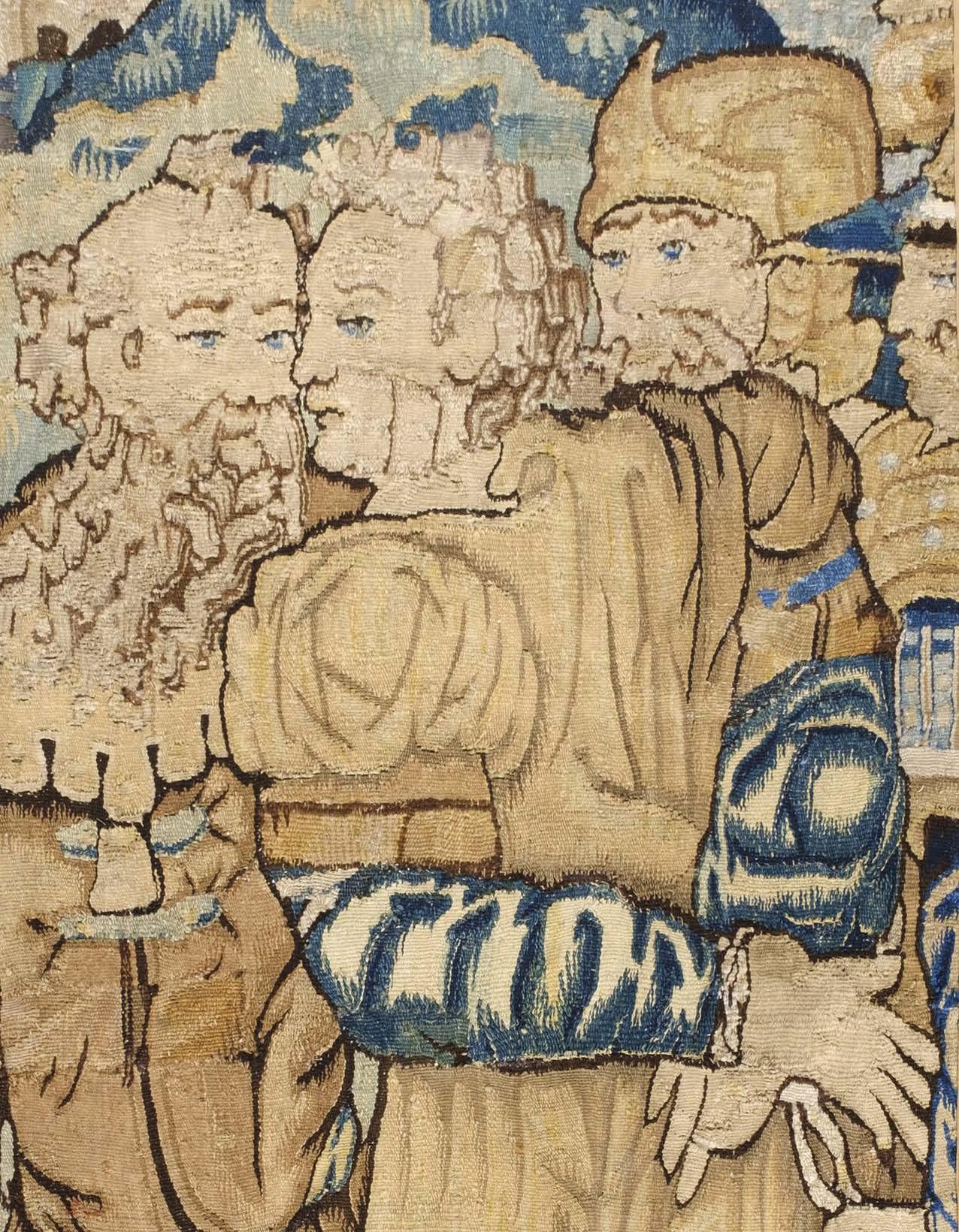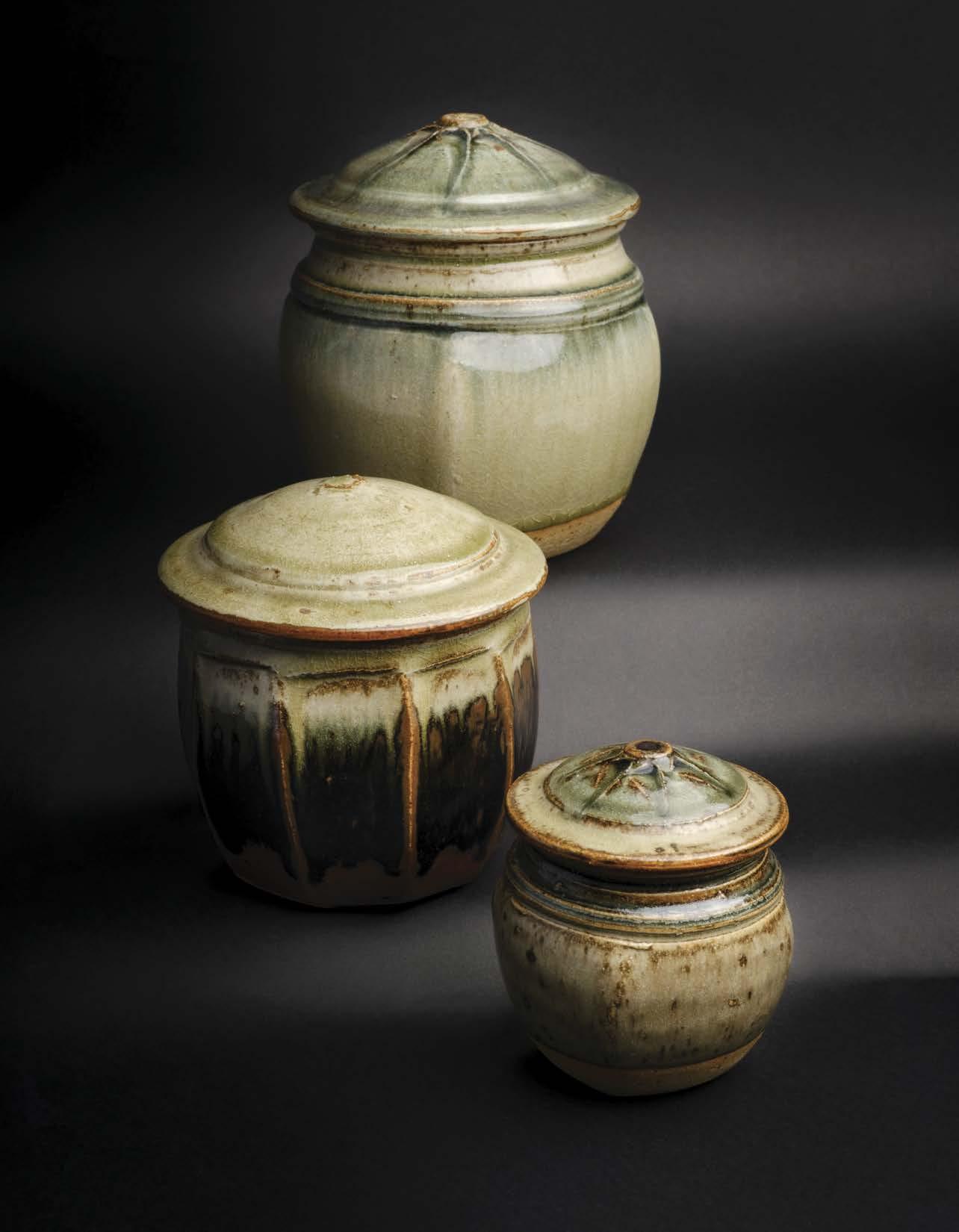




14 March 2024 at 10am
VIEWING
AUCTIONEERS
Nathan Winter
Henry Meadows
Monday & Tuesday 11/12 March 9.30am-5.30pm
Sale mornings from 9am (other times by appointment)
Mallard House, Broadway Lane, South Cerney, Cirencester, Gloucestershire, GL7 5UQ
T: +44 (0) 1285 860006
E: info@dominicwinter.co.uk
www.dominicwinter.co.uk
COMMENCING 10.00 am
VIEWING
Monday/Tuesday 11/12 March 9.30am-5.30pm
Morning of sales from 9am (other times strictly by appointment)
Tel: 01285 860006
info@dominicwinter.co.uk
Condition reports now including video conferencing can be requested in the following ways:
T: +44 (0)1285 860006 | E: info@dominicwinter.co.uk
Via the relevant lot page on our website www.dominicwinter.co.uk
Lots marked with AR next to the lot number may be subject to Droit de Suite.
Droit de Suite is payable on the hammer price of any artwork sold in the lifetime of the artist, or within 70 years of the artist's death. The buyer agrees to pay Dominic Winter Auctioneers Ltd. an amount equal to the resale royalty and we will pay such amount to the artist's collecting agent. Resale royalty applies where the Hammer price is 1,000 Euros or more and the amount cannot be more than 12,500 Euros per lot.
The amount is calculated as follows:
Royalty For the Portion of the Hammer Price (in Euros)
4.00% up to 50,000
3.00% between 50,000.01 and 200,000
1.00% between 200,000.01 and 350,000
0.50% between 350,000.01 and 500,000
Invoices will, as usual, be issued in Pounds Sterling. For the purposes of calculating the resale royalty the Pounds Sterling/Euro rate of exchange will be the European Central Bank reference rate on the day of the sale.
Please refer to the DACS website www.dacs.org.uk and the Artists’ Collecting Society website www.artistscollectingsociety.org for further details.
For payment arrangements please refer to information for buyers at rear of this catalogue. We would kindly request that commission bids are submitted by 9.30am on the morning of sale.
Customers may submit commission bids or request to bid by telephone in the following ways:
T: +44 (0)1285 860006. |. E: info@dominicwinter.co.uk
Via the relevant lot page on our website www.dominicwinter.co.uk
Live online bidding is available on our website www.dominicwinter.co.uk (surcharge of 3% + vat): a live bidding button will appear 30 minutes before the sale commences. Bidding is also available at the-saleroom.com (surcharge of 4.95% + vat) and invaluable.com (surcharge of 3% + vat).
For payment information see our Information for Buyers page at the rear of this catalogue.
For details regarding storage, collection, and delivery please see our Information for Buyers page or contact our office for advice. Successful bidders will not incur storage fees while current government restrictions remain in place.
All lots are offered subject to the Conditions of Sale and Business printed at the back of this catalogue. For full terms and conditions of sale please see our website or contact the auction office. A buyer’s premium of 20% of the hammer price is payable by the buyers of all lots, except those marked with an asterisk, in which case the buyer’s premium is 24%.
Jewellery
Silver
Ceramics & Glass
Studio Pottery
Objets d'Art
Antiquities
Tribal Art
Oriental Works of Art
Fossils & Minerals
The Dr Alison Smith Lean Button Collection
Textiles from The Collection of Peta Smyth
Historic Textiles
Fans



Antiques & Textiles
Henry Meadows BA Hons, MRICS
Susanna Winters MA (History of Art)
Colin Meays BA Hons (Conservation)
Tel: 01285 860006
info@dominicwinter.co.uk

Cover
CBP006075
468-478
479-490
491-508
509-540
541-550
551-555
556-560
561-622
623-638
639-676
677-709
710-785
786-799
Catalogue Produced by Jamm Design 020 7459 4749 | info@jammdesign.co.uk
Photography by
Marc Tielemans – 07710 974000 | marc@tielemans.co.uk
Darren Ball – 07593 024858 | darrenball1989@gmail.com
SPECIALIST STAFFJEWELLERY
To commence at 10am
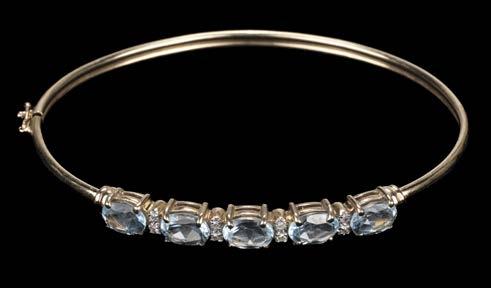

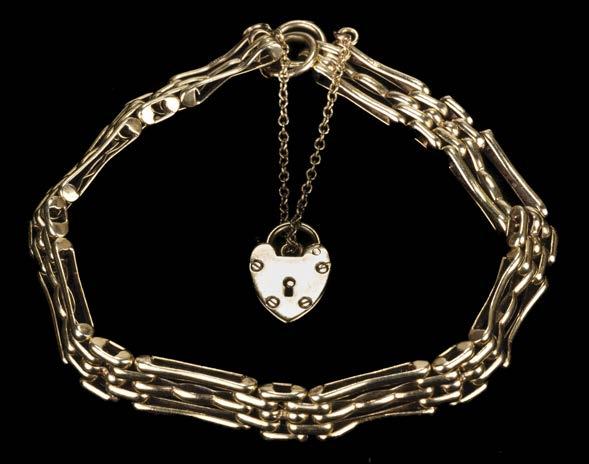
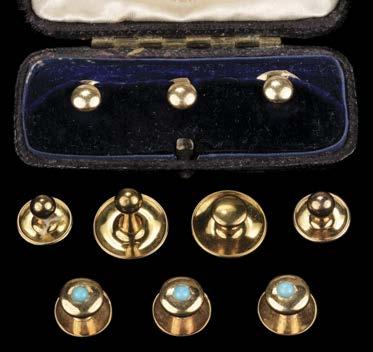

£300 - £400
£150 - £200
Each lot is subject to a Buyer’s Premium of 20% (Lots marked * 24% inclusive of VAT @ 20%)
£200 - £300
£300
 468* Bangle. 9ct gold bangle, set with 5 topaz stones divided by two small diamonds, 6.5 cm across, gross weight 7g, together with a yellow metal gate bracelet set with turquoise and malachite cabachons with pearls formed to fashion leaves, approximately 18 cm long, plus another 9ct gold gate bracelet, approximately 15 cm long, 13.1g (3)
468* Bangle. 9ct gold bangle, set with 5 topaz stones divided by two small diamonds, 6.5 cm across, gross weight 7g, together with a yellow metal gate bracelet set with turquoise and malachite cabachons with pearls formed to fashion leaves, approximately 18 cm long, plus another 9ct gold gate bracelet, approximately 15 cm long, 13.1g (3)
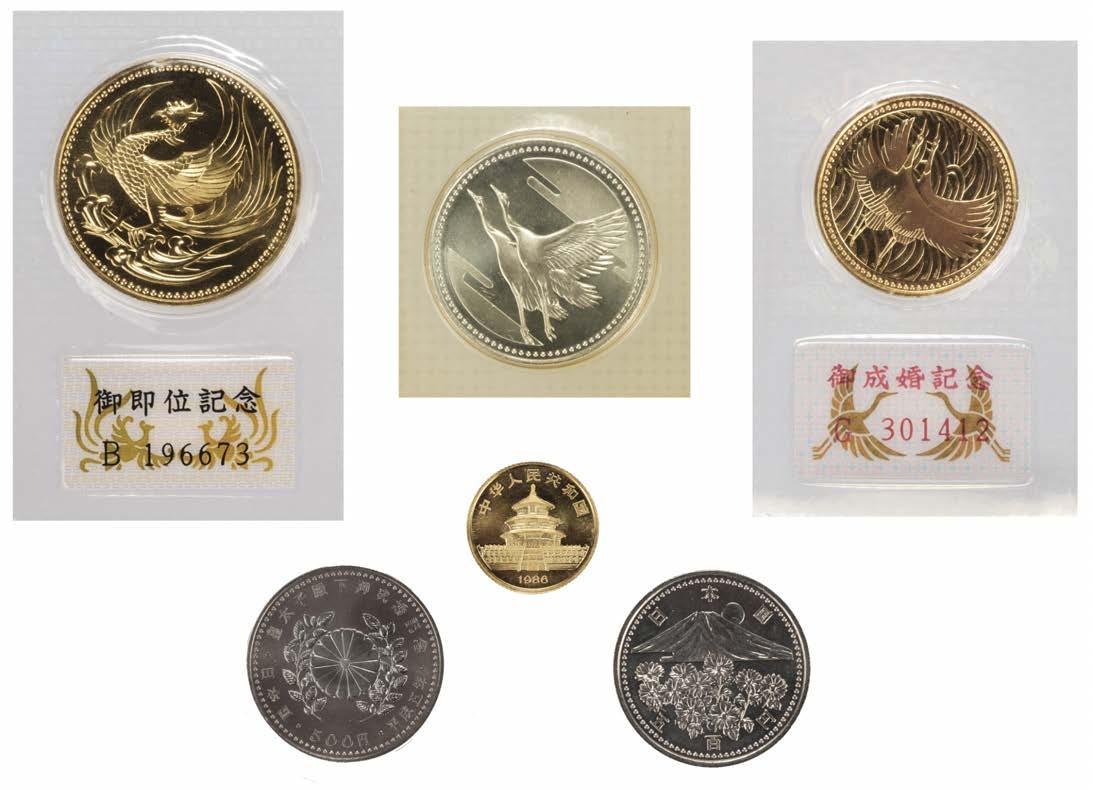
472* Japan. The Wedding of His Royal Highness The Crown Prince, 100,000 Yen, gold commemorative coin, the obverse showing a stylised Pheonix, the reverse Chrysanthemum in wreath surrounded by text, 33 mm diameter, 30 g, together with another gold coin for 50,000 Yen, 27 mm diameter, 18g, each uncirculated and encapsulated in a plastic blister pack with serial number, together with a Chinese 10 Yuan gold Panda coin, 1986, 18 mm diameter, 3.1g, plus three further Japanese coins, contained in a Japanese Ministry of Finance red velvet box (6)
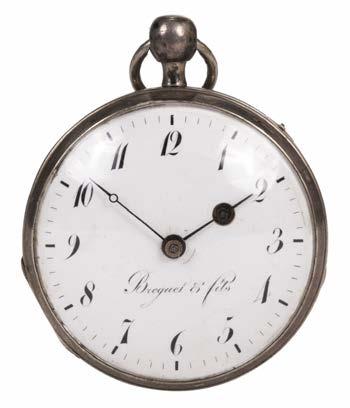

£2,000 - £3,000
473 Pocket Watch. A French repeater and alarm open face pocket watch by Breguet & Fils, circa 1830, the circular white enamel dial signed ‘Breguet & Fils’ with black arabic numerals and single winding hole, the silver case with engine turned backplate, stamped CHFB 37235, with gilt finish movement engraved ‘Breguet & Fils’, case size approximately 55 mm Breguet et Fils was used to sign Breguet Pocket Watches from 1807 to 1833 when Abraham-Louis Breguet took his son as his partner. (1)
£300 - £500
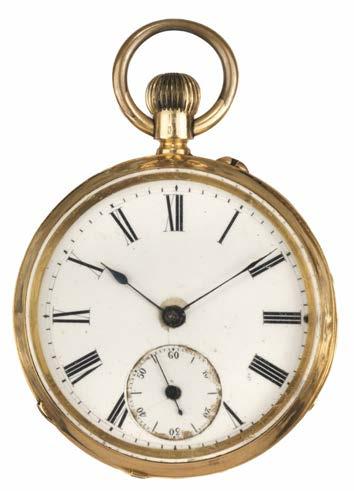

474* Pocket Watch. An Edwardian 18ct gold open face pocket watch, the white enamel dial with black roman numerals, steel hands and subsidiary seconds dial, the case with monogram engraved on the backplate and the inner plate with ‘John Bennett’ maker’s mark, 45 mm diameter, gross weight including movement 80.4g (1)

£500 - £700
£200 - £300
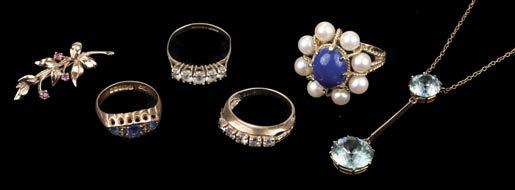
476*
Each lot is subject to a Buyer’s Premium of 20% (Lots marked * 24% inclusive of VAT @ 20%)
£300 - £400
477* Sovereign. Edward VII full gold sovereign, 1912, contained in a 9ct gold mount with 9ct gold watch chain and lobster claw catch, the chain weighs 11.6g, 23 cm long (1)
£400 - £500

478* Tie Pins. A collection of tie pins, including a gold nugget tie pin, 4.7 cm long, 1.3g, plus a Victorian yellow metal mourning brooch, with aperture for a locket of hair, glass damaged, two gilt metal mourning locket pendants and other items (13)
£150 - £200
475* Ring. An art deco 18ct gold and platinum ring circa 1920s, set with large square cut sapphire bordered with small diamonds and sapphire corners, stamped 18ct Plat, size P, gross weight 2.9g (1) Rings. A ladies 14ct gold dress ring, set with a blue stone cabochon surrounded by 8 pearls, stamped ‘14K’, size J, gross weight 8.5g, together with three 9ct gold dress rings including a 9ct gold dress ring, set with 5 CZ stones, stamped ‘375’, size N, gross weight, 2.6g plus a 9ct gold drop pendant necklace, set with two facet light blue stone, the catch stamped 9ct, 26 cm long and a 9ct gold leaf brooch set with three purple stones, 35 mm long (6)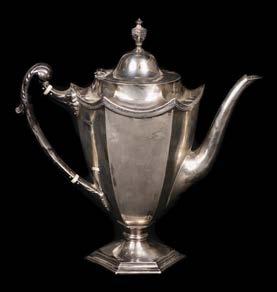
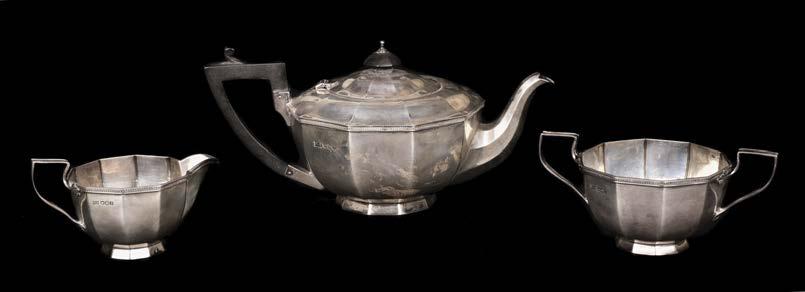
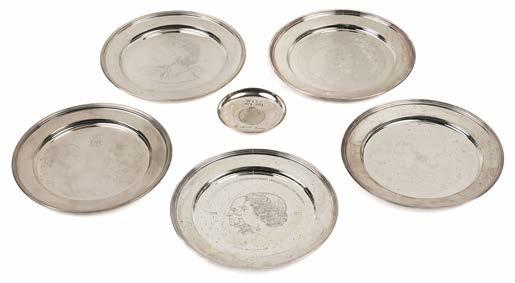
479* Commemorative Plates. A silver commemorative plate by the Library of Imperial History, London 1975, the circular plate made to commemorate the jubilee of the birth of Her Majesty Queen Elizabeth The Queen Mother and engraved with the Queen Mother with the date 4 August 1975, 23 cm diameter, boxed with a certificate, together with four similar silver commemorative plates, all boxed with a certificate, plus a smaller commemorative dish to commemorate the birth of Sir Winston Churchill, inset with a 1965 Churchill crown, 9.8 cm diameter, boxed with a certificate, combined weight approximately 1910g
(5)
£600 - £800
480* Coffee Pot. A George V silver coffee pot by Walker & Hall, Sheffield, 1921, of hexagonal tapered form with urn finial and pedestal foot, the handle with ivory spacers, 27 cm high, overall weight 867g, together with three-piece silver decagon tea service by Walker & Hall, Sheffield 1930, comprising teapot, milk jug and sugar bowl, the teapot with ebonised handle and finial, 26 cm long, overall weight including the handle and finial 784g
Ivory Act registration reference: BLPRABZK. (4)
£200 - £300

481* Icon. A silver travelling icon by Mario Buccellati, circa 1950’s, the small rectangular case with an engraved textured finish, enclosing a glazed silver panel depicting an image of the Madonna and child, additionally engraved with the previous owner and dated ‘Edward Alexander 1 May 1958’, the inner rim engraved with makers mark and numbered 96750, 6 x 5 cm
(1)
£300 - £500
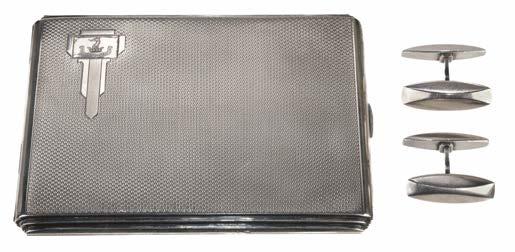
£80 - £120
482* Jensen (Georg). A pair of silver cufflinks, no. 90 designed by Flemming Eskildsen for Georg Jensen, of plain form with maker and silver purity stamps, 15.5g, with original presentation box together with a silver cigarette case by Deakin & Francis Ltd, Birmingham 1939, of rectangular form, 148g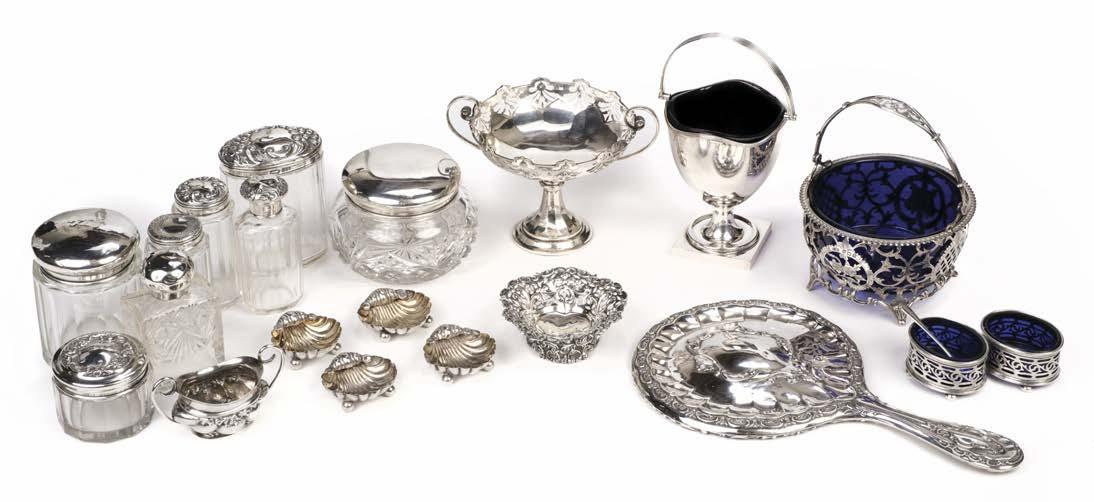
483* Mixed Silver. A silver bon-bon basket with blue glass liner by A Chick & Sons Ltd, London 1974 of bucket form on pedestal base and drop handle, 163g together with a silver bon-bon dish by Gorham Manufacturing Company, Birmingham 1915, of elegant art nouveau form pierced with flowers and leaves and scroll handles on flared pedestal base, 14 cm across, 102g, plus a silver bon-bon basket by E S Barnsley & Co, Birmingham, 1912, foliate pierced with engraved decoration, swing handle and blue glass liner, 11 cm diameter, and other silverware including a pair of oval silver salts each with blue glass liner (one with silver spoon), a collection of glass silver topped dressing table jars, a silver heart dish, silver shell pin trays and other items (21)

£300 - £500

484* Mixed Silver. A silver sugar caster by Barker Brothers, Birmingham 1902, of baluster form with foliate pierced domed cover, 19 cm high, 209g, hallmarks rubbed, together with two smaller sugar casters by JCL, London 1938, 12.3 cm high, 62g and J B Chatterley & Sons Ltd, London 1929, 13 cm high, 65g both of baluster form, plus a sterling silver dish, with monogram to centre, 22.7 cm diameter, 254g (4)
Each lot is subject to a Buyer’s Premium of 20% (Lots marked * 24% inclusive of VAT @ 20%)
£200 - £300
485* Silver Candlesticks. A pair of silver candlesticks designed by Anthony Hawksley for Payne-Oxford, London 1971, of circular plain squat form with a hammered finish and circular base, 6 cm high x 6.5 cm diameter, overall weight approximately 344g (1)
£150 - £200

486* Silver Coffee Set. A silver coffee set designed by Anthony Hawksley for Payne-Oxford, London 1973, of plain form with a hammered finish and a “bark” type detail, comprising baluster coffee pot with a black composite handle and finial on the tapered lid, 23 cm high, a milk jug, 11 cm high and sugar bowl, 9.5 cm diameter, the overall condition is good however, the sugar bowl rim is slightly misshaped, total weight approximately 1020g
(3)
£400 - £600
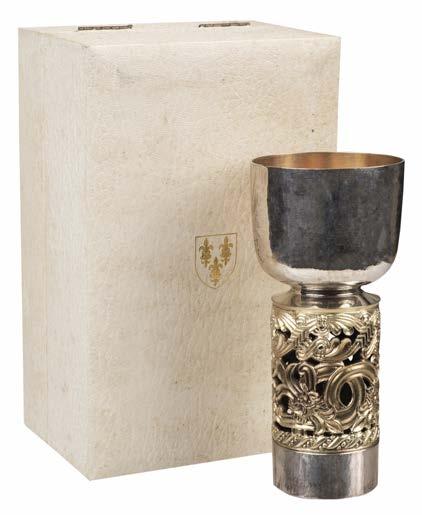

488 Silver Sauce Boat. An Edwardian silver sauce boat, James Dixon & Sons, Sheffield 1902, with gadrooned rim and acanthus flying scroll handle, on three cabriole supports, 16 cm long, 592g, together with a Victorian silver milk jug and sugar bowl, George Jackson and David Fullerton, London 1897, embossed with scrolls, the jug 10 cm long, combined weight of the two items 151g
(3)
£100 - £150

489* Silver Spoons. Four George III silver serving spoons by Solomon Hougham, Solomon Royes & John East Dix, London 1818, of plain form, together with four George III silver serving spoons by William Bateman, London 1814, Thomas Wilkes Barker, London 1808 of plain form with monograms to handles, 49g
(8)

£150 - £200
487* Silver Goblet. Hereford Cathedral silver goblet by John Sutherland Hawes, London 1976, a reproduction of the original made for Aurum Designs, London to commemorate the Thirteenth Century of Hereford Cathedral, numbered 236/676, the cup with a hammered finish and richly gilded bowl, the pieced stem gilded with leopards heads and fleur-de-lys, 16.5 cm high, 329g, boxed with a booklet signed in ink by John Herford, Lord Bishop of Hereford (1)
490* Silver Mug. A Victorian silver mug, Josiah Williams & Co, Exeter, 1875, of baluster form richly engraved with acanthus scrolls and an interlaced monogram within an oval border, the interior gilded with scroll handle, 14.5 cm high 281g
(1)
£200 - £300
£150 - £200
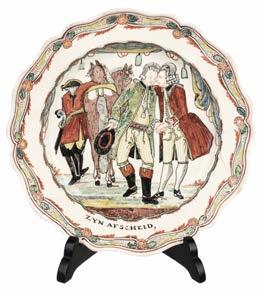
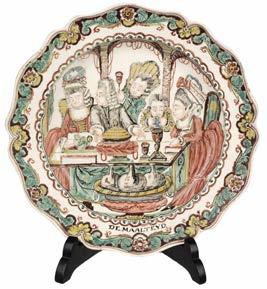
491* Creamware. A matched pair of English creamware plates, late 18th century, each with Dutch decoration and titled in Dutch, ‘Zyn Afscheid (His Ascension) and the other ‘De Maalteyd’ (The Meal) from the story of the Prodigal Son, the first plate damaged, 25 cm diameter
The Parable of the Prodigal Son is one of the parables of Jesus in the Bible and appears in Luke 15:11–32.
In the story, a father has two sons. The younger son asks the father for his inheritance, and the father grants his son’s request. However, the younger son is prodigal (i.e., wasteful and extravagant) and squanders his fortune, eventually becoming destitute. The younger son is forced to return home empty-handed and intends to beg his father to accept him back as a servant. To the son’s surprise, he is not scorned by his father but is welcomed back with celebration and fanfare.
(2)
£200 - £300
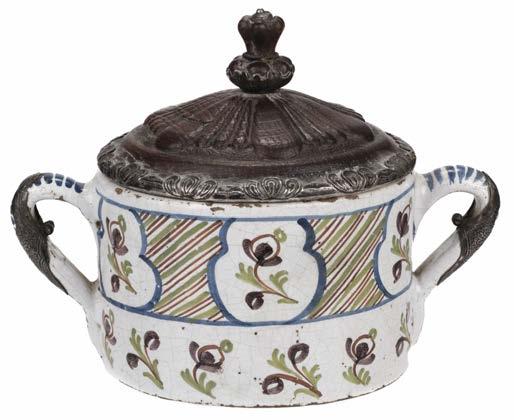
492* Delft Posset Pot. An 18th century Dutch Delft two-handle posset pot with later carved wood cover, with white metal mount and crown finial, the body painted with flowers, and the handles with sympathetic repairs, crazed, 15 cm high, 13 cm diameter
(1)
£100 - £150
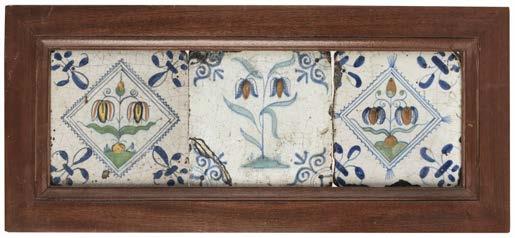
493* Delft Tiles. Dutch delft tiles, 18th century, the central tile polychrome decorated with tulips, flanked by two further tulip decorated tiles each within a lozenge and with blue fleur de lys corners, old damage and crazing, 13 x 13 cm, presented in a modern wooden frame, frame size 21 x 41.5 cm, together with two framed art nouveau pottery tiles, frame sizes, 39 x 39.5 cm and 24.5 x 40 cm
(3)

£100 - £150

494* Delft. A pair of Dutch delft ‘parrot’ plates, mid 18th century, each polychrome decorated with confronting parrot perched on a branch within a geometric border, some loss of glaze and crazing, 23.5 cm diameter
(2)
£300 - £500

495* Glass. George III cut-glass urn and cover, circa 1800, the cover with a facet cut finial, the base similarly cut and raised on a square base pedestal, 20 cm high, together with an oversized George III cut-glass rummer, circa 1820, finely cut on a square base pedestal, 19 cm high x 13.5 cm diameter, plus a huge wine glass or ice container, 19th century, plain form with round foot and rough pontil, 22 cm high x 14.5 cm diameter
(3)
£200 - £300
Each lot is subject to a Buyer’s Premium of 20% (Lots marked * 24% inclusive of VAT @ 20%)


496* India. A collection of ten Indian temple Cauldon porcelain cabinet plates, circa 1920, printed with sepia photographic views, each titled (some rubbed and illegible) including Temple of Dilwara Aloo; Temple of Sivanni Narrain Ahmedabad; Ahmedabad; Hootal Minar Delhi; Musjid of Isak Khan Lahore; Taj Mahal Delhi (hairline), together with three similar comprising Malabar Hill Bombay, Camp Stalwari Kandesh (small chip to the rim), Karndeish Tiger, all with a blue and gilt scroll border, plus four further plates printed with similar views and all with a gilt border, printed and painted marks to base, 22.5 cm diameter (17)
£150 - £200
497* Maiolica. A Spanish Puente del Arzobispo maiolica dish, 16th century [?], polychrome decorated with a hare amongst flowers with a green border, restored, 22 cm diameter, an old manuscript label to the base inscribed ‘Puente del Arzobispo Spanish 16th cent’ (1)
£100 - £150
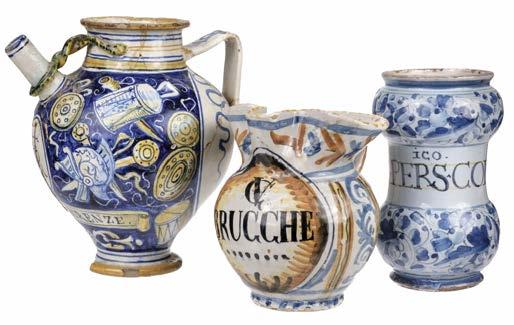
498* Maiolica. An Italian maiolica pottery drug jar, probably 18th century, of shaped form, decorated in a two-tone blue with the inscription ‘Fior D Pers Cons’, 18 cm high, together with a maiolica wet drug jar, inscribed ‘Certos Di Firenze’, 23 cm high, extensive damage, plus a small Italian jug, 16 cm high (3)
£200 - £300
499* Majolica. A Victorian majolica camel by George Jones, circa 1870, the saddle hung with a turquoise basket on each side and standing on a palm leaf decorated oval base, impressed mark to base, 24 cm high (1)

£300 - £500
500* Majolica. A Victorian George Jones majolica spoon warmer, circa 1875, modelled in the form of an upturned shell on rocky base, 15 cm high (1)

£200 - £300

501* Majolica. A Victorian Minton majolica spill vase, modelled as a hen by John Henk, 1876, the hen standing beside a large open basket, on an oval base applied with leaves, inscribed ‘J Henk’, impressed factory marks to base, 34 cm high (damaged) together with a majolica wall pocket, female mask surrounded by scrolling foliage, 36 cm high (2)
£200 - £300
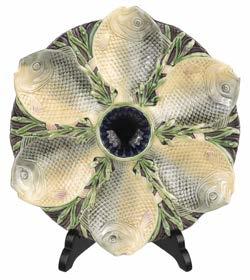

502* Majolica. A Victorian Minton majolica pottery fish or poisson dish, 1881, moulded with fish around a central blue glaze, impressed marks to base including registration mark, 28 cm diameter, together with a George Jones majolica pottery oyster dish, 1874, eight integral dishes surrounded by seaweed with oyster shell surmount, impressed marks to base, 25.5 cm diameter (2)
504* Commemorative Pottery. A commemorative earthenware jug circa 1821, with a copper and pink lustre decoration, printed in black with a half profile of Queen Caroline and printed on the opposite side with the seven lines of the ‘Green Bag’ rhyme within a foliate border entwined with a ribbon detailing her supporters, crazed and a small hairline near the spout,15 cm high, together with a similar Queen Caroline memorial pottery jug, one side printed in black ‘To the Memory of Queen Caroline’ the opposite side with ten line verse ‘Britton’s in sackcloth on their own shore lament. Queen Caroline’s no more ...’, spout restored, 15 cm high, a pearlware blue and white transfer plate, circa 1820, profile of Queen Caroline facing left, floral encrusted border, impressed crown mark to base, 21.5 cm diameter, a rococo porcelain candlestand probably Derby, 18th century, 24 cm high plus a George III period canary yellow pottery commemorative jug, printed with a profile of Sir Francis Burdett facing right, with two line verse ‘The determined enemy of corruption & the constitutional friend of his Sovereign’, the opposite side with nine line description of Burdett being committed to the Tower on 6 April 1810’, black lined border, some wear commensurate with age and small chip to spout and foot rim, 10 cm high
£150 - £200

£100 - £150
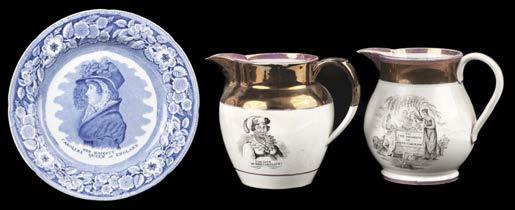
Each
£100 - £150
Sir Francis Burdett, 5th Baronet (1770-1844), was a politician and member of parliament who gained notoriety as a proponent of universal male suffrage, equal electoral districts, vote by ballot, and annual parliaments. His commitment to reform resulted in legal proceedings and brief confinement to the Tower of London. (5)

505* Studio Pottery. An impressive studio pottery stoneware vase by Fumihiro Fuyushiba of the Rokou Kiln, Japan, the large tapered vase with four lugs to the neck and the body with red and black fern decoration on an unglazed terracotta ground, impressed and incised marks to base, 51.5 cm high, with accompanying paperwork and wooden blocks signed by the potter, together with a dish by the same potter, the border decorated with a gold band of flowers on white ground, artists mark to base, 25.5 cm diameter
Fumihiro Fuyushiba was born in 1948, after graduating from Kanazawa University of Fine Arts and Crafts in 1971 he then worked as a ceramics designer for Mikasa. In 1979 he exhibited and won awards at the Exhibition of Japanese Contemporary Art. Thereafter, exhibiting in Japan, United States and more recently in Penrith, Cumbria in 2001.
(2)
£200 - £300
503* Parian figure. A Parian ware figure of John Milton, 19th century, after the model by John Cheere, modelled standing on a plinth leaning on a stack of books holding a scroll, 36.5 cm high. (1) Lot 504
506* Studio Pottery. An ovoid pottery vase and cover by Mieke Selleslagh (1954 -), of ovoid form with a traditional Japanese raku glaze, the base with incised signature, 24 cm high Mieke Selleslagh is a Belgium potter. An information sheet is included with the lot.
(1)
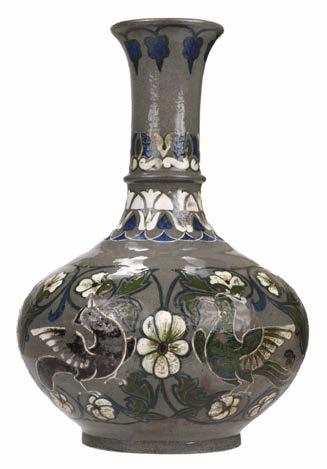
£100 - £150
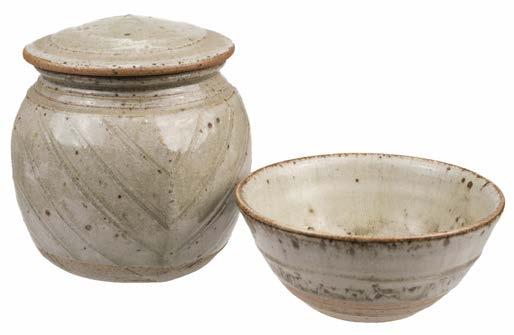
509AR* Batterham (Richard, 1936-2021). A beaten stoneware caddy and cover, covered in an ash glaze, with incised diagonal lines to each side, unsigned, ‘14’ glaze code in black to base, 17.2 cm high, with a handwritten note detailing original purchase ‘Oxford Gallery c. 1981’ and a cutting from The Telegraph Weekend Magazine of an article on Richard Batterham’s work, together with a small stoneware dessert bowl by the same potter, circa 2009, covered in a light green ash glaze, chatter band to exterior, unsigned, attribution and purchase date label to base, 13.5 cm in diameter, 6 cm high
Caddy and cover purchased from Oxford Gallery, circa 1981.
Literature: a similar dessert bowl (No. 33) is listed in Richard Batterham, Studio Potter by Tanya Harrod and Sarah Griffin, V&A Publishing (2022). (2)
£200 - £300
507* Vase. A Bombay School of Art vase, of baluster form with green, white and blue enamelled flowers and bird decoration, stamped to base (W J ...) n.59 20.7.88 A.S.N., 19.5 cm high (1)
£200 - £300
508* Wedgwood. Eric Ravilious for Wedgwood, a part dinner service in the Garden pattern, circa 1950, decorated with various printed garden scenes within a graduated yellow band and black border, comprising 7 twin handled soup bowls, with 9 accompanying saucers (2 chipped), 28 plates of various sizes largest 25.5 cm diameter, smallest 17.7 cm diameter, 8 side plates 13 cm diameter, a tureen with cover (damaged), 22.5 cm diameter, printed and impressed factory marks, overall poor condition with much damage
(53)
£200 - £300
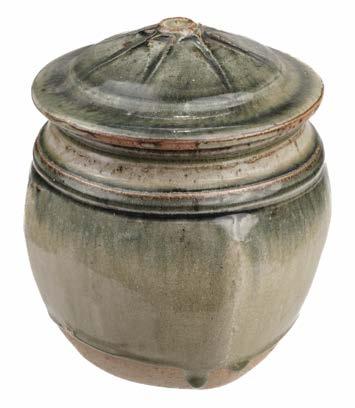
510AR* Batterham (Richard, 1936-2021). A beaten stoneware caddy and cover, covered in an ash glaze with cobalt, unsigned, ‘8.3’ glaze code in black to base, with additional attribution and purchase date label, 17.2 cm high (1)
£200 - £300

511AR* Batterham (Richard, 1936-2021). A cut sided stoneware caddy and cover, tenmoku with green ash glaze, unsigned, 15 cm high
Purchased directly from the potter in 2012.
(1)
£200 - £300
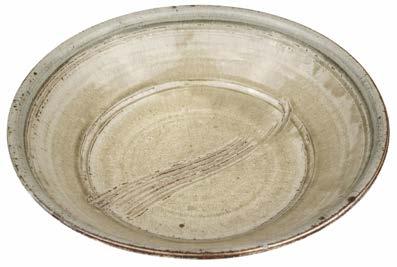
512AR* Batterham (Richard, 1936-2021). A large stoneware fruit dish, covered in a green ash glaze, incised comb decoration to interior, chatter band to exterior, unsigned, indistinct glaze code in black to base, with additional attribution and purchase date label, 40.3 cm diameter
Purchased directly from the potter in 2012.
Literature: a similar fruit dish (No. 100) is listed in Richard Batterham, Studio Potter by Tanya Harrod and Sarah Griffin, V&A Publishing (2022).
(1)

£300 - £500
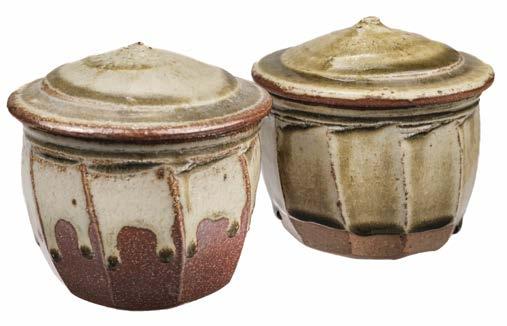
514AR* Batterham (Richard, 1936-2021). A small cut sided stoneware jar and cover, covered in a green ash glaze, unsigned, attribution and purchase date label to inside of lid, 10 cm high, together with a cut sided salt-glazed stoneware jar and cover by the same potter, the top half with a green ash glaze, unsigned, attribution and purchase date label to inside of lid, 10 cm high
Both purchased directly from the potter.
(2)
£100 - £150

515AR* Batterham (Richard, 1936-2021). A stoneware lidded coffee pot, covered in a green ash glaze, with chatter band to the exterior, unsigned, black glaze code ‘1’ to base of pot and underside of lid, 14.5 cm tall, together with a smaller stoneware jug by the same potter, green ash glaze, with repeated incised decoration to exterior, unsigned, 11.5 cm high, with original receipt when purchased from the V&A Craft Shop in March 1983
The jug was purchased from the V&A Craft Shop, March 1983.
(2)
£150 - £200
513AR* Batterham (Richard, 1936-2021). A small beaten stoneware caddy and cover, covered in an ash glaze with cobalt, banding to the shoulders, unsigned, attribution and purchase date label to inside of cover, approx. 11.5 cm high
(1)
Each lot is subject to a Buyer’s Premium of 20% (Lots marked * 24% inclusive of VAT @ 20%)
£100 - £150
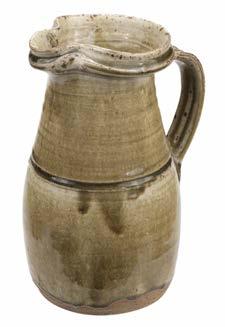
516AR* Batterham (Richard, 1936-2021). A stoneware jug, covered in a green ash glaze, unsigned, indistinct black glaze mark to base, attribution and purchase date label to base, 22 cm high
(1)
£150 - £200

517AR* Bayer (Svend, 1946 -). A large stoneware coffee pot and cover, of ovoid form decorated with an abstract design on an ash gorund, seal marks to base and remains of an old label, 26 cm high
Provenance: Purchased from Darlington in 2009.
(1)
£100 - £150
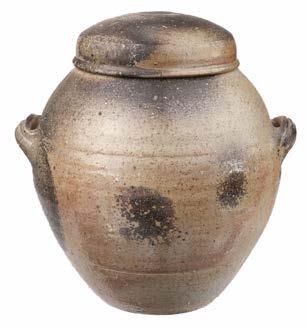
518AR* Bayer (Svend, 1946 -). A large stoneware wood-fired twin handled storage jar and cover, partially covered in an ash glaze with feldspar inclusions, unsigned, 31 cm high (1)

£150 - £200
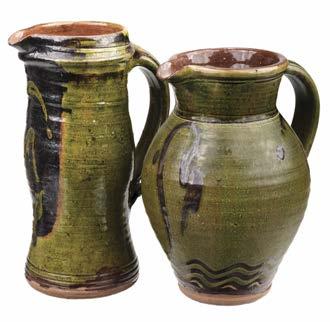
519AR* Bowen (Clive, 1943 -). A bellied earthenware jug, slip decorated with a simple grass motif in green, on a chestnut brown and green ground, unsigned, 22 cm high, plus another slipware jug by the same potter, shouldered form, with slip and comb decoration on a green ground, unsigned, 20 cm high
(2)
£100 - £150

520AR* Bowen (Clive, 1943 -). A tall lidded earthenware storage jar circa 2013, slip decorated with simple brush motif on various shades of green, brown and yellow ground, unsigned, 32 cm high, together with a small lidded earthenware jar by the same potter, with slip and comb decoration on a yellow ground, unsigned, 16cm high
Small lidded pot bought from Dartington Trading Company in 2010.
(2)
£150 - £200

521AR* Bowen (Clive, 1943 -). An earthenware charger, covered in dark iron brown and yellow glazes, with trailed slip decoration to the interior and exterior, unsigned, 37 cm diameter
(1)
£150 - £200
522AR* Bowen (Clive, 1943 -). An earthenware footed bowl, mustard, chestnut brown and green glazes with slip and comb decoration, unsigned, attribution and date label to base,18 cm diameter, together with three earthenware slip decorated plates by the same potter, all unsigned, the largest 27 cm diameter
(4)
£100 - £150
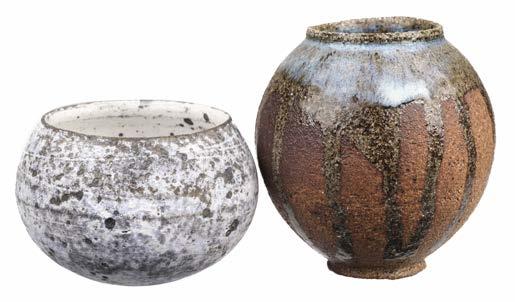
525AR* Cardew (Seth, 1934-2016) at Wenford Bridge. A stoneware plate, brushwork decoration to the rim with a bird and foliage to the well, over an off-white ground, impressed ‘SC’ and pottery seal to base, 27 cm diameter
Seth Cardew was the eldest son of the famous potter Michael Cardew (who set up Wenford Bridge pottery in 1949) and brother of the composer Cornelius Cardew. He studied at Chelsea School of Art and at Camberwell School of Art. He took over Wenford Bridge Pottery following his father’s death in 1983.
(1)
£150 - £200
523AR* Buick (Adam, 1978 -). A stoneware miniature moon jar, running nuka ash glaze, impressed ‘AB’ mark to base, 9.5 cm high, together with a small collared stoneware bowl in the manner of Stephanie Black, covered in dry slip and sponged glaze, impressed mark to base, 6.5 cm high (2)
£100 - £150
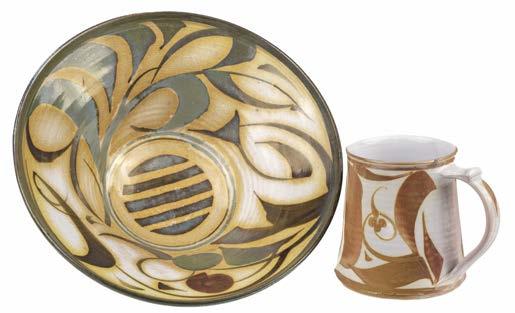

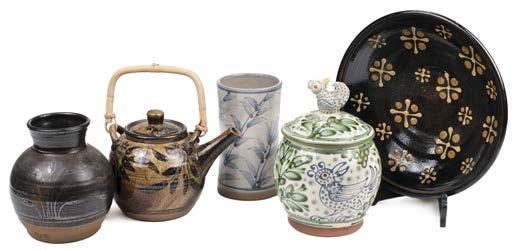
526* Dick (Peter, 1936-2012) at Coxwold Pottery. A collection of studio pottery, including a stoneware teapot with cane handle, foliate and floral decoration on a chestnut brown and mustard glaze, impressed personal and pottery seal, 24 cm high (including handle), and a stoneware serving bowl with dark brown glaze, repeated stylised slip decoration to the interior in yellow, impressed personal and pottery seal to base, 31 cm diameter, plus a cylindrical waisted stoneware vase, speckled grey glaze with foliate decoration in blue, impressed personal and pottery seal, 20 cm high, together with a swollen stoneware vase, 18.5 cm high, and a colourful slip decorated storage jar, 24 cm high, both with impressed seals
(5)
£150 - £200
524* Caiger-Smith MBE (Alan, 1930-2020) for Aldermaston Pottery. A yellow lustre bowl, tin-glazed earthenware decorated in a yellow and gold lustre abstract design, various marks to base including artist monogram and symbol for 2006, overall condition is good with no sign of damage or restoration, 28.2 cm diameter, together with a Caiger-Smith mug, circa 1981, decorated in a similar style, 11.2 cm high, the latter with original receipt when purchased from Oxford Gallery in 1981 (2)
£150 - £200


527* Finch (Ray, 1914-2012) for Winchcombe Pottery. A green pottery bowl, with a green incised glaze and seal marks to base, 21 cm diameter, together with another Winchcombe Pottery bowl by Ray Finch, with seal mark to base, 24 cm diameter, plus a Winchcombe Pottery jug, small chips to the spout, 17 cm high
(3)
£100 - £150
Lot 525
528* Garland (David, 1941 -). A terracotta earthenware footed serving bowl, covered in an off-white glaze, with brushwork decoration in blue, splatter marks in black and areas of sgraffito, painted ‘Garland’ to base, 21.5 cm diameter, together with five terracotta earthenware cereal bowls by the same potter, all with off-white glaze, decorated with abstract brushwork in blue, two with foliate designs heightened with sgraffito, all with painted ‘Garland’ or ‘G’ to base, the largest 14 cm diameter

530* Garland (David, 1941 -). Five terracotta earthenware mugs, three wide-brimmed mugs with an off-white glaze, various abstract decorations in blue, each with an impressed ‘DG’ mark, the largest 13.5 cm diameter, together with two smaller mugs, blue abstract slip decoration on an off-white ground, each painted ‘Garland’ to base, the largest 10 cm diameter
(5)
£80 - £120
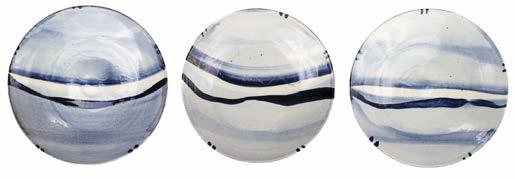
£100 - £150
The potter David Garland lives and works in Gloucestershire. His solo exhibitions include the Redfern Gallery, the Crafts Council and the Besson Gallery, among others, and in New York with Kate Ganz. Four works by Garland feature in the celebrated studio pottery collection of William Alfred Ismay (1910-2001), now held in the care of the York Museums Trust. (6)
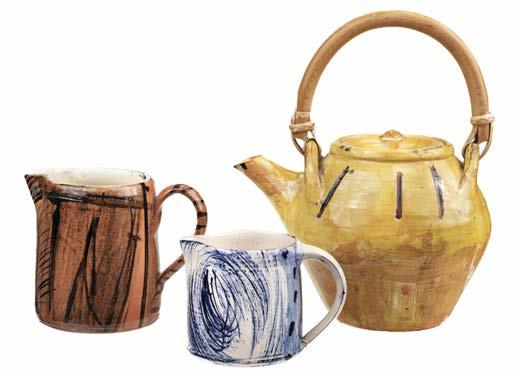
531* Garland (David, 1941 -). Six terracotta earthenware plates, three uniformly sized supper plates covered in an off-white glaze, with brush and slip decoration in shades of blue, areas of sgraffito, glaze run to the exteriors, two painted ‘Garland’ to base, one unsigned, all approx. 23 cm diameter, together with three larger earthenware plates by the same potter, each with abstract brushwork, slip, foliate or sgraffito decoration, all three signed to base, the largest 29 cm diameter
(6)
£150 - £200
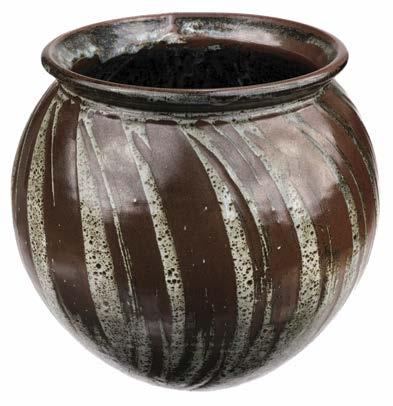
£150 - £200
529* Garland (David, 1941 -). A terracotta earthenware teapot with cane handle, 2009, covered in yellow and orange glaze, vertical sgraffito lines with black slip to the upper half, some deliberate spots of red glaze to the body, additional black slip decoration to the lid and spout, painted ‘Garland ‘09’ to base, 26 cm tall (including handle), together with an earthenware jug by the same potter, 1997, abstract sgraffito and slip decoration on an orange ground, painted ‘Garland 97’ to base, with additional incised glaze details to base ‘1/2 Tom / 1/2 klin to slip’, 12 cm high, plus a smaller jug by the same potter, an off-white glaze with blue abstract decoration, impressed ‘DG’ mark to underside, 8.5 cm high (3)
532AR* Leach (John, 1939 -) for Muchelney Pottery. A large stoneware vase, swollen form with collar rim, nuka glaze with abstract wax-resist decoration, impressed marks to base, 28.5 cm high (1)
£150 - £200
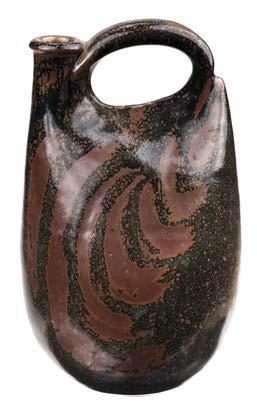
533AR* Leach (John, 1939 -) for Muchelney Pottery. A stoneware cider flagon, 2007, of sack form with loop handle, tenmoku with wax resist decoration, impressed ‘JHL’ seal and pottery stamp and date to base, 26 cm high
(1)
535* Lloyd-Jones (David, 1928-1994). A large stoneware charger, covered in a speckled grey glaze with blue rim and repeated waxresist decoration, similar decoration to the underside, impressed seal to base, 46.5 cm diameter, together with a smaller stoneware footed bowl by the same potter, with a speckled grey glaze and blue interior with wax-resist pattern, 18.5 cm diameter
(2)
£150 - £200

£100 - £150
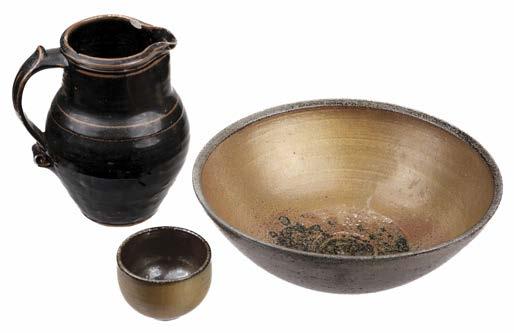
534* Leach Pottery. A Leach Pottery ‘extra large’ soda glazed stoneware bowl, with ocre glaze to the interior, impressed pottery seal, possibly made by Ian Morrison (of Knighton Mill) during his time at the Leach Pottery, 30 cm diameter, together with a small soda glazed stoneware bowl with impressed seal mark, 8 cm diameter, plus a stoneware jug with a dark tenmoku glaze, impressed seal, chips to top of rim, 20 cm high (3)
£100 - £150

Each lot is subject to a Buyer’s Premium of 20% (Lots marked * 24% inclusive of VAT @ 20%)
536* McGowen (Laurence, 1942 - ) for Aldermaston Pottery. A stoneware dish, decorated with red tulips with two-tone green leaves on a cream ground, the base similarly decorated with artists monogram and date mark for 2003, 27.5 cm diameter, together with two similar bowls by the same potter, one with date mark for 2003 the other 2006, both 18 cm diameter (3)
£150 - £200
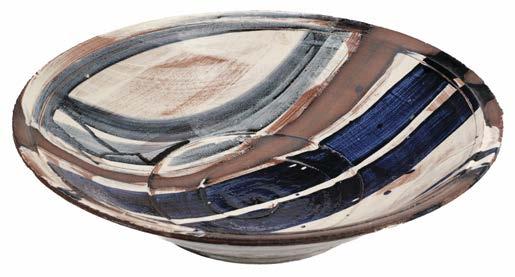
537* Studio Pottery. A collection of bowls, including a large terracotta dish by Richard Phethean (1953 -), coarse-textured red earthenware clay with brushed slip, wax-resist and sgraffito decoration in white and blues to interior and exterior, painted ‘RP’ mark to base, 43 cm diameter, together with a footed stoneware bowl by David Reeves, covered all over in various shades of blue with wax-resist decoration and images of fish and crabs to the interior, painted ‘DR 98’ to base, 33 cm diameter, plus two further bowls, a large unsigned tin-glazed stoneware bowl, 38 cm diameter, and a smaller bowl by Victoria Walton, 20 cm diameter (4)
£150 - £200
Lot 535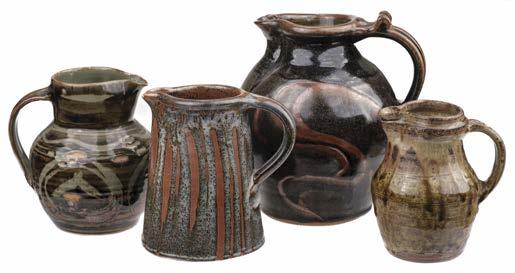
538* Studio Pottery. A collection of jugs, including a stoneware jug by Mike Dodd (1943 -), covered in a green ash glaze, incised decoration to the exterior, impressed seal mark to base, 15 cm high, plus a John Leach (1939 -) for Muchelney Pottery stoneware jug, nuka glaze with vertical wax-resist decoration, impressed marks to base, 17 cm high, with a Nic Harrison stoneware jug, tenmoku glaze with abstract wax-resist decoration, potter’s mark and label to base, 22 cm high, together with a further jug by Harry Davis (for Crowan Pottery)
(4)
£100 - £150

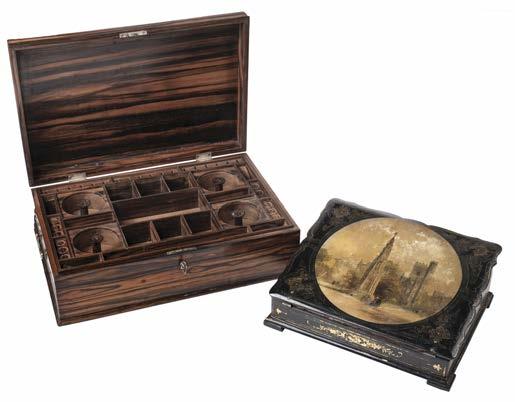
541* Boxes. A Victorian papier mache writing slope by Spiers & Sons, Oxford, the top with a large painted image of St Martyrs’ Memorial Oxford on a black ground with gold detail, the hinged lid enclosing red velvet fall and divisional interior, the base with location and makers marks and additionally inscribed 1928 s.n., 10.5 cm high x 32 cm wide x 27 cm, together with an Anglo-Indian coromandel work/sewing box, circa 1890, of rectangular form with lift out with four spool [?] holders and multi divisions, the sides with brass carrying handles, and the lock with key, 14.5 cm high x 44 cm wide x 29 cm deep
(2)
£150 - £200
539* Studio Pottery. A mixed collection, including a faceted cut sided vase by Nick Rees (1949 -) at Muchelney Pottery, covered in a dark blue glaze, impressed personal and pottery marks to base, 13.5 cm high, plus a stoneware coffee pot by Hassan Lapai for Abuja Pottery, blue brushwork decoration over a speckled grey glaze, impressed personal seal to base, 22 cm high, together with a small stoneware honey pot by Sid Tustin at Winchcombe Pottery, plus pieces by David Lloyd-Jones, Chris Keenan, Amanda Brier and Louise Darby, and some further unsigned work (11)
£150 - £200
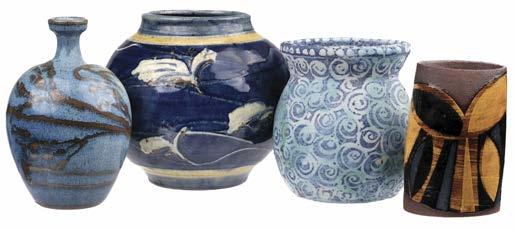
542* Campaign Furniture. A mahogany drinks cabinet, mid 19th century, the top with recessed brass hinges and when opened a tray is raised housing 6 cut glass decanters, 24 cm largest, 22 cm smallest (one with replacement stopper and another stuck in the bottle), the cabinet with dummy cabinet doors and a drawer beneath lined with green baize and with 7 enamel bottle labels (poor condition), raised on four tapered supports united by ‘X’ stretcher, 92 cm high x 50.5 cm wide x 45 cm deep
(1)
£200 - £300
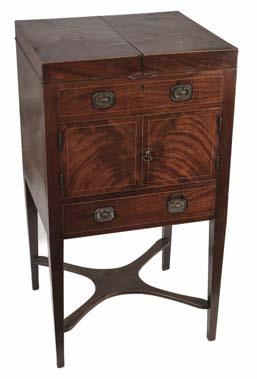
540* Studio Pottery. A mixed collection, including a terracotta earthenware oval vessel by Richard Phethean (1953 -), honey and transparent glazes, decorated with slip, painted ‘RP’ mark to base, 14.5 cm high, together with a hand-built vase by David Reeves, decorated with repeated swirling patterns in blue over a white ground, painted ‘DR 97’ mark to base, 17 cm high, plus an unattributed narrow-necked stoneware vase, with abstract waxresist decoration, impressed spiral mark to base, 19 cm high, and a moon jar with painted ‘JF’ mark, 18.5 cm high (4)
£100 - £150

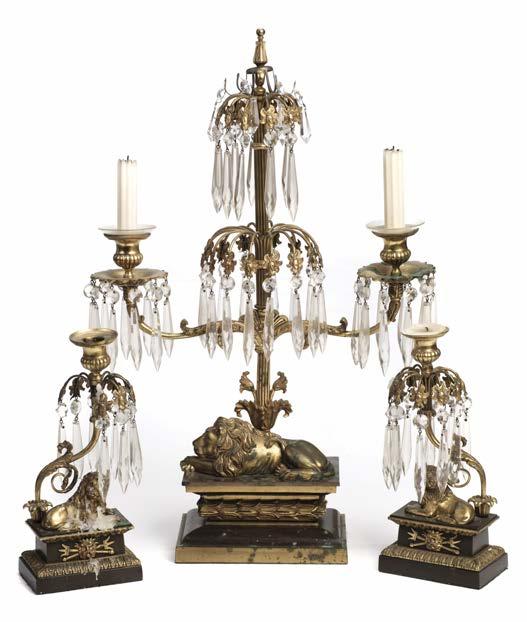
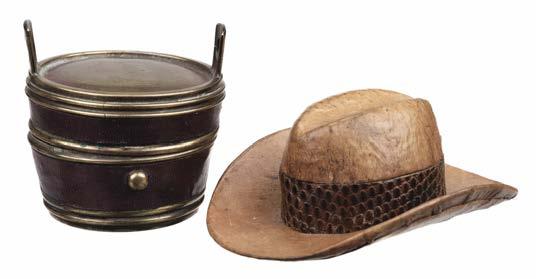
545* Inkwell. Novelty inkwells, comprising a brass and leather inkwell in the form of a pail, with two raised carrying handles, coopered with leather, the hinged lid enclosing an anchor crest and glass ink bottle, 6 cm diameter, together with a stetson inkwell, covered in leather with snakeskin band, the hinged lid enclosing glass ink bottle, 10.5 cm long (2)
£200 - £300
543* Candelabras. A set of three Regency style gilt metal and bronze chandelier candelabras, bases with recumbent lions, cast metal branches with cut glass lustres, the tallest 60 cm high, the smallest 27 cm high (3)

£200 - £300
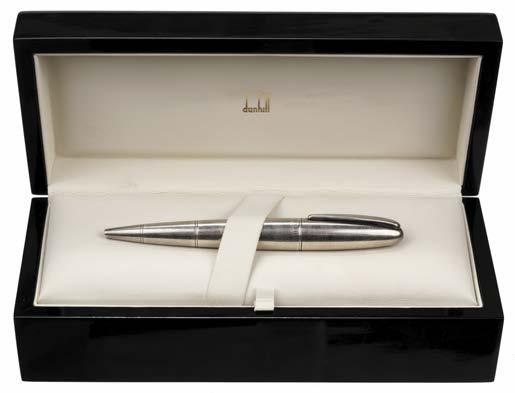
546* Luxury Pens. An Alfred Dunhill silver ‘Torpedo’ ballpoint pen, in the original fitted lacquered case with calf-skin leather interior, carton, information booklet, silver polishing cloth, and refills, together with 5 other luxury pens including Waterman, Pininfarina and Montegrappa, mostly in original boxes (6)
£150 - £200
547* Mirror. An Edwardian gilt moulded mirror, the elaborately carved frame with foliate and scroll decoration, the lower section with a shelf for display, 117 x 70 cm (1)
£200 - £300
544* Firescreen. A Victorian Aesthetic period firesecreen, the brass frame with stained glass panel with central panel decorated with a bird of prey, 96 cm high x 58 cm wide (1)
Each lot is subject to a Buyer’s Premium of 20% (Lots marked * 24% inclusive of VAT @ 20%)
£200 - £300

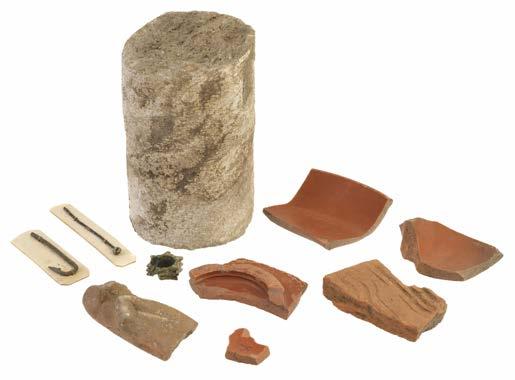
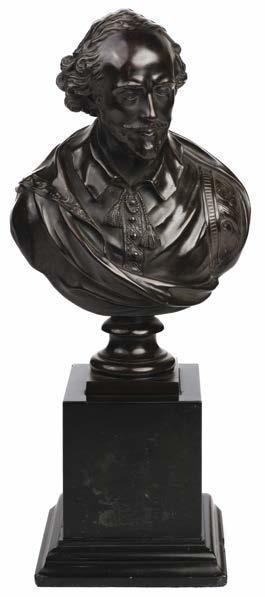
£200 - £300
548* Mouseman. Robert “Mouseman” Thompson of Kilburn (18761955) oak bookends, carved in the traditional style with a mouse on each, 15 cm high (1)
551* Antiquities. A collection of antiquities, comprising an Ancient Roman iron stylus, of elongated form with a point for scratching into wax, 11.5 cm long (purchased June 1939 from Crest Private Museum, Hemel Hempstead.); Ancient Roman bronze hairpin with globular top 6.6 cm long (excavated at Cannon Street, London. Purchased June 1939 from Crest Private Museum, Hemel Hempstead.); Ancient Roman bronze ridged ring which would have formed part of a horse’s harness, 2.6 cm diameter; Ancient bronze fishhook, 6 cm long (found at Gravesend, ex-Arnold Museum (?). Purchased June 1939 from Crest Private Museum, Hemel Hempstead.); two flint arrowheads, 6 cm and 3 cm long (one found in Hailsham? Purchased June 1939 from Crest Private Museum, Hemel Hempstead.); section of column from a demolished ancient shrine, Sicily, the circular stone measuring 14.5 cm (acquired at the original site at the time of the discovery and demolition in 1966); two terracotta fragments; Ancient terracotta lamp, 9 cm long (purchased in Turkey in the 1960s.); fragment from an Ancient vase from south Italy, painted pottery, 9.5 cm, broken and crudely repaired; fragments of Samian ware and miscellaneous Roman sherds from Ratae Coritanorum (ex New Walk Museum, Leicester. Acquired April 1939.), many of these pieces with a typed paper slip stating provenance
Provenance: Private collection, Bristol, UK. (1)
£200 - £300
549* Roubiliac (Louis-François, 1702-62). Bust of William Shakespeare after Roubiliac, bronze, Barbedienne Foundry, circa 1870, foundry stamp to verso, 28 cm high, mounted on a black slate base, overall height 41 cm (1)
£600 - £800
550* Russell (Gordon). An oak sewing machine cabinet, circa 1930s, the hinged lid enclosing a Singer sewing machine with Siemens electric motor, the cabinet raised on four tapered supports with metal casters, 78 cm high x 55 cm wide x 39.5 cm deep Although this piece is unstamped and has no identifiable markings there are characteristics which are very much in line with the Gordon Russell factory. Therefore, the piece remains unattributed and worthy of further research.
(1)
£70 - £100
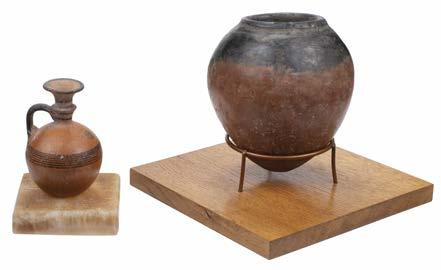
552* Cypriote Juglet. A terracotta juglet circa 800-600 B.C., the ovoid body painted with black rings, and handle, neck and rim, an additional black roundel to the body, chip to the rim, 9 cm high, presented on a later alabaster base, together with an ovoid twotone pottery vessel, 15 cm high, presented in a perspex display case
Provenance: Private collection, Bristol, U.K.
The first has a type slip stating the juglet was purchased in June 1939 from Crest Private Museum, Hemel Hempstead.
£200 - £300
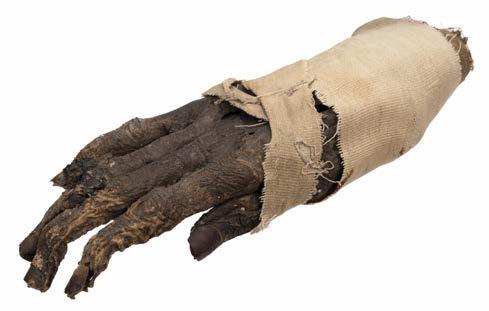

Provenance: Private collection, Bristol, U.K.
Acquired in Egypt in the 1940s by Leslie Valentine Grinsell, OBE, FSA (190795), archaeologist and museum curator of archaeology at the Bristol City Museum. Grinsell gave this piece to Brian Davies, a Bristol undertaker in the 1970s and thereafter found its way into the current private collection.
£1,500 - £2,000
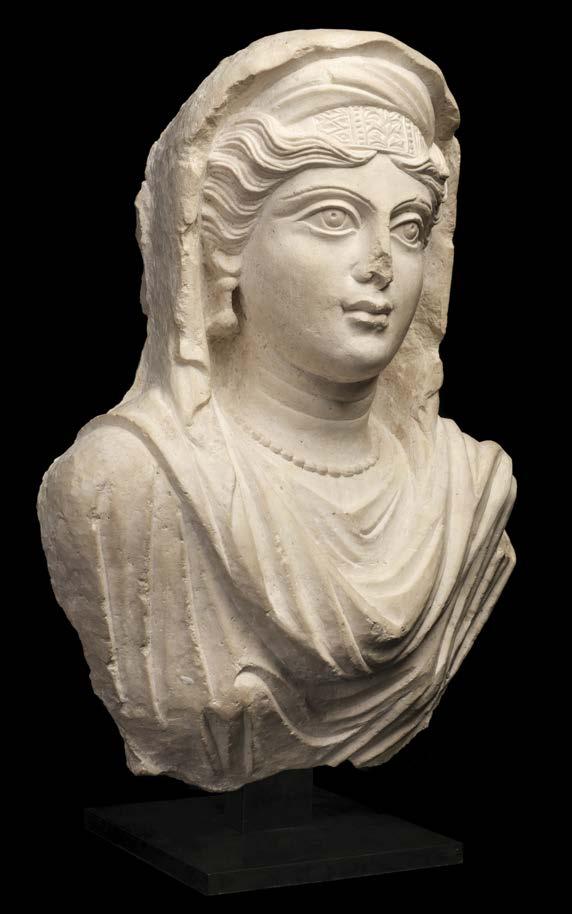
Provenance: Private collection, Bristol, U.K.
Acquired in Egypt in the 1940s by Leslie Valentine Grinsell, OBE, FSA (190795), archaeologist and museum curator of archaeology at the Bristol City Museum. Grinsell gave this piece to Brian Davies, a Bristol undertaker in the 1970s and thereafter found its way into the current private collection.
£1,500 - £2,000

555* Palmyrene Empire. A limestone bust of a female, mid2nd century A.D., carved as a young woman depicted with large almond eyes with elongated and slightly down-turned corners, the irises incised and the pupils drilled, with incised flowing serpentine eyebrows, the thick wavy hair pulled back from a centre parting under a broad-like diadem decorated with square cells of foliate and geometric patterning divided by vertical rows of hemispherical beads, a hood pulled over and she is wearing a beaded necklace and heavy drop earrings, the piece is broken vertically below the shoulders, the nose chipped and some restoration work, 46 cm high, presented on a modern stand, overall height 51 cm, with the copied paperwork plus Art Loss Register declaration dated 2001
Provenance: Private collection, Bristol, U.K. Purchased circa 2001 from Rupert Wace Ancient Art Limited, 14 Old Bond Street, London W15 4PP at which time it was described as coming from a private collection in the U.K.
Palmyra was a rich city situated in an oasis in Syria. It owed its wealth to the caravan trade between the east and the Roman empire, and a strong eastern flavour runs through much of its art. The elaborate tomb monuments set up by the rich reflect this orientalism, which can be seen in the exotic features of this bust (Rupert Wace Ancient Art Limited printed sale description accompanying this lot).
£10,000 - £15,000
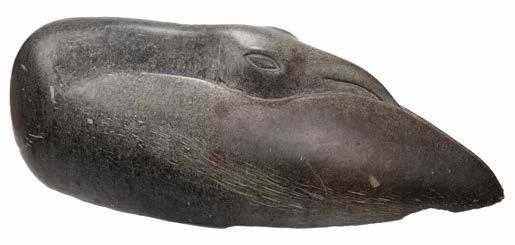
556* Greenland Carving. A large stone Inuit carving, carved as a bird with its head turned back, a slender and fine looking piece carved in grey and black stone, 50 cm long
(1)

£300 - £500

557* Greenland Paddle. An Inuit paddle, probably late 19th century, carved from a piece of pine with whalebone blade, evidence of old (inactive) wormholes, 180.5 cm long
(1)
£200 - £300
558* Solomon Islands Paddle. A carved wood paddle, early to mid 20th century, the blade carved as a palm leaf, 165 cm long
(1)
£150 - £200
559* Tribal Art. Three North African carved wood tent pegs, each with geometric decoration, largest 78 cm, smallest 68 cm, together with an African quiver, made from a hollowed fruit with glass bead decoration, 40 cm long, an African softwood figural carving, the head with an elongated nose, the long hair with incised marks, 84 cm and other items
(7)
£200 - £300
560* Tribal Weapons. A large collection of tribal art, mostly South Sea Islands and African, including an Australian hardwood bow, 187 cm long, Polynesian spear with figural carving, 238 cm, various African spears, paddles and other items
(28)
£300 - £500
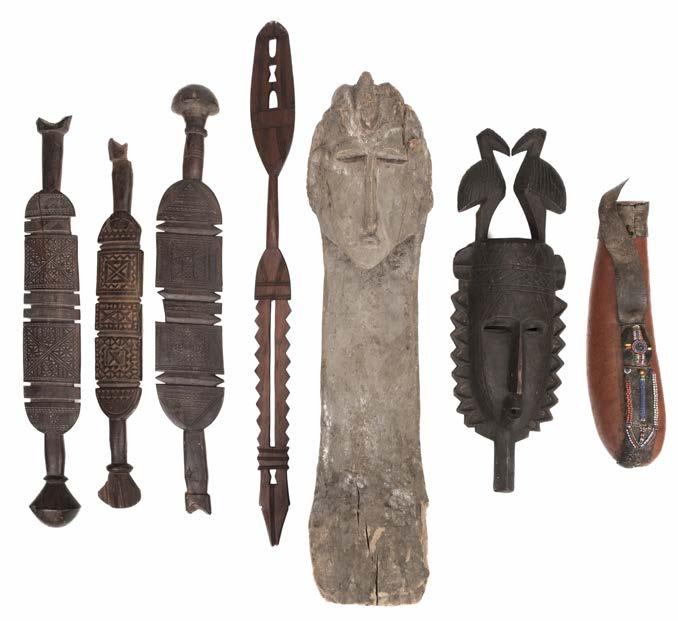

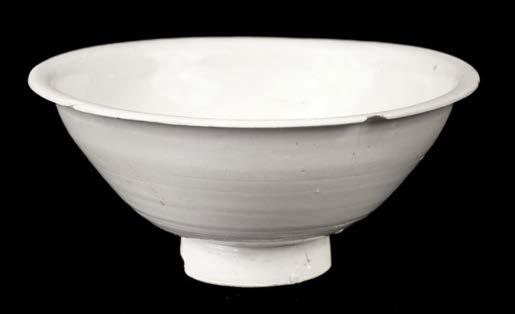
564* Bowl. A Chinese Dingyau ware bowl, late Southern Song (1127-1279), the small white glazed bowl raised with pronounced footring, with everted rim, three chips to the rim, 5 cm high x 11.3 cm diameter
£300 - £500
561* Banjuan (Zhou, Canadian/Chinese, 20th century). Study of flowers with insects, watercolour on paper, signed, laid on traditional cloth backing, sheet size 38.5 x 63 cm, framed and glazed, frame size 53 x 104 cm, together with two larger still life works by the same artist, both signed and presented in the same style, frame sizes, 155 x 75 cm and 136 x 62 cm (3)

562* Boat Study. A Japanese bronze boat study, early 20th Century, with pointed prow, a band of Greek key pattern engraved on both sides under the rim of the boat, spuming sea waves flanked at the base, one wave with small bird in flight, length 27 cm, resting on a wooden stand (27 x 20.5 cm), the underside with paper label stamped ‘No.6547 Made in Japan’ (1)
£150 - £200
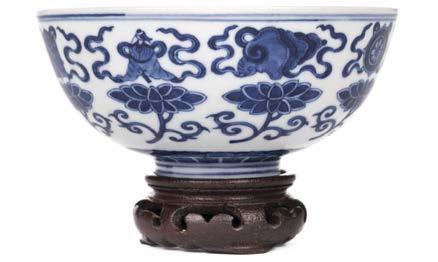
563* Bowl. A Chinese blue and white porcelain ‘lotus’ bowl, early 20th century [?] with ‘Guangxu’ six character mark, hairline crack, 14 cm diameter x 6.5 cm high, with wooden stand (1)
Each lot is subject to a Buyer’s Premium of 20% (Lots marked * 24% inclusive of VAT @ 20%)
£200 - £300
Although this lot bears a manuscript label describing it as ‘Northern Song 960-1127’ stylistically this piece is later. (1)
£200 - £300

565 Bowl. A Chinese Jun ware pottery bowl, probably Song Dynasty, with a celadon glaze and unglazed areas, 15.5 cm diameter (1)
£100 - £150

566* Bronzes. A Chinese bronze, 19th century, modelled as a dog of Fo, with a paw resting on a puzzle ball, 5 cm high, together with two small Indian bronzes, including a four armed deity with sword, 7 cm high, plus a bronze vessel modelled as a horse rider, probably South American, 12 cm high x 12 cm long (4)
£100 - £150

Provenance: Toovey’s Auction, 19th April 2012, lot 1200 (auctioneer’s label attached to interior).
(1)
£300 - £500


and two string patterns on the necks, the body with arch-shaped apertures, height 24 cm (including spikes)
(1)
(1)
£200 - £300
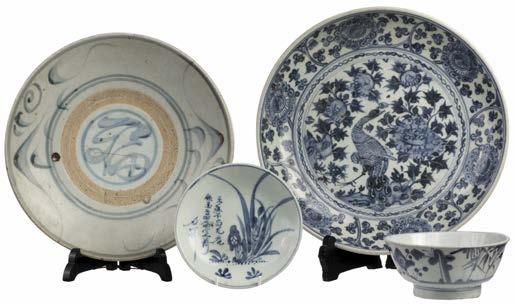
(4)
£500 - £800
£150 - £200
567* Brush Pot. A Japanese bronze brush pot, Meiji period, the cylindrical body decorated in copper, gilt metal, shakudo and silver with dragons, Buddhistic lions and flowers, within floral ironwork oval panels, 11 cm high x 9.2 cm diameter 568* Buddha. A Burmese marble Buddha, 19th century, carved and incised with traces of gold lacquer, carved in the traditional manner, seated in padmasana with hands in bhumisparsa and dhyana mudras, with elongated earlobes and bud-shaped usnisa, 45 cm high 569* Candle Holders. A pair of Chinese bronze candle holders, 17th-18th century, a pair of bronze hexagonal candle holders, with flared rims 570* Canton Ware. A Chinese porcelain dish, 19th century, blue scroll decoration to the centre surrounded by an unglazed ring and a further blue scroll painted rim, old hairline cracks, 29 cm diameter, together with an Eastern porcelain blue and white dish, decorated with a peacock amongst flowers, similar repeating border, 31.5 cm diameter plus a blue and white bowl and a dish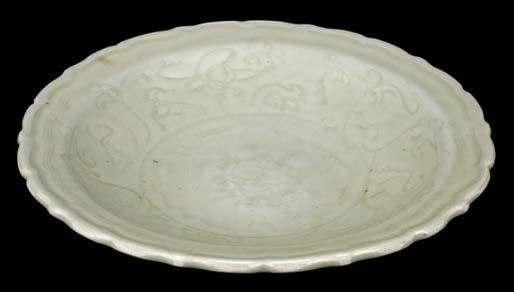
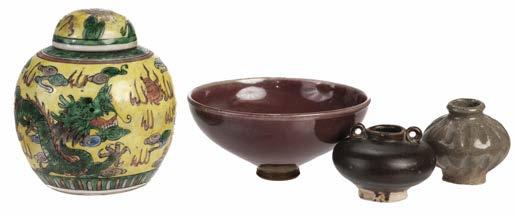
571* Celadon Plate. A Chinese Longquan (Zhejiang Province) celadon porcelain plate, Ming Dynasty (1368-1644), the plate with incised decoration under celadon glaze, decorated on the interior with a central peony enclosed by further sprays in the well, the exterior decorated with a ribbed band, covered overall with a seagreen glaze with the exception of the unglazed base, excellent condition, 27.8 cm diameter (1)
£500 - £800

572* Charger. A large Hispano-Moresque copper lustre pottery charger, late 19th century, decorated in blue and copper lustre, the raised central boss with a stylised swirl design, within a foliate scroll border and additional border with relief moulded leaves, some minor wear but the overall condition, 50 cm diameter (1)
£200 - £300

573* Chinese Censer. A Chinese bronze censer, of cylindrical form cast with birds and leopards, with mask handles (lacking rings), raised on three supports with a square mark to base, 13.5 cm high x 20 cm across, together with a large Chinese brass bowl, decorated with phoenix and dragons, on a bamboo leaf base, 17 cm high x 29.5 cm diameter, plus two Indian brass bowls, one probably Benares ware, 16 cm high x 27 cm diameter (4)
Each lot is subject to a Buyer’s Premium of 20% (Lots marked * 24% inclusive of VAT @ 20%)
£150 - £200
574* Chinese Ceramics. A Chinese Jun ware bowl circa 1920s, copying an earlier style, deep red glaze with a small but pronounced foot, 14 cm diameter, together with a porcelain ginger jar and cover, 19th century, polychrome decorated with dragons and flaming pearl on a yellow ground with green highlights, 14 cm high, plus two small vessels, the ovoid pot with incised decoration and lighter brown glaze with a label inscribed Thailand 15/16th century, 6 cm high (4)
£100 - £150


575* Chinese Dish. A Chinese blue glazed dish, Ming Dynasty, from the Jingdezhen kiln, South China, the light blue porcelain dish with two unglazed terracotta rings to the base and am impressed mark of three lines in a box, 27.5 cm diameter
(1)
£300 - £500
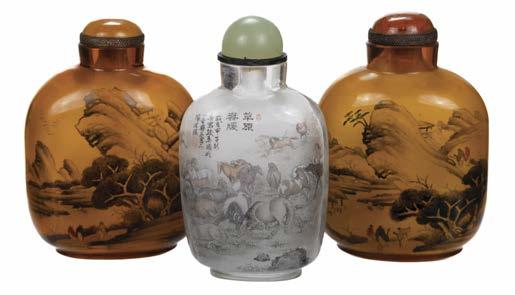
576* Chinese Snuff Bottles. An inside painted glass snuff bottle, of flattened, rectangular form with a cylindrical neck and an oval foot-rim, painted on the inside, with scenes of herds of horses on grassland, 10 cm high, together with a pair of inside painted amber snuff bottles, of rounded rectangular form with a cylindrical neck and an oval foot-rim, with floral decoration to one side and figures in a mountain landscape to the reverse, 10 cm high
(3)
£150 - £200


577* A Chinese Sang de Boeuf porcelain vase, 19th century, the bottle form vase with a deep red glaze, the base drilled and chipped, 24 cm high (1)
£200 - £300
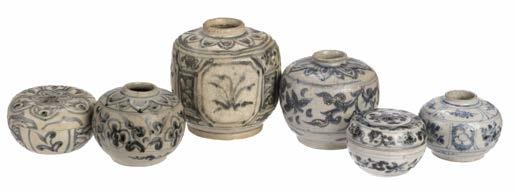
578* Chinese Vessels. Chinese miniature blue and white pottery vessels, Jingdezhen kiln, Ming dynasty, 14th century, comprising two circular boxes and covers, 7.5 cm and 6.2 cm diameter plus three ovoid pots, the largest 10 cm, the smallest 5 cm (6)
£200 - £300
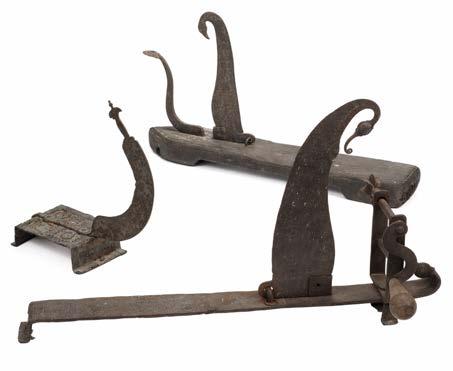
579* Coconut Cutter. An Indian coconut cutter/grinder, with integral cutting utensil and grinder engraved with a geometric design leading to a bird head terminal, 62 cm long, together with two Indian vegetable cutters, one mounted on a wooden block, 57 cm long (3)
£200 - £300
580* Dish. A Vietnamese porcelain blue and white dish, probably circa 1500, decorated in the Chinese style with anemones within a foliate border, the base unglazed, 36.5 cm diameter, together with similar dish, cracked and restored, 36 cm diameter, plus a smaller dish, decorated in the same style, with firing cracks, 23 cm diameter (3)
£200 - £300
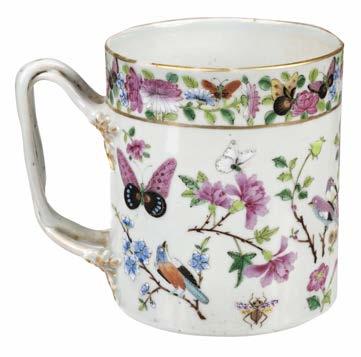
581* Famille Rose. A Chinese famille rose porcelain mug, 18th century, the oversized mug decorated with exotic birds, insects, flowers and foliage, highlighted in gold, with a double crossover handle, small firing fault to the rim, 12 cm high x 10.5 cm diameter (1)
£100 - £150
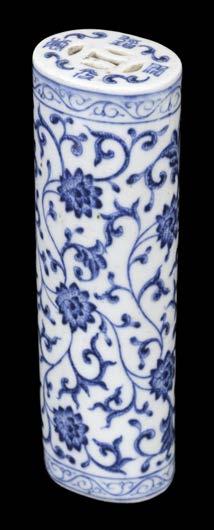

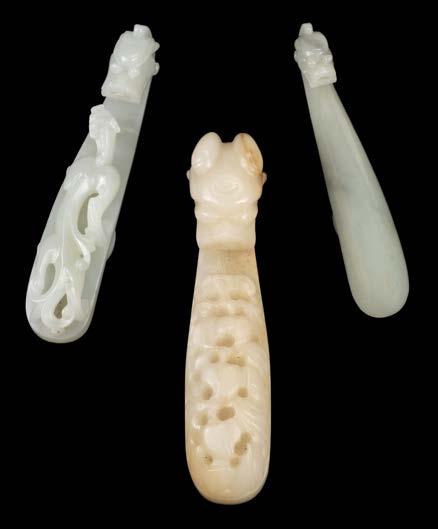
582* Hand Warmer. A Chinese blue and white porcelain hand warmer, 19th century, the oval section cylinder decorated with scrolling lotus, both ends pierced with the pattern of a coin but one with the mark “Daoguang Nianzhi”, 14.5 cm long (1)
£200 - £300

583* Incense Burner. A Chinese bronze incense burner, Qing Dynasty, of circular form, everted rim decorated with inlaid scrolling design and with two Chongtianer handles, a band of water waves underneath the rim, on the body low relief engraved figures of scholars and monks enjoying tea in the gardens, a band of Bingmei (crackling plum blossoms) patterns around the tripod feet, the feet modelled as bamboo sections and with a butterfly on each, base mark “Xuande Nianzhi”, 14 cm high x 15 cm diameter (1)
Each lot is subject to a Buyer’s Premium of 20% (Lots marked * 24% inclusive of VAT @ 20%)
£300 - £500
584* Chinese jade bead necklace, probably 1920/30s, with 19 large beads suspended by silver, 32 cm, in original silk embroidered box, together with a Chinese hardstone bandle, plain form with a coral shade, 8.5 cm diameter (2)
£100 - £150
585* Jade. Chinese jade belt hook, carved with a beast’s head, 6.5 cm long (1)
£100 - £150
586* Jade. Chinese jade belt hook, carved as a dragon, 10.5 cm long, together with two further dragon belt hooks, comprising a larger mottled jade example, 11 cm long, plus another with a smooth finish, approximately 10 cm long (3)
£200 - £300
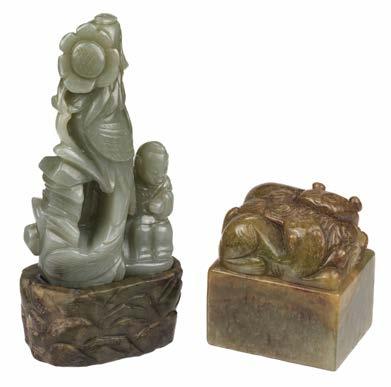
587* Jade. Chinese jade desk seal, the square seal carved with felines, 5.5 cm high, together with a large carving of a boy next to a peacock on a darker naturalistic base, 13 cm high (2)
£100 - £150
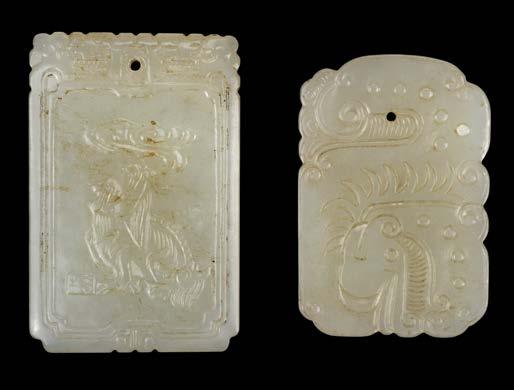
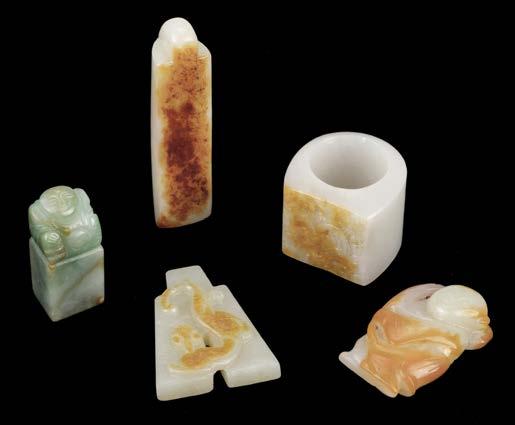
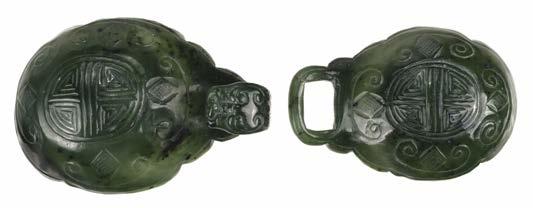
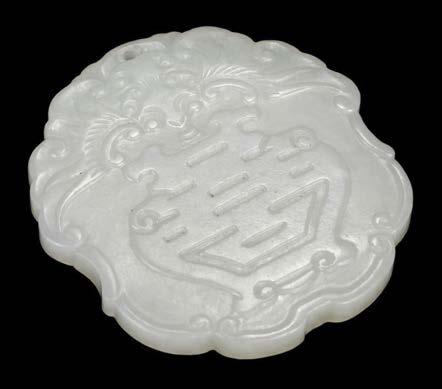
(5)
£200 - £300

20th
a
watercolour
paper, signed, 66 x 45.5 cm mount aperture, framed and glazed (79 x 59 cm), together with Buhong (Ye, 20th century). Landscape with waterfall and boat, watercolour on paper, signed, sheet size 29 x 89 cm, framed and glazed (40 x 108.5 cm) (2)
£150 - £200
588* Jade. Chinese jade pei, one side carved with a dragon with smoke coming from its mouth, the other with Chinese characters, 5 cm long, together with a smaller pei, both sides carved with a dragon, 4.5 cm long (2) £100 - £150 589* Jade. Chinese spinach jade belt hook, two oval parts, one side carved with a feline head forming the hook, the other similarly carved with geometric decoration, each 8.5 cm long (1) £200 - £300 590* Chinese white jade pei, carved in relief with a vase and mask, the other side similarly carved, with small hole for suspension, 5 x 5 cm (1) £100 - £150 591* Jade. Various Chinese jade carvings, including a pendant carved with a kylin, 4.2 cm long, a pebble carved with an elder carrying a leaf, 4.5 cm long, a small apple green seal, the top carved with a buddha, 3.5 cm and archers ring, the top carved with a bifad, 3.4 cm 592* Jirong (Wan, century). Figures on boat, on

593* Koro. A Japanese parcel-gilt silver koro, 20th century, of globular form, the neck with a band of scrolling lines, a band of stylised lotus leaves on the shoulder, the body with two Chilong motifs applied on a brocade ground, two dog of Fo mask handles, tripod support, base mark “八代住,钉谷洞石, 银900”, the lid with some pierced circles and a dog of Fo finial, 8.8 cm high (1)
£100 - £150

594* Koro. A Japanese bronze koro (incense burner), Genroku Era (1688-1704), of a circular form with an everted rim, inscription on the body ‘…on the 15th of March of the 12th year of Genoku Era’, the body (with lovely patina) supported by a tripod of three beast masks, 19cm at widest point, weight 2600 g (1)
Each lot is subject to a Buyer’s Premium of 20% (Lots marked * 24% inclusive of VAT @ 20%)
£500 - £800
595* Koro. A Japanese bronze koro (incense burner), Meiji Period, of a rounded quatrefoil shape, the everted rim in the form of petal, the body decorated with peach-shaped panels, flanked by two tall curved rectangular handles with shaped openings, supported by four splayed feet, the quatrefoil and domed lid with openings on low relief patterned ground and a Kylin finial, height 16 cm (1)
£200 - £300
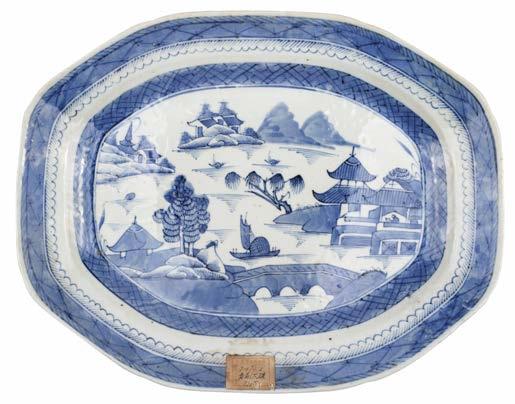
596* Meat Plate. A Chinese export porcelain Canton blue and white porcelain meat plate, 19th century, the central design consists of houses, mountains, trees, a bridge, and several boats, surrounded by a border, with paper label of ‘Guangdong Provincial Cultural Relics Dealer’, seal of Guangdong Provincial Cultural Relics bureau to reverse, 41 cm wide (1)
£150 - £200
597* Chinese bronze hand mirror, 18th century, of circular form with central boss bordered by Chinese characters, age wear to the reverse, 16 cm diameter (1)
£100 - £150
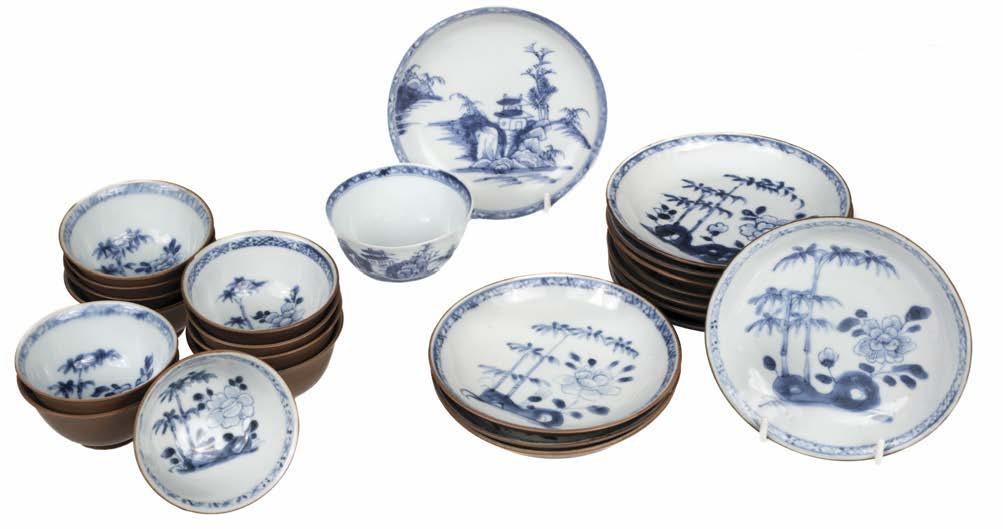
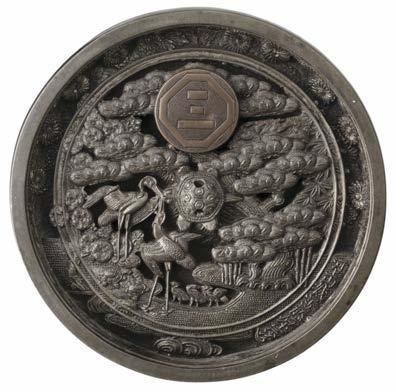
598* Mirror. A Japanese bronze mirror, 19th century, the substantial mirror with one side pierced with a pattern of cranes on pine trees and bamboo, surrounded with clouds and chrysanthemum blossoms, a character “three” in a roundel at the top, signed “Kawakami Yamashino Fujisawa Munetsugu”, 12.3 cm diameter
Provenance: Purchased at Nagel Auction, Stuttgart (ink manuscript label on blank side).
(1)
£500 - £800
599* Nanking Cargo. A Chinese ‘Batavia ware’ blue and white porcelain bowl, circa 1752, the interior decorated with flowers, the exterior with a cafe-au-lait glaze, 16.5 cm diameter x 7 cm high, together with a ‘Batavia ware’ porcelain plate, 23 cm diameter plus another decorated with pagodas and landscapes, 23.5 cm diameter, all bearing labels for Christie’s and R&G McPherson
600* Nanking Cargo. A collection of 11 Chinese ‘Batavia Ware’ blue and white porcelain tea bowls and saucers, 1752, decorated with flowers, the exterior with a rustic brown glaze, the bowls 7 cm diameter, the saucers 12 cm, all with Christie’s Nanking Cargo label to base (lot 5231), together with another Nanking Cargo blue and white porcelain tea bowl and saucer, the exterior decorated with a pagoda and landscape, the interior plain, the bowl 7.5 cm diameter, the saucer 12 cm, Christie’s auction (lot 5063), some minor wear but the overall condition is very good
Provenance: Private collection, Bristol, UK. (12)
£700 - £1,000

601* Nanking Cargo. A collection of 11 Chinese blue and white porcelain plates, 1752, each with a pagoda within a landscape within a foliate border, 23 cm diameter, Christie’s Nanking Cargo labels (lot 1755), in good condition with no obvious chips or restoration
£100 - £150
Provenance: Christie’s The Nanking Cargo sale, 28 April to 2 May 1986, lots 2538, 3604, 1755; Private Collection, Bristol, UK. (3)
Provenance: Private collection, Bristol, UK. (11)
£1,000 - £1,500


602 Pietre Dure. An Indian foliate inlaid octagonal marble table top, early 20th century, profusely inlaid with semi-precious stones, some areas of loss, 41 cm across (1)
£200 - £300
603* Scholars Table. A Chinese hardwood scholars table, of rectangular form with carved moulding, staining to the top, 31 cm high x 75 cm wide x 51 cm deep, together with a 20th century Chinese hardwood table cabinet, with fret cut gallery above a bank of drawers with a cabinet door to the right, 40 cm high x 34.5 cm wide x 20 cm deep, a Chinese hardwood double gourd stand, 24 cm long plus a 19th century miniature hardwood table, 19.5 cm high x 29 cm (4)
£200 - £300

604* Shuiquan (Zhang, 1892-). Chinese Scholar’s armrest, mid20th century, fine carved bamboo, with motifs of the “One Hundred Shou” (Longevity), 30 cm long x 7.7 cm wide
The present work was carved by Zhang Shuiquan in 1955. Shuiquan was born in 1892 and won a first prize for his bamboo carving at the Panama-Pacific International Exposition in 1915 at the age of 23. His works were used as national gifts by the Chinese Government. (1)
£300 - £500

605* Song Dynasty. A Chinese celadon pot, probably late Song dynasty, South East China, circa 12/13th century, of ovoid form with incised decoration, 11 cm diameter, together with two similar celadon bowls, both with incised decoration, the darker glazed bowl, 19 cm, the other 17 cm diameter
(3)
Each lot is subject to a Buyer’s Premium of 20% (Lots marked * 24% inclusive of VAT @ 20%)
£300 - £500
606* South East Asia. A large blue and white pottery ovoid vessel, with a geometric design, 19 cm high, together with a provincial ovoid pottery vase, 16 cm high, plus a lidded pot, with black scroll and line decoration, the cover with a raised knop, 13 cm high (3)

£150 - £200
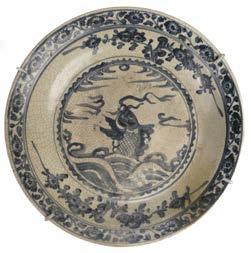
607* Swatow Ware. A Chinese Swatow Ware blue and white porcelain charger, Ming Dynasty, decorated with flowers within a conforming border, heavy craquelure, 40.5 cm diameter, together with two similar Swatow ware chargers, one decorated with fish, 42 cm diameter, the other a dancing lion, 41 cm diameter
Swatow Ware also referred to as Zhangzhou Ware is a generic term for late Ming Dynasty Chinese export porcelain, intended for the Southeast Asian market. The name Swatow arose from Swatow, or present day Shatou, the South Chinese port in Guangdong province from which the wares were believed to have been shipped.
(3)

£200 - £300

608* Swatow Ware. A Chinese Swatow Ware blue and white porcelain dish, late Ming Dynasty, decorated with an exotic bird amongst foliage, the border similarly decorated, unglazed base, 35 cm diameter, together with another Swatow Ware dish, polychrome decorated with an exotic bird amongst foliage, the border similarly decorated with lattice border, the base unglazed, sympathetically restored in gold, 37 cm diameter
(2)
£200 - £300



609 Swatow Ware. A Chinese Swatow ware blue and white porcelain vase, late Ming Dynasty, decorated with dragons and landscapes, the neck with four moulded loops, 38 cm high
(1)
£150 - £200
610 Vase. Chinese porcelain miniature vase, 20th century, decorated in blue and red with flowers, six character 'Qianlong' mark to base, 7 cm high, restored, together with a 20th century Chinese porcelain cup decorated with flowers and Chinese script, 6.5 cm diameter x 5 cm high, damaged
(1)
£100 - £150
611* Vase. A Chinese pottery vase, probably Han Dynasty, with Bluett & Sons trade label, of baluster form with two scroll handles, incised with black bands and traces of red paint, the base with Bluett & Sons London trade label and collection number 4746, an old chip the foot rim, 21 cm high
(1)
£100 - £150
612* Vase. A Chinese sang de boeuf porcelain bottle vase, 18/19th century, with a distinctive red glaze body and celadon neck, the base with an old chip to the foot rim, 20 cm high
(1)
£100 - £150
613* Vase. A Chinese Tiexihua porcelain vase, 19th century, of baluster form with a moulded underglaze blue family of lions playing with a cub, decorated on the underglaze yellow ground neck with two naturalistic prunus sprig handles, a band of brown floral low relief to the shoulder and a water weave band above a pattern of stones and grass in underglaze blue and light blue crackled ground, 43.5 cm high
(1)
£1,000 - £1,500
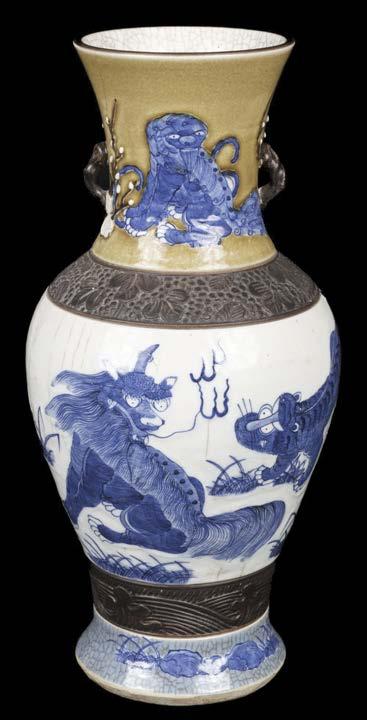
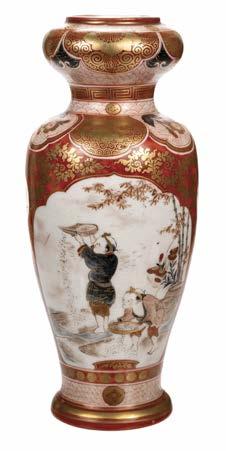
a rice field, against a red ground with gilt decorated scrolling foliage and geometric pattern, marks to base, 24.5 cm high (1)
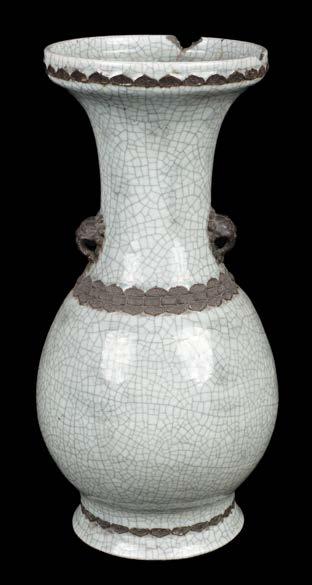
Each lot is subject to a Buyer’s Premium of 20% (Lots marked * 24% inclusive of VAT @ 20%)
£100 - £150
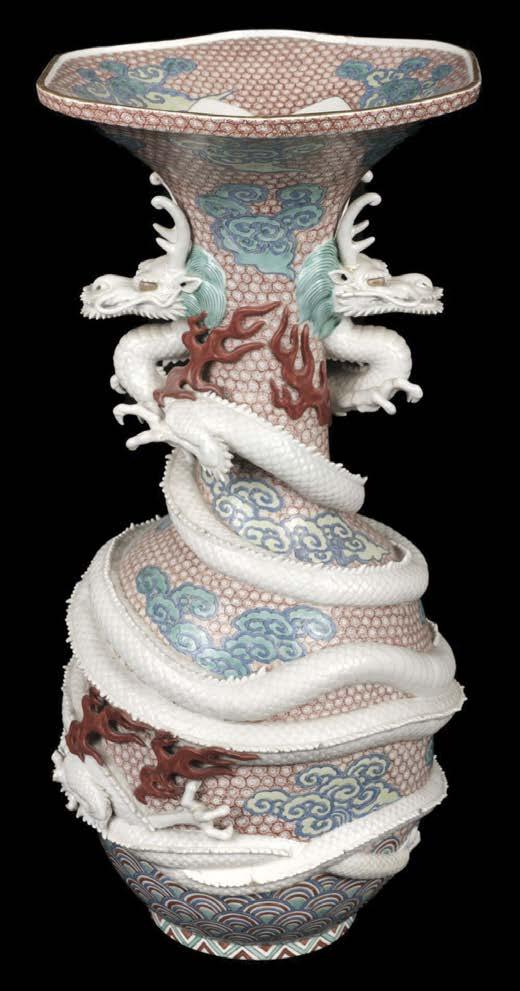
(1868-1912),
baluster form, flared hexagonal mouth and everted rim, two dramatic white glazed dragons wrapped around the body with a head on each side of the neck staring fiercely forward, with green glazed hair and red glazed fire flames on the body of the dragons, yellow and green clouds decorated on coral brocade ground with stylised water motifs to the lower section, the base with black painted mark 平户造 三川内, 56 cm high
£500 - £700
Provenance: For a very similar elaborately decorated jar, see Schiffer, Japanese Porcelain 1800-1950 (2nd edition, 1999): ‘Hirado covered jar with elaborate dragons in relief and fish finial, marked Hirado, 19th century, 12.5” high’. (1)
£2,000 - £3,000
614* Vase. A Japanese Kutani Porcelain Vase, Meiji Period (18681912), of cylindrical form with raised neck, decorated to one side with a scene of a farmer and a cow amongst a landscape and stream, to the other side two people working 615* Vase. A large Chinese Tiexiuhua craquelure glaze celadon vase, 19th century, celadon porcelain vase with iron rust decoration, of baluster form with trumpet shape rim, bands of low relief brown ruyi yuntou, dog of Fo mask handles and a brown unglazed coloured base, large chips to the rim and some restoration, 56 cm high (1) 616* Vase. A large Japanese Imari porcelain vase, Meiji of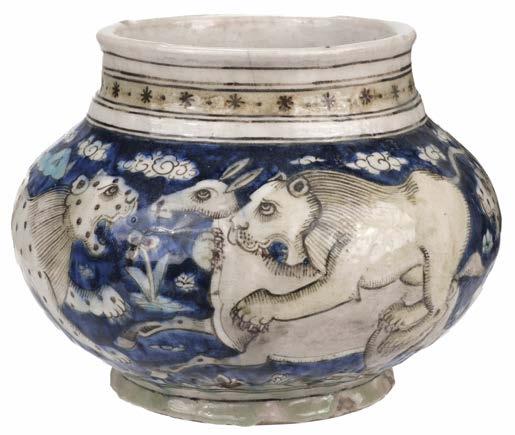
£300 - £500
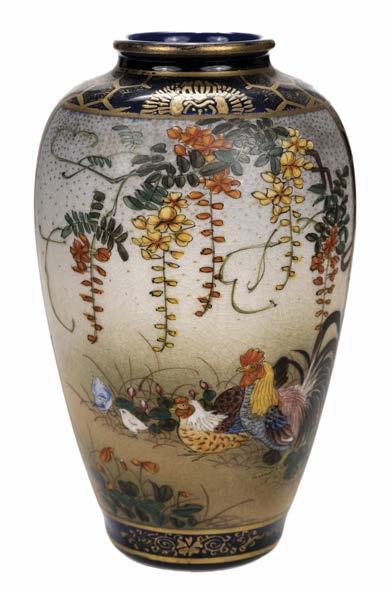

619* Vase. An impressive pair of large Chinese earthenware vases, late Qing (second half 19th century), of baluster form with trumpet shaped rims, polychrome decorated with a hawk on a pine tree staring down at a lion, with rocks, flowers, foliage and bats, on a mustard yellow ground, with two dragon head handles, some minor flaking to the glaze, and one with a little damage to the rim, each 57.5 cm high, presented on carved wooden stands (2)
£700 - £1,000
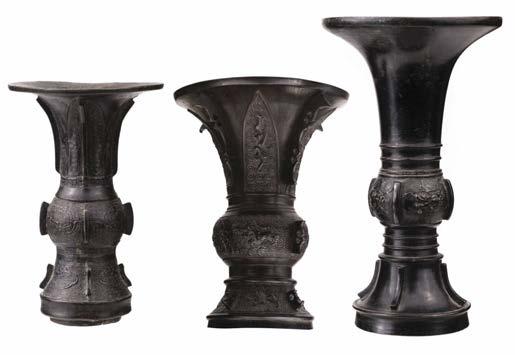
618* Vase. A Japanese Satsuma vase, Meiji Period (1868-1912), of ovoid form and decorated to one side with a scene of two birds perched on an overhanging branch, to the other side with a scene of a chicken and rooster beneath tree branches in blossom, against a dark blue ground with gilt decorated flowers and geometric pattern, the base signed ‘Kinkozan’ in gold under the base, 12.5 cm high (1)
£300 - £500
620* Vase. A Chinese archaic style bronze vase, Qing Dynasty, with plain wide flared neck, the centre knop with four panels divided by flanges, each panel with a beast on brocade ground, the lower section with four flanges, circular foot, height 19.5 cm, together with two others similar, the necks, middle and lower sections all cast with beasts on brocade ground divided by flanges, on short circular feet, 15.5 cm & 14.5 cm high (3)
£300 - £500
617* Vase. A Persian pottery vase, early 19th century, of bulbous form polychrome decorated with lions and cheetahs attacking a deer, on a blue ground with mountains and clouds, the base unglazed with several old chips on the rim, 21 cm diameter (1)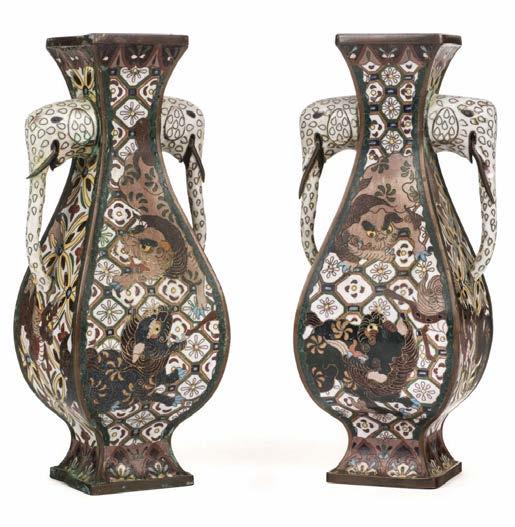

623* Ammonite. A large ammonite found in Morocco, Cretaceous period, well preserved and very heavy, measuring 49cm across (1)
£150 - £200
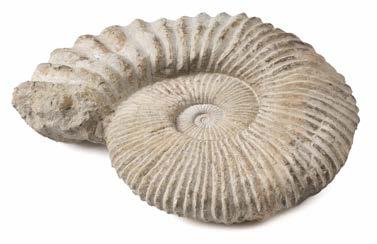
£200 - £300
621* Vase. A pair of Japanese cloisonné vases, Meiji Period, of four side baluster form, spread square rims and feet, each neck with two elephant mask handles (one lacking a tusk), the bodies decorated front and back with double playing dog of Fo, on diamond-shaped pattern grounds, the sides with dragons on stylised petal grounds, base marked “Fuku” on turquoise square within a red circle, 26 cm high (2)
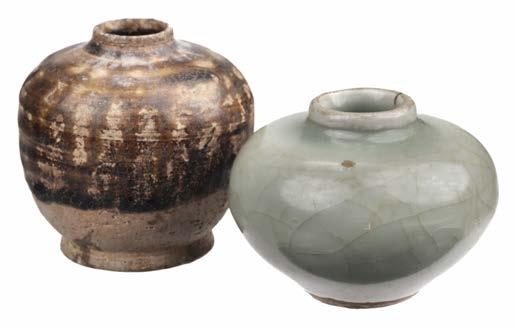
622* Vessels. A small Chinese pottery vessel, early Ming Dynasty, of squat ovoid form with a longquan celadon glaze, 6 cm high, together with smaller brown glaze pottery vessel of the same period, 7 cm high (2)
Each
£100 - £200
624* Ammonite. A large ammonite found in Morocco, Cretaceous period, well preserved and very heavy, measuring 44 cm across (1)
£200 - £300

625* Ammonite. A fine Cleoniceras ammonite specimen, Cretaceous period (120 million years old), which has been cut through its centre and then polished to reveal the intricate chambers which have been preserved in calcite and limestone, the specimen is a large and impressive display fossil which measures approximately 16.5 cm across (1)
£100 - £150

626* Ammonite. Cleoniceras Ammonite, Cretaceous period (120 million years old), which has been cut through its centre and then polished to reveal the intricate chambers which have been preserved in calcite and limestone, the specimen is a large and impressive display fossil which measures approximately 16.5 cm across (1)
£100 - £150
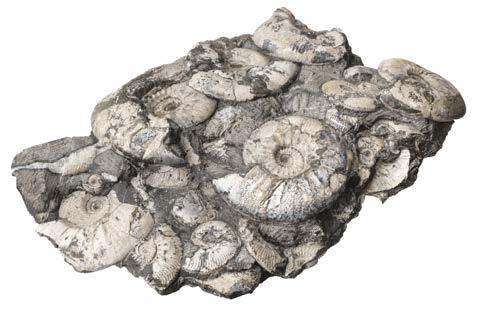
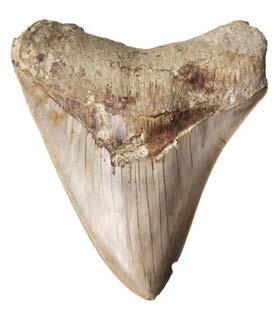
630* Megalodon Tooth. A large Megalodon tooth found in Indonesia, Miocene period, a good example with the majority of serrations still intact and natural root, approximately 11.4 cm (1)
£200 - £300
627* Ammonites. The “South Cerney” multi-ammonite display block of Kosmoceras ammonites found in South Cerney, Gloucestershire from the Middle Jurassic, Callovian period (approximately 165 million years old) this specimen measures 33 x 20 cm (1)
£200 - £300
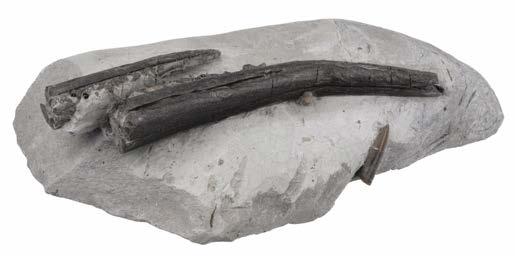

631* Prawn. A good example of a fossilised prawn found in the Solnhofen deposits of Bavaria, Jurassic period (approximately 150 million years old), the rock measures approximately 14.5 x 11.5 cm (1)
£100 - £150
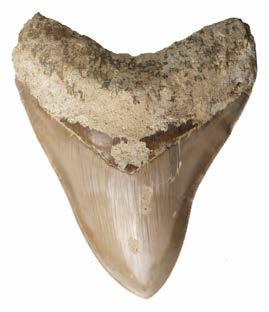
£500 - £800
628* Ichthyosaur Jaw. A fine British fossil retaining teeth found in Lyme Regis, Lower Jurassic period, with excellent preservation, the jaw section measures 13.5 cm with the overall size of rock 20 x 11 cm (1)

629* Megalodon Tooth. A large Megalodon tooth found in Indonesia, Miocene period, a good example with the majority of serrations still intact and natural root, approximately 13 cm long (1)
£300 - £500
632* Sharks Teeth. A collection of 15 fossilised shark teeth, from an ancestor of the Great White shark (Otodus obliquus) approximately 50 million years old, variable sizes with the largest measuring 5 cm, presented in a glass display case, case size 30.5 x 20 cm (1)
£100 - £150

633* Specimen Cabinet. A Victorian mahogany 7 drawer specimen cabinet, containing insects, British and foreign butterflies and moths, stick insects, dragonflies, fossils and minerals including ammonites, some captioned, the cabinet 57 cm high x 51.5 cm wide x 30.5 cm deep and in poor condition
(1)
£350 - £400
634* Spinosaurus Tooth. A fossilised tooth from the Cretaceous period (approximately 110 million years old) found in Taouz (Kem Kem), Morocco, 10 cm long
(1)
£100 - £150


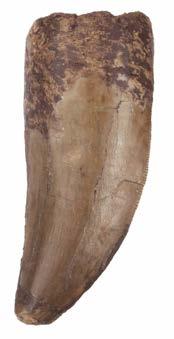
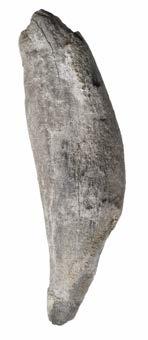
635* Trilobites. A very large Paradoxides Trilobite Plate with four large Trilobites each measuring around 30 cm in length, the impressive fossilised display piece from the Ordovician of Morocco and measures approximately 93 x 60 cm
(1)
£2,000 - £3,000
636* Tyrannosaurus Tooth. A large and impressive fossilised T-rex tooth from North Africa, the species is Caracharodontosaurus and would have been equally as ferocious as its North American counterpart, this fine specimen measures approximately 5.6 cm long and has excellent enamelling and serrations
(1)
£150 - £200
637* Whale Tooth. A good example of a fossilised whale tooth found in the English Channel, this specimen comes from an ancient sperm whale and is from the Miocene period, 8 million years old, 11.5 cm
(1)
£80 - £120
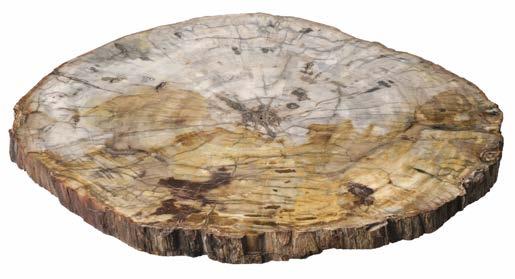
638* Wood Slice. A large fossilised wood slice from Madagascar, Triassic period (approximately 220 million years old), this specimen with a deep buff and orange agatisation, approximately 39 cm across (1)
£400 - £600
Lot 635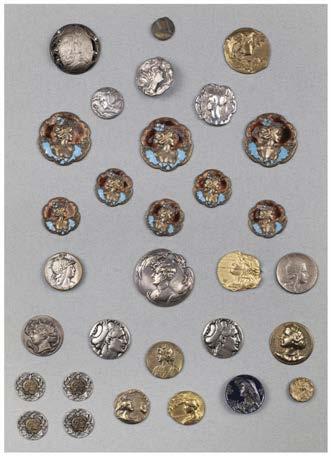
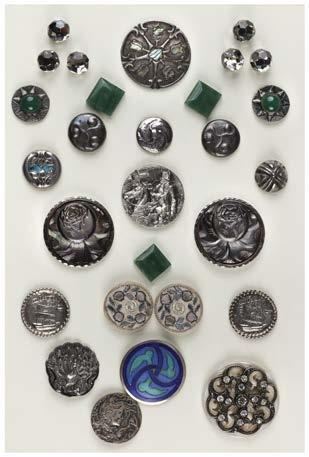
641* Art Nouveau Silver Buttons. An Edwardian ‘Cymric’ silver button by Liberty & Co, Birmingham 1902, designed as a sailing ship with orange enamel, 26 mm diameter, together with other Liberty & Co ‘Cymric’ silver buttons including a stylised flower head, Birmingham 1902, inset with green stone cabochon, 30 mm diameter, other silver buttons by various makers including William Hutton & Sons Ltd, Robert Pringle & Sons, Marples & Co, Loewe Rosenthal and other makers, presented on a board for display (25) £300 - £500
639* Art Nouveau Buttons. A collection of 31 Art Nouveau buttons, mostly young female heads, including 3 large and 5 smaller brass buttons, each with a female head facing right and blue and brown enamel, 33 mm diameter, a white metal button with young female head facing right wearing a sunflower headdress and inset with marcasite stone, 30 mm, various white metal buttons, some brass and other types, presented on a card board for display (31)
£100 - £150
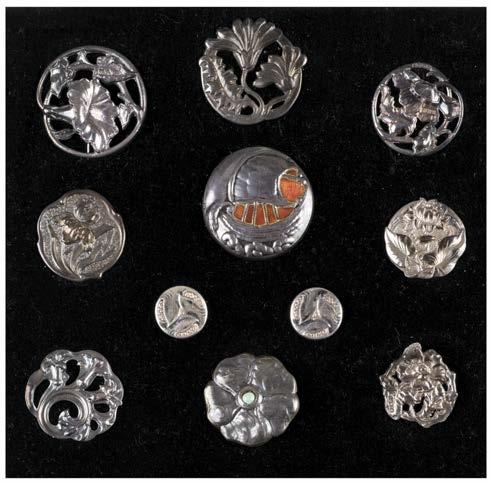
£200 - £300
640 Art Nouveau Silver Buttons. A collection of 70 Art Nouveau buttons, including a fine silver and enamel button by A.H. Darby & Son, Birmingham, 1946 enameled with a blue and green Celtic design, 35 mm diameter (70)
642* Art Nouveau Silver Buttons. A good collection of approximately 115 Art Nouveau buttons mostly silver and white metal, including six silver and enamel buttons Reynolds & Westwood, Birmingham 1901, pierced with foliate decoration with blue and green enamels, some loss of enamel. 30 mm diameter, 5 silver buttons by William Hutton & Sons, each with organic design, other makers include Mappin & Webb, Britain Gould & Co, William Aitken, various other types of buttons including 5 and 2 smaller niello work, mother of pearl and others, presented on 4 card boards for display (approx. 115) £300 - £500
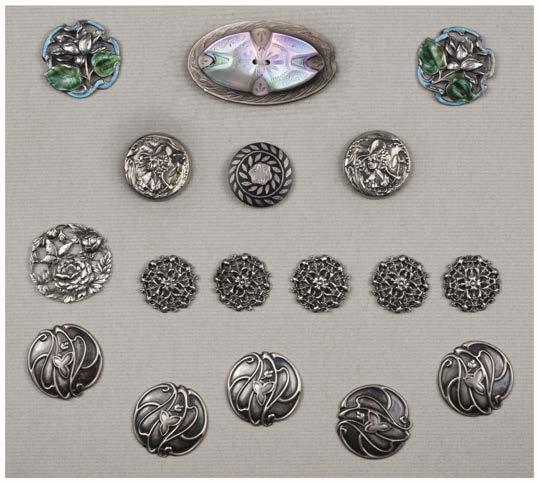

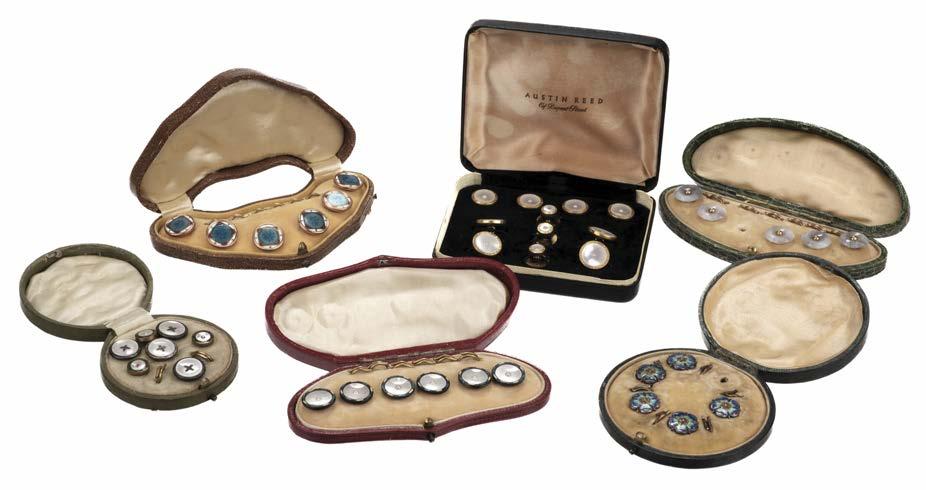
643* Art Nouveau Silver Buttons. A set of six Art Nouveau silver buttons by William Hayes, Birmingham 1901, each with an organic stylised pierced design, 30 mm diameter, presented in original morocco leather box (1)
644* Button Studs. Various cased button studs, including a set of 6 Edwardian gilt metal studs, each with blue, red and white enamel, in original shaped leather box, another set of 6 studs, with mother of pearl centre and enamel borders, in original red leather box, a part set of 5 silver and enamel studs by S & Co, Birmingham 1908, in original green leather box and other sets
(6)
£100 - £150
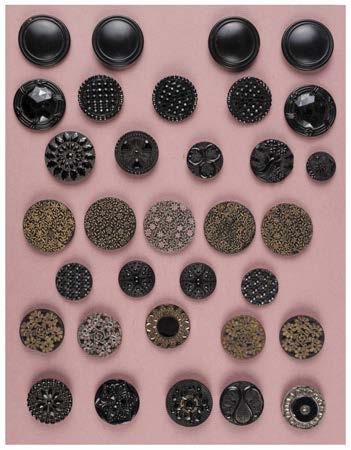
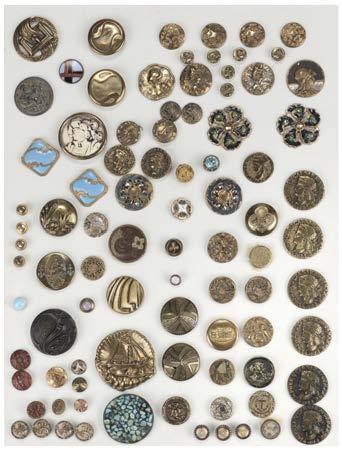
£100 - £150
645* Fashion Buttons. A collection of approximately 175 fashion buttons, mostly early 20th century, including many black glass (some inlaid with mother-of-pearl), some possibly jet?, also some silvered metal, and filigree, designs include: crane tortoise and butterfly, floral and foliate, cameo-style busts, passementerie effect, and other ornamental, one ceramic, few resin, various sizes and shapes, mounted on 9 card display boards (28.5 x 21 cm and smaller) (approx. 175)
Each lot is subject to a Buyer’s Premium of 20% (Lots marked * 24% inclusive of VAT @ 20%)
£150 - £200
646* Fashion Buttons. A collection of approximately 400 fashion buttons, mostly early 20th century, including silvered metal, brass, jet(?), enamelled, filigree, etc., designs include floral, eagles and other birds, dragons, people, knights on horseback, heraldic symbols, Roman coin style, sailing ships, various sizes and shapes, mounted on 9 card display boards (29 x 20.5 cm and smaller) (approx. 400) £200 - £300
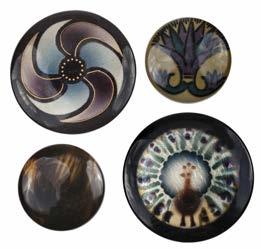

647* Fashion Buttons. A collection of approximately 420 fashion buttons, mostly early 20th century, including silvered metal, brass, pierced metal, glass (some marbled), resin and other plastics, shell/mother-of-pearl and pearlised plastic, wood, designs include: floral, fish, heads, seashells, horse’s heads and horseshoes (including a pair with saddle, horseshoe & whip motif), Roman coinlike, a pair of metal buttons depiting a charioteer, another showing 3 people in a boat, a few Oriental-themed (lady with parasol in a garden, lady with large parasol, Oriental scenes, a lady riding a large fish, etc), and a few animals including birds, snails, dragonflies, various sizes and shapes, some small sets, including a set of 6 Czechoslovakian red or blue glass 4 cm buttons, with silvercoloured dragonfly, on original display card titled La Mode, all mounted on card display boards (29.5 x 22.5 cm and smaller), this group also includes a set of 144 small shell(?) buttons still mounted on the orignial display card and in original card box with lift-off lid (box probably originally contained several cards of these buttons) (approx. 420)
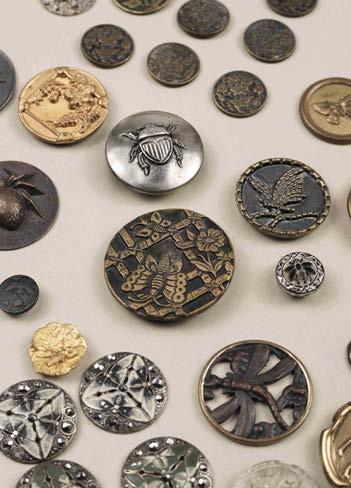
£100 - £150
649* Fashion Buttons. A collection of approximately 490 fashion buttons, mostly early 20th century, including mostly black glass (some possibly jet?, the majority small), various designs including geometric, floral, deer heads, one with a basket, sickle & rake emblem, a larger button with croquet mallet and hoop design, also including a quantity of mother-of-pearl or pearlised buttons, mostly larger sized, some with metal ground, few abalone, various shapes, some in small sets, mounted on 7 card display boards (29.5 x 21.5 cm and smaller), also including a complete original sample sheet of mother-of-pearl/pearlised buttons titled Superior Guaranteed Quality Make, with printed sizes (approx. 490)
£150 - £200

648* Fashion Buttons. A collection of approximately 475 fashion buttons, mostly early 20th century, including various metals (brass, silvered, etc.), glass (especially marbled ball-shape), pierced metal, filigree, mother-of-pearl, enamelled, resin and other plastics, the designs include: seated lady (goddess?) with dogs, floral and foliate, several with insects (butterflies, beetles, bees or wasps, praying mantis?, a dragonfly, also spiders, crowns, a Scottish thistle, several birds (owls, peacocks, hens or cockerels, swallows, etc.), various sizes and shapes, mounted on 9 card display boards (25.5 x 19.5 cm and smaller) (approx. 475)
£200 - £300
650* Fashion Buttons. A collection of approximately 500 fashion buttons, mostly early 20th century, including metal (few copper), glass (including several clear), resin/plastic, ceramic, enamelled, leather, designs include: floral, foliate and fruit, beetles, Art Nouveau, fox heads, elephants, cameo-type busts, a few with Egyptian themed designs (mainly heads of, or seated, pharaohs), a few dog-related, various shapes and sizes, some small sets, mounted on 17 card display boards (29.5 x 21.5 cm and smaller) (approx. 500)
£200 - £300



651* Fashion Buttons. A collection of approximately 545 fashion buttons, mostly early 20th century, including resin and early plastics, silvered metal, brass, and other metals, glass, pierced metalwork, filigree, enamelled, some with inlaid mother-of-pearl, and one button with embroidered pattern (passementerie?), the various designs include: Archangel Michael slaying the dragon, lion & unicorn, other animals including dragons, deer, foxes, birds, a butterfly, various heraldic symbols and emblems, Tudor rose and Scottish thistle buttons, fleur-de-lis, horseshoes, a seated lady (goddess?) with dogs, a lady holding a parasol, a seated yokel feeding (?) a dog & being watched by two country women, various other figures and heads/busts (some mythological), floral and foliate designs, few painted designs including a ship (rubbed), various sizes and shapes, mounted on 10 card display boards (28.5 x 19.5 cm and smaller) (approx. 545)
£200 - £300
652* Fashion Buttons. A collection of approximately 545 fashion buttons, mostly early 20th century, including silvered metal, brass, enamelled, filigree, resin, glass etc., designs include floral, animal heads (including fox) and other animal and bird designs, a knight’s head, a lady’s bust, swastika, Art Nouveau, and two large enamelled buttons, each depicting a gentleman, hat in hand, presenting a flower to a lady, various sizes and shapes, mounted on 10 card display boards (28.5 x 20 cm and smaller)
Provenance: The Alison Lean Button Collection. (approx. 545)
£200 - £300
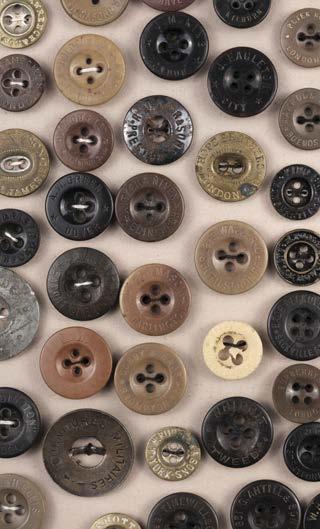
653* Fashion Buttons. A collection of approximately 620 fashion buttons, mostly early 20th century, including metal (a few filigree), glass, some resin, the majority wholly or partially mother-of-pearl/pearlised plastic, mainly ornamental designs, but also including some floral, foliate, stars, an anchor (engraved), a flying bird, 4 buttons made from small cowrie shells, various shapes and sizes, some small sets, mounted on 14 card display boards ( 28.5 x 20.5 cm and smaller) (approx. 620)
£200 - £300
654* Fashion Buttons. A collection of approximately 300 fashion buttons, 19th century and later, including brass, gilt metal, wood, ceramic and composite buttons, some art nouveau period with stylised whiplash design, others include maritime and Viking longboats, presented on 18 card boards for display (approx. 300)
Each lot is subject to a Buyer’s Premium of 20% (Lots marked * 24% inclusive of VAT @ 20%)
£200 - £300
655* Fashion Buttons. A quantity of fashion buttons, mostly early 20th century, including various metals (brass, silvered, pewter, pierced, etc., and one passementerie-style), resin and other plastics (eg. celluloid), glass (including black), horn, wood, fabric-covered/sewn, porcelain and other ceramic, designs include: heraldic symbols eg. 3 cannons in a shield, ships, floral and foliate, mushrooms, animals, heads, coin-like, and a large number with maker’s names on, eg. Apsey & Wood, Landy & Berlin, King Bros, Burberrys, Hope Brothers, Westoby, Will Hill, many from the London area but also Dover, Manchester, Birmingham, Romford, Kilburn, N. & S. Shields, Derby, Batavia, Taiping, etc., most buttons mounted on card display boards, some loose, all contained in 1 large and 4 smaller cloth-covered boxes (A carton)
£100 - £150
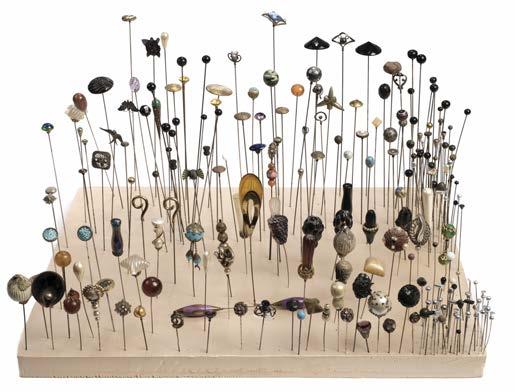
656* Hatpins. A large and impressive collection of hatpins, Victorian and later, including an Edwardian silver hatpin by Charles Horner, Chester, 1907, the top with a silver swallow, 17 cm, an Edwardian silver thistle hatpin by Charles Horner, Chester 1904, the thistle top set with a purple stone, 24.5 cm, a similar silver hatpin by Charles Horner, Chester 1923, the interlaced top inset with a ball, 27.5 cm, together with several other silver examples including an Edwardian silver hatpin, the top with a silver cat design with red glass eyes, the reverse stamped ‘Silver’, 28.5 cm, a Continental winged Scarab hatpin, silver and enamel stamped ‘800’, 18 cm, and various other types including a Japanese Satsuma hatpin, the top with a pottery panel depicting a geisha girl, damaged, 29.5 cm, military hatpins and fashion hatpins (approx. 200)
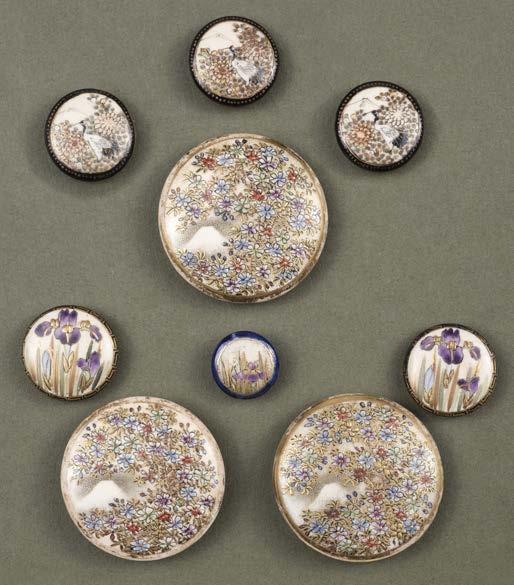
£300 - £500
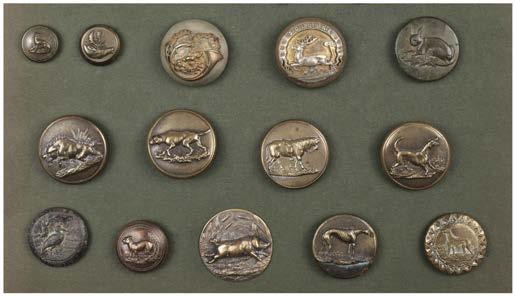
657* Hunt Buttons. A collection of 140 Edwardian hunt buttons by R James, Birmingham, a rich gilt metal each bearing the initials B & D in a gothic script (unidentified), 23 mm diameter, mounted on 6 card sheets (missing 10 buttons from the set) with original card box (tatty), together with a board containing 35 mixed hunt brass buttons, including a set of 8 showing game, hounds, huntsman etc, reverse stamped ‘Treble Standd Extra Rich’, 29 mm diameter (175)
£150 - £200
658* Japanese Satsuma Buttons. A collection of Japanese Satsuma pottery buttons, Meiji Period (1868-1912), including 3 large buttons each decorated with Mount Fuji surrounded by flowers in red, blue and green enamels, highlighted in gold, 45 mm diameter, 3 smaller buttons decorated with a crane amongst flowers and Mount Fuji in the background, red cross within circle mark to the reserve, 25 mm diameter and other buttons, presented on a card board for display (9)
£150 - £200

659* Livery Buttons. A collection of 132 livery buttons, 18th/19th century and later, brass, silvered and pewter including crests and armorials of Oppenheimer, Fortescue, Ellison, and Wilkins, many other crests and makers including Pitt & co, Jennens & co, Hayward, John Ollivant & co, E. Armfield & co, 1 mounted on card board, 4 in plastic sleeves for display (132)
£200 - £300

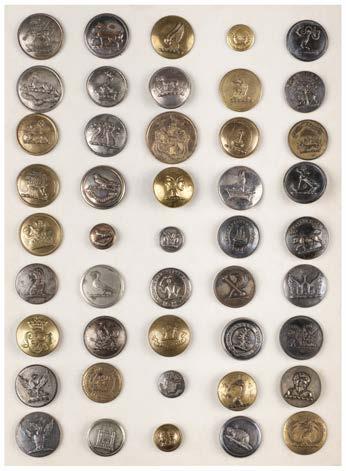
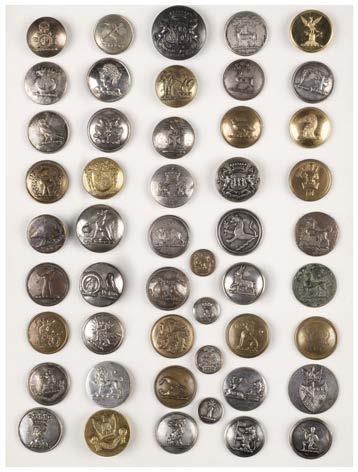
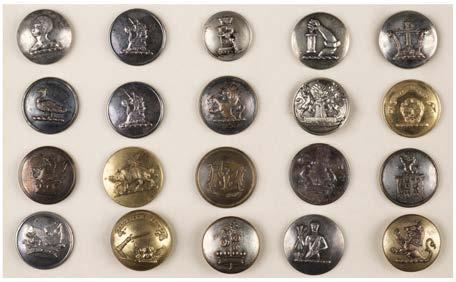
660* Livery Buttons. A collection of approximately 200 livery buttons, 19th century and later, brass, silvered and pewter, family crests including Stanhope, Borlase family, Taylor Clan, Trevelyan family, The Gurdon Family and many other crests, makers include A.J. Robins, Harding & Messenger, Firmin, Boggett & Reynolds, Armfield's mounted of 5 card boards for display
(approx. 200)
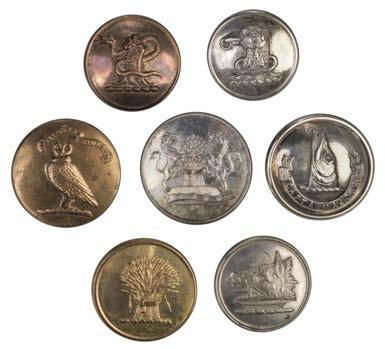
£200 - £300
661* Livery Buttons. A collection of 224 livery buttons, 19th century and later, brass, gilt metal and silvered metal many different crests and armorials including that of William FitzHardinge Berkeley, 1st Earl FitzHardinge (1786 -1857, six buttons), Edward VII Royal household livery button (early 20th century), Duke of Hamilton, Bunten family, and Goldsmiths' Company, etc., manufacturers include Firmin & Sons, Jennens & Co, J. Platt & Co, G.R. Collis & Co, Simpson & Co, R.E. Hayward, mounted of 5 card boards for display (225)
£200 - £300
662* Livery Buttons. A collection of 225 livery buttons, 19th century and later, brass, gilt metal and silvered metal, with various crests and armorials including the of Earl of Ashburnham, the Douglas and Ridley family etc., various manufacturers including Firmin & Sons, Pitt & Co., H & W Towell and W. Dowler, mounted of 5 card boards for display (225)
£200 - £300
663* Livery Buttons. A collection of 225 livery buttons, 19th century and later, brass, gilt metal and silvered metal many different crests and makers including G & H Bullivant, Hammond Turner & Sons, E. Armfield & Co, Firmin & Sons, Jennens & Co, family names include Mackenzie, Thurlow, Traill and livery button with armorial of Sir John Ingilby, 1st Bt. of Ripley Castle, mounted together on 5 card boards for display (225)
Each lot is subject to a Buyer’s Premium of 20% (Lots marked * 24% inclusive of VAT @ 20%)
£200 - £300
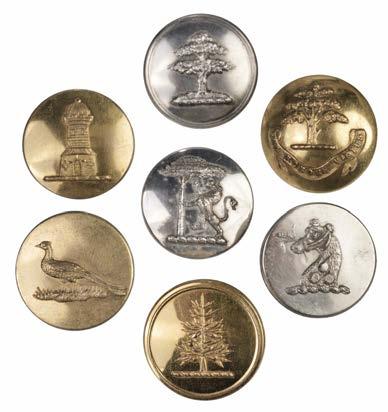

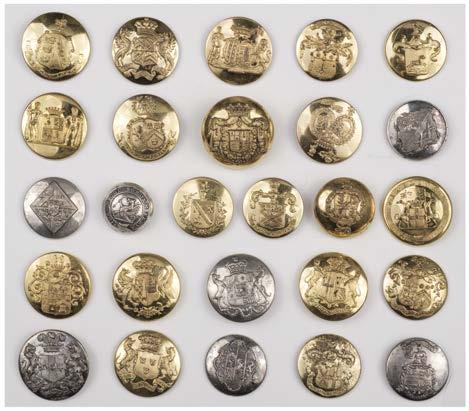
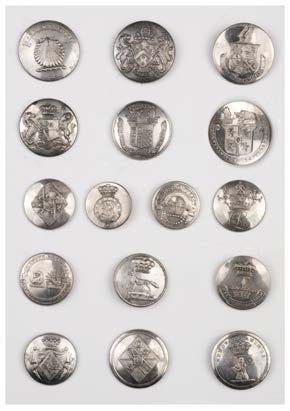
664* Livery Buttons. A collection of approximately 180 livery buttons, 19th century and later, brass, gilt metal and silvered metal many different crests Collins Trelawny, Hamilton, Geddes, and makers including Charles Jennens, Hardings & Sons, Firmin & sons, W Dowler & Sons, Jennens & Co, displayed in 8 plastic wallets (approx. 180)
£200 - £300
665* Livery Buttons. A collection of approximately 200 livery buttons, 19th century and later, brass, gilt metal, silvered metal, armorials of the Mansel family, Clan Muir, Patton Family and The Watson-Armstrong Family, many different makers including Jennen's & Co, G. Pitt & Co, H & W Towell, Edwd Armstrong, presented on 5 card boards for display (approx. 200)
£150 - £200
666* Livery Buttons. A collection of approximatly 160 livery buttons, 19th century and later, brass, gilt metal and silvered metal many different crests, Ash, Irvine, Aikman, and makers including Charles Jennens, Hardings & Sons, Firmin & sons, W Dowler & Sons, Jennens & Co, displayed in 7 plastic wallets (approx. 160)
£200 - £300
667* Livery Buttons. A collection of livery buttons, 19th century and later, including seven silvered buttons by Firmin & Co, London, with a heraldic unicorn surmounting a corinet, together with similar pewter cap badge, 40 mm long, another group of seven brass buttons by Pitt & Co, each with a heraldic stallion surmounting a coronet plus six smaller from the same livery, other buttons include a brass example by J.B. Williams, Liverpool, with the crest of the Liverpool Education Comittee, six silvered buttons each bearing the motto Fortuna parcet labori (By fortune and labour) and others (approx. 200)
£200 - £300
668* Livery Buttons. A fine collection of 85 livery buttons mostly 19th century, including a silvered button with crest of the Drake family of Buckland, Devon) by M.S. & J.D., showing a galleon over a globe with a rope leading to an arm with motto 'Auxilio Divino' (by divine aid), 28 mm diameter, together with various highly gilt and silvered buttons with various crests and armorials, including the crest of Sir Basil Francis, Baronet, D.L., of Dunglass, Haddington, showing a stalk holding in its dexter a stone, with the motto 'Dat cura quietem' (Prudence gives rest), 28 mm diameter, a livery button bearing the armorial of Andrew Duncan (1773-1832), other livery buttons with the armorials of the Baikie, Berkeley, Geelhand, Hall, and Routh families etc., makers include Jennens & Co, presented on 4 card boards for display (85)
£200 - £300
669* Livery Buttons. A fine collection of 95 livery buttons mostly 19th century, including silvered button by Charles Jennens with the Hope-Vere family crest, showing a broken globe surmounted by a rainbow issuing out of clouds at each end, 26 mm diameter, another with the crest of the Cunningham family of Scotland with the motto 'Over Fork Over', 28 mm diameter, another for the Strickland family of Dawlish, Devon, showing a turkey with the motto 'A la volonté de Dieu' (at the will of god), 26 mm diameter, and many other crests and armorials including Viscount Anson, Earl of Kinnoull, Lord, Cahier and families of Berkeley, Briscos, Hope, Mansel, etc., makers including Doughty & Co., Jennens & Co, presented on 6 card boards for display (95)
£200 - £300
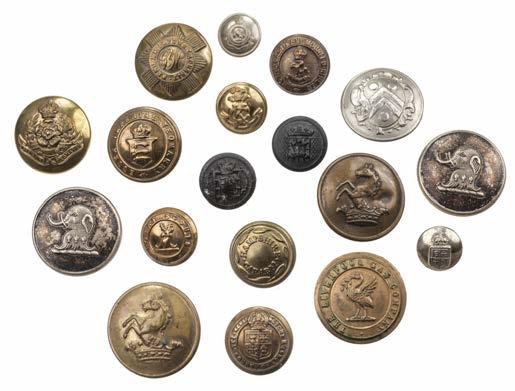
670* Livery Buttons. A mixed collection of livery buttons, 19th century and later, many loose, some presented on card boards for display, including one silvered button of the Hall family with a stalk holding its dexter claw and the motto ‘Curo Quietem’ (prudence gives rest) by Pitt & Co, another gilt metal button of the Macpherson Clan, with a cat and the motto ‘Touch the cat not the glove’ by Charles Jennens and other liveries, a large and unsorted collection contained in a small box (small box)
£150 - £200
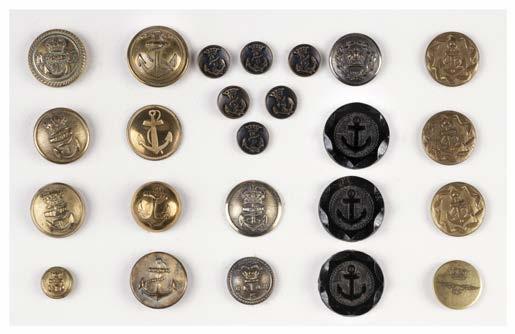

674* Scottish Hunt Button. A George III silver hunt button, circa 1800, finely engraved with a fox jumping over thistles, unmarked, 26 mm diameter and scarce
A similar example is held in the collection of the Aberdeen Archives, Gallery & Museums.
(1)
£100 - £150
£300 - £500
671* Maritime Buttons. A collection of approximately 495 Naval, Maritime, Shipping, Customs, Yacht Club buttons, 19th century and later, brass, gilt metal and silvered metal, black glass and other types, including Royal Navy, German Navy, Norddeutscher Lloyd Bremen, African Royal Mail, Glasgow & Highlanders R.M.S. Steamer, Cunard, Royal Welsh Yacht Club, Trinity Lighthouse Service, Northern Lighthouses, Clyde Navigation, Australian Steamships Line and many others, various makers including ‘Stokes & Son, Melbourne’, ‘Firmin & Sons’, ‘Lewis’s Liverpool’, ‘Kenning & Sons’, presented on 11 card boards for display (approx. 495)
672* Military Buttons. A large collection of military buttons, approximately 450, late Victorian and early 20th century, including Supply Transport Corps, Royal Army Ordnance Corps, West Lincolnshire Volunteers, Royal Scots Greys, Rifle Brigade, Royal Marines, Queen’s Own Cameron Highlanders, Nova Scotia Highlanders, Indian Staff Corps, Australian Commonwealth, King’s African Rifles and many more, presented on 16 card boards for display, not all complete (approx. 450)
£200 - £300
673* Mixed Buttons. A large collection of unsorted buttons, mostly fashion from the early 20th century onwards, many types including horn, ceramic, composite and metal, contained in old tins, boxes and files
(1)

£200 - £300

Each lot is subject to a Buyer’s Premium of 20% (Lots marked * 24% inclusive of VAT @ 20%)
675 Society, Corporation & Transport Buttons. A collection of approximately 420 buttons, including Manchester Transport, North Eastern Railway, British Railways, Bank of England, Ipswich Golf Club, Hawk’s Club, Metropolitan Police, British Red Cross Society, General Post Office, Danish State Police, Victoria Masonic Lodge, Exchange Assurance, Crystal Palace Great Exhibition 1851 uniform button, and many others, presented on 11 card boards for display (approx. 420)
£200 - £300
676* Sporting Buttons. A Victorian tennis button, gilt metal, showing crossed tennis rackets above a net, the reverse with a registration mark on the reverse, 22 mm diameter, together an art deco silvered golfing button, showing a female golfer, 30 mm diameter, a silver button for West Middlesex Golf Club by Firmin and hallmarked Birmingham 1912, 25 mm diameter, plus other buttons including fishing, skiing, archery and cricket, presented on 2 card boards for display, together with a mixed collection of buttons including a set of 6 Guinness waistcoat buttons, in original card box, a cased set of 6 button studs each with a different profile of a dog and other buttons (approx. 50)
£100 - £150

Peta Smyth's London shop on Moreton Street was, for four decades, a mecca for those in search of beautiful antique textiles. Discerning collectors and interior designers alike found inspiration from the array of treasure within, sometimes discovering just the right piece to go with an existing scheme, or even finding the perfect impetus for a wholly new one. At any one time 16th century tapestry fragments or 18th century Aubusson tapestries might be jostling alongside luscious velvets and sumptuous brocades, early crewelwork and other needleworks, or beautiful cushions, curtains and passementerie. Early exposure to textiles in the form of outings to markets and drapers' shops with her mother, and embroidery lessons at her convent school, helped form an affinity with the subject which was to prove invaluable when a career change in her thirties led Peta to set up a stall in the Portobello Road, after working for Joanna Booth. A small share of Robert Hales' shop in Kensington Church Street followed, before Peta moved to her own shop in Moreton Street, Pimlico, in 1983. Wonderful and rare items which passed through that establishment, sometimes being restored along the way, can be found in interior settings all over the world, in both private dwellings and important historic houses owned by the National Trust. In Peta's own words: 'I have loved my work and the greatest pleasure has been in buying tapestry, needlework and textiles in bad condition and having them restored and thus giving them new life.'
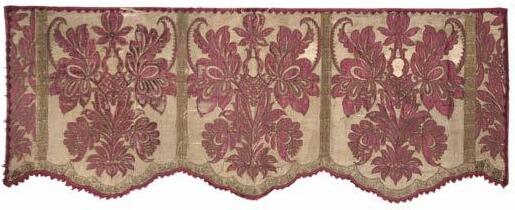
677* Appliqué Pelmets. A set of cloth of gold and red damask pelmets, probably Spanish, late 17th century, 3 large matching pelmets, each with 3 scalloped panels featuring a large exotic flowering plant in appliquéd red damask, edged with couched gold metallic thread, on a gold thread ground, backed with coarse linen, the sections separated and edged with gold metallised braid, worn, with ground uniformly threadbare, losses and some darkening to appliqués, stitched consolidation in places, 20th century tufted red edging (covering tack holes to top edge) and red cotton backing (latter partially faded, and slightly worn to lower edge in places), each approximately 74 x 197 cm (29 x 77.5 ins)
(3)

679* Aubusson Tapestry. A border, late 17th century, a woven border cut from 3 sides of a large tapestry, depicting roses, tulips, chrysanthemums, and other flowers, fig leaves, and scrolling acanthus leaves, in shades of blue, green, brown, and cream, occasional fraying to outer edge, width 21.5 cm (8.5 cm), overall length 4.31 m (169.5 ins)
(1)
£400 - £600
£1,000 - £1,500

678* Appliqués. A collection of 16th & 17th century embroidered appliqués, metalwork and coloured silk thread embroidery, using a wide variety of stitches, and depicting various birds, insects, animals, vegetal, and decorative motifs, etc., e.g. a crewelwork ho ho bird, a lion, a pear tree, a fleur-de-lys, a moon with face, together with several 19th century wool embroidered animals, various condition, approximately 10 x 38 cm (4 x 15 ins) and smaller (43)

680* Balouch Kilim Runner. A long woven runner, late 19th/early 20th century, hand-woven in shades of brown, pink, black, purple, red, yellow, white, and green, with geometric patterns in horizontal bands, a few small holes, 19 cm (7.5 ins), long fringe to one short edge (worn with losses), dimensions without fringe 251.5 x 78 cm (99 x 30.75 ins)
£400 - £600
(1)
£100 - £200
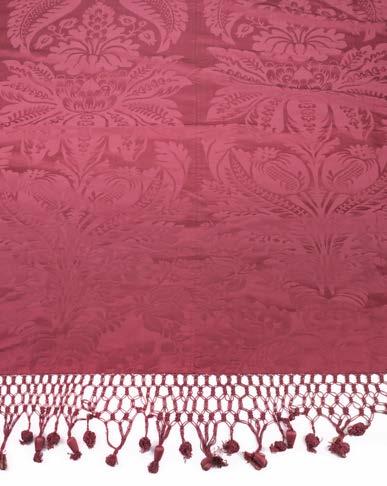

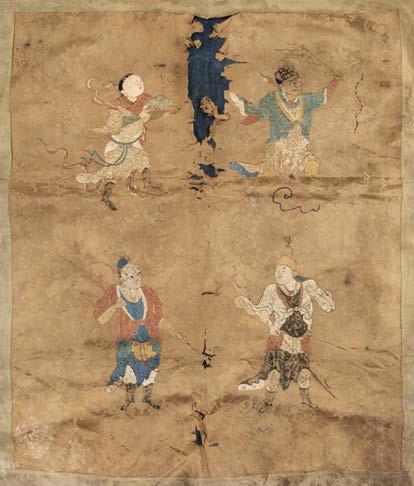
681* Bedcover. A red silk damask coverlet, French, 19th century, consisting of 5 joined machine-stitched widths, patterned with large displays of stylised flowers and leaves, occasional small marks and faint discolouration, bordered on 3 sides with knotted trellis fringing terminating in tassels and baubles (17 cm long), latter becoming unravelled in places, and with a number of the baubles split, 244 x 265.5 cm (96 x 104.5 ins) not including fringe
(1)
£700 - £1,000
682* Brocade panel. A large silk brocade panel, probably Russian, 19th century, pieced panel woven with alternate small and larger stylised flower motifs, in pink silk and dark thread on a gold ground, off-centre vertical join, some light discolouration and minor loose threads, with high relief looped border of silver metallised thread towards upper edge (worn, revealing supporting thread bundles), the panel with braid edging and set between gold geometric borders top and bottom, a wider gold metallised border of floral urns at foot (with some loose and lost threads), mounted on a stretcher, 187 x 80 cm (73.5 x 31.5 ins)
Provenance: Sotheby’s, Paris, Collection Du Baron De Redé, Provenant De L’Hôtel Lambert, 16th & 17th March 2005, probably lot 908.
(1)
£500 - £800
683* Chinese Panel. A panel of silk damask embroidered with figures, probably 18th century, stitched with four male figures, including a warrior, one holding an incense burner, and another holding a flag, hand-worked in long and short stitch in coloured silk threads, each figure 43 cm (12.5 ins) high and slightly smaller, some losses to threadwork revealing pencil outlines, on a gold silk damask ground (perished with losses to vertical crease between figures), border of gold silk (with some stains and small holes), top edge and backing of blue linen, backing with Chinese script in black ink (marked, holes to lower edge), 127 x 91 cm (50 x 36 ins), plus a pieced panel of Chinese yellow silk cloud damask, probably 18th century, machine-stitched joins, frayed with losses (especially to edges), 124.5 x 89 cm (49 x 35 ins), and a Chinese gold velvet chair back depicting dragons, probably 17th century, backed with linen, damaged with losses, 185 x 53 cm (73 x 21 ins), together with:
Chinese Ancestor Portrait. A double ancestor portrait, late Qing Dynasty, pen, ink, and gouache, highlighted in gold, on paper, depicting an Oriental gentleman and his wife seated, rubbed, some losses, especially to upper edge (only marginally affecting image), carefully conserved and laid down on paper support, 112 x 89.5 cm (44 x 35.25 ins), mounted on a modern scroll, 177 x 103 cm (69.5 x 40.5 ins)
(4)
Each lot is subject to a Buyer’s Premium of 20% (Lots marked * 24% inclusive of VAT @ 20%)
£200 - £400
226
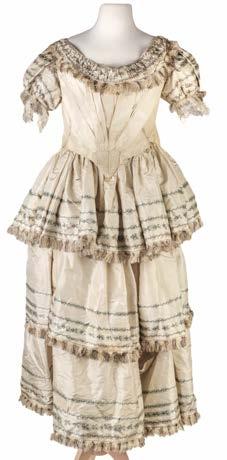
684* Cothing. A mid 19th century silk bodice and matching skirt, hand-stitched, the cream silk fitted bodice with wide neckline, v-shaped waist, short puffed sleeves with lace flounce, and eyelets for lacing, the neck and sleeves of cream silk with geometric floral borders in black, pink, and green, on a pale turquoise stripe, skirt composed of 3 tiers of the same striped silk, bodice and skirt edged with cream, black, pink, and green fringe, organza underskirt, some light staining and marks (underarms stained and perishing), a few small holes and tears, 1 layer of skirt with loss of stitching at seam, bodice: bust 78 cm (30 ins), sleeves 21.5 cm (8.5 ins), skirt: waist 66 cm (26 ins), length 91.5 cm (36 ins), together with 2 ostrich feather and tortoiseshell fans, one blue, and the other red and cream, each 66 cm (26 ins) (4)
£200 - £300
Lot 681 Lot 682 Lot 683
685* Curtains. A pair of curtains and matching pelmets made from 18th century crimson silk damask, two long curtains, hand and machine-stitched, with large stylised design of flowers, fruit, and leaves, outer and lower edges with matching tufted silk fringe, top of curtains box-pleated and with 4 small brass rings, occasional small marks and tiny holes, one curtain with old printed and manuscript French label of J. and H. Barroux stapled to edge, width of each ungathered 51.5 cm (20.25 ins), drop 261.5 cm (103 ins), and a pair of matching unstructured gathered pelmets, a few small marks and holes as before, lined with red twilled cotton, wide self ruffle to top edge, and tufted fringe as before to lower edge, fabric tape with tack holes to upper edge verso, height 33 cm (13 ins), top gathered edge 233.5 cm (92 ins)
(4)
£400 - £600

686* Cushions. Three cushions of Flemish tapestry, probably Oudenaarde, circa 1580-1600, the front of each utilising a fragment of 16th century tapestry, some discreet expert restoration, depicting: a pair of satyrs each blowing a horn, a pair of bearded men, and a flower urn, each backed with dark gold velvet, and with matching green and gold tasselled edging, each 45 x 35 cm (17.75 x 13.75 ins)
(3)
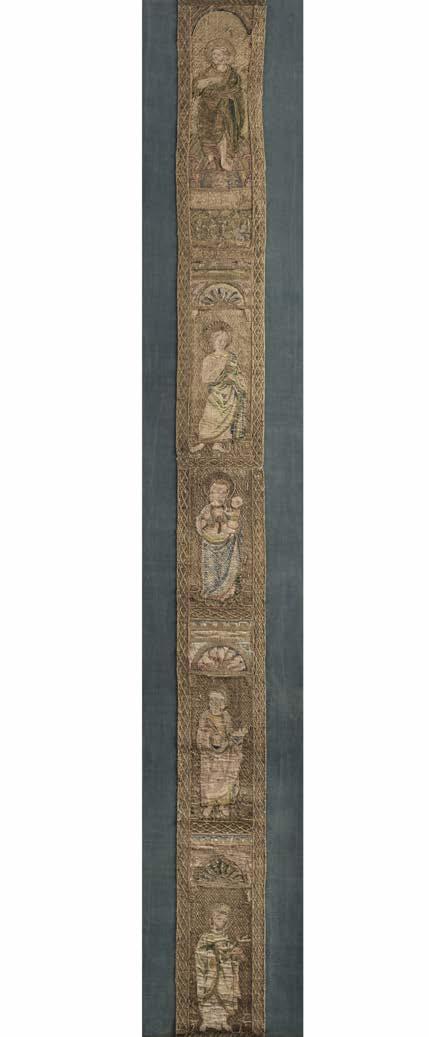
£600 - £800
687* Embroidered Orphrey. An ecclesiastical needlework panel, probably Spanish or Italian, 1st quarter 16th century, long band of gilt metalwork and silkwork on linen, mainly couched, but also using satin stitch, stem stitch, latticework, etc., depicting 5 saints (top to bottom): a saint holding a book and pointing to it, possibly St Paul; St John the Evangelist, holding a serpent in a chalice; the Virgin and Child; St Stephen holding a book and a palm frond; and St John the Baptist, holding a book, lamb, and flag, the 4 male saints each within an architectural niche, a lattice border dividing each section and to outer edge, uniform wear with losses, especially to silk threads of figures, 214.5 x 18.5 cm (84.5 x 7.25 ins), expertly stitchmounted on sea-green twilled linen and framed (221 x 42 cm) (1)
£800 - £1,200
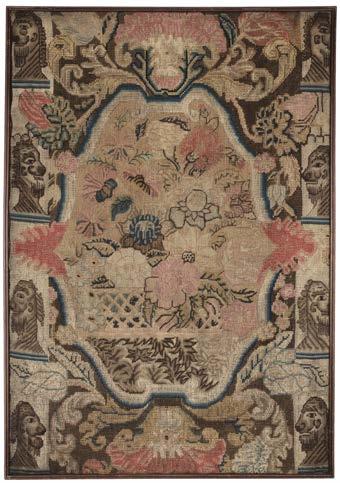


690* Fabric. A collection of red 18th century moreen and 19th century worsted, 9 panels and portions of fabric, some irregularly shaped, various condition, largest (with central join) 4 x 2.13 m (157 x 84 ins), smallest 63.5 x 69 cm (25 x 27.25 ins)
Provenance: Raby Castle, Co. Durham; Christie’s, Raby Castle Co. Durham, 10-11 October 1994.
£400 - £600
688* Embroidered Picture. A large needlework picture, English, 18th century, worked in cross-stitch and tent stitch in coloured wools on canvas, the central cartouche with a basket of flowers, surrounded by volutes and floral decorations, flanked by columns of portrait busts of stylised men in profile, threadbare in places, 75.5 x 52 cm (29 3/4 x 20 1/2 ins), framed (77.5 x 54 cm) (1)

(9)
£200 - £300
691* Fabric. A collection of textile fragments, 17th-19th century, including: a panel of woven flamestitch, Northern France, first half of the 18th century, threadbare in places, 40.5 x 78 cm (16 x 30.75 ins); two panels of woollen velvet, France or Flanders, circa 1700, the largest somewhat threadbare and frayed, 41 x 61 cm (16.25 x 24 ins), and slightly smaller; a fragment of joined 17th century English turkeywork, threadbare in places, 30 x 38 cm (11.75 x 15 ins); two Italian 17th century border pieces of linen embroidered in red silk, a little worn, with small losses, each 31 x 33 cm (8.25 x 13 ins); a small irregular fragment of an English embroidered coverlet, circa 17101730, 70 x 27 cm (27.5 x 10.5 ins) at largest points; and a small panel of 19th century Krefeld voided velvet, 52 x 19 cm (20.5 x 7.5 ins) For a very similar design to one of the velvet panels see V&A accession number T.477-1996. (13)
£200 - £400
689* Embroidered Picture. The Sacrifice of Isaac, English, 17th century, oval needlework picture worked in tent stitch on canvas in shades of pink, blue, brown, and yellow, depicting Abraham with sword raised above a cowering Isaac’s head, a ram caught in the bushes beside a tree, and an angel in clouds above, some small theadbare areas and minor wear (notably to lower right), 33 x 26 cm (13 x 10.25 ins), glazed oval frame (39.7 x 32.8 cm) (1)
£200 - £300
692* Fabric. A long length of 18th century red silk damask, with large pattern of stylised flowers and leaves, incorporating a flaming heart pierced by an arrow, atop a large book with clasps, flanked by a pair of putti holding a coronet, a loom width, with green-striped selvedges, worn, with some holes, darns, and narrow patches to edges, 6 m x 84 cm (236 x 33 ins), together with a pair of loom-width lengths of 19th century red silk damask, with large urn and flower pattern, top and bottom edges raw, one piece with a few spots of discolouration and a short closed tear (2.5 cm), the other with some staining at ends, each 320 x 66.5 cm (126 x 26.25 ins), another loomwidth long length similar, some scattered very small holes, a few marks to left-hand edge, 363 x 66 cm (144 x 26 ins), and a small loomwidth piece of 19th century red silk damask depicting large poppy seed heads and flowers, 98.5 x 52 cm (38.75 x 20.5 ins) (5)
£400 - £600
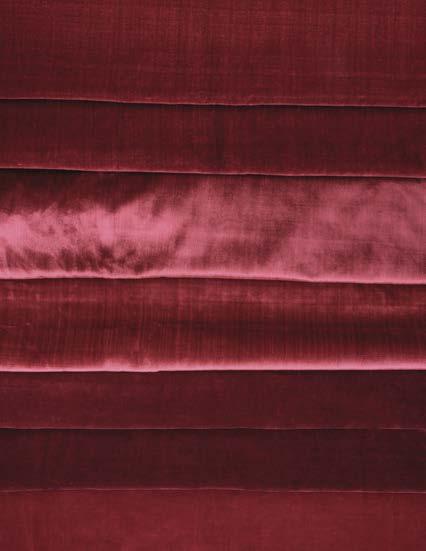

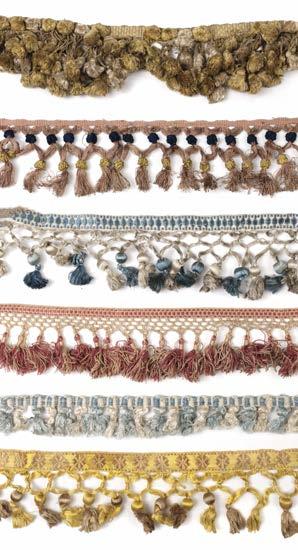
693* Fabric. A quantity of red silk velvet, mainly 19th century, 19 portions of silk velvet in varying shades of red, mostly repurposed from seat covers, etc., some irregularly shaped, and variously hemmed, unpicked, or with raw edges, mostly in good condition, largest 48 x 157.5 cm (19 x 62 ins), smallest 41 x 60 cm (16.25 x 23.5 ins)
(19)
£600 - £800
694* Marche Tapestry. A panel depicting figures in a landscape, France, 16th century, woven wool panel, depicting a prosperous gentleman in the centre with his arms bound behind his back, restrained by a soldier on his right, and with a bearded monk on his left, a tree on a grassy mound and buildings in the background above, taken from a larger piece, recently lined and edges bound, 173 x 73 cm (68 x 28.75 ins)
Probably showing Judas’s betrayal of Jesus, with the figures dressed in the attire of the 16th century.
(1)

£500 - £800
695* Needlework Panel. An early 18th century English needlework panel, worked in tent stitch in coloured wools with silk highlights, using shades of blue, green, red, beige, and cream, on a dark brown ground, depicting a crested parrot in the centre, surrounded by other birds perched on sinous floral and foliate branches, a bounding dog with tongue hanging out below, some minor loss of threads and old repairs, cut to an irregular oval shape, approximately 81 x 66 cm (32 x 26 ins), loosely stitch-mounted to 2 layers of brown felt (89.5 x 74.5 cm), together with 9 other needlework panels, including 4 seat covers, 2 18th century (restored), and a portion of a floral needlework panel of circa 1750
Provenance: Christie’s, London, ‘The Mayorcas Collection of Tapestries and Textiles’, 12th February 1999, lot 8A; Sotheby’s, London, ‘Classic English Furniture: The Norman Adams Legacy 1923-2009’, 21st April 2009, lot 43. (10) £300 - £400
696* Passementerie. A collection of lengths of fringing, 17th-19th century, comprising: a royal blue knotted fringe, 9 cm x 6.5 m; a green and white knotted bobble edging, 9.5 cm x 1 m (2 lengths joined with stitching); a pale blue and cream knotted bobble edging, 8.5 cm x 1 m; a yellow knotted bobble edging, 8 cm x 3 m overall (5 separate lengths); a dark cream, green, yellow, and peach tasselled edging, 6.5 cm x 1 m overall (2 separate lengths); a terracotta and dark cream knotted fringe, 8.5 cm x 6.5 m overall (2 separate lengths); a pink and dark cream knotted tasselled edging, 7 cm x 5 m overall (4 separate lengths); a blue and gold fringe, 7 cm x 2.5 m; a wide scalloped cerise tasselled edging, 22 cm (at longest point) x 1 m overall (2 separate lengths); a cream knotted edging with green and terracotta tassels, 5 cm x 14 m; a pale blue and ivory tasselled edging 4.5 cm x 9.6 m; a scalloped gold and cream tasselled edging, 9 cm (at longest point) x 2.5 m, and another 3 short lengths similar (3 m total); and a terracotta edging knotted with blue and yellow, 8 cm x 8 m, measurements approximate, various condition (a carton)
£200 - £400
Lot 695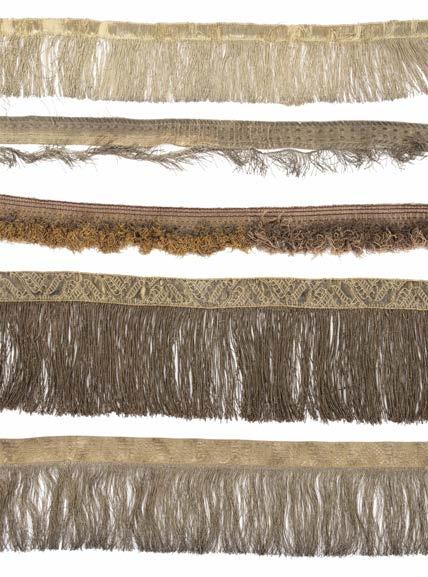

697* Passementerie. A collection, 18th & 19th century (and possibly earlier), gold and silver metallised fringe edgings, various condition and sizes (a carton)
£500 - £800
698* Passementerie. A collection, 18th & 19th century (and possibly earlier), gold and silver metallised edgings, including lace, gimp braid, fringings, plaited cord, etc., various condition and sizes (a carton)
£500 - £800

699* Passementerie. A collection, French, late 19th century, comprising: 6 lengths of elaborate tassel edging, cream and purple silk thread-wrapped wooden forms, suspended on twisted cord sewn to a muslin edge, 16 cm wide, each approximately 140 cm long; a length of elaborate tassel edging, cream, pink, and green thread-wrapped wooden forms, suspended on twisted cord attached to narrow braid, 12.5 cm wide, approximately 6.5 m long; a length of bobble edging, cream and cerise thread-wrapped spherical forms, suspended on twisted cord attached to narrow braid, 5.5 cm wide, 8 varying lengths (7 m, 5 m, 4 m, 3 m, 2 m, 1 m, 500 cm x 2)
(3)
£300 - £500
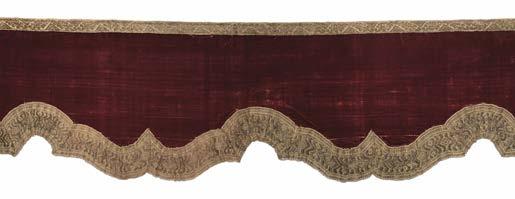
700* Pelmets. A pelmet of 17th century red silk velvet, a little rubbed in places, and with a couple of small stitched repairs, gold metallised braid along top edge, and wide gold metallised braid along undulating lower edge, backed with hessian, and further later backing of red damask, 38.5 x 233.5 cm (15.25 x 92 ins), together with a pair of 19th century French crimson silk velvet pelmets, some small marks and a few tiny holes, bordered all round with gold metallised braid, and with 8 cm gold twisted fringe to scalloped lower edge, backed with peach cotton (some discolouration and marks, and a few stitched repairs), small hanging rings to top edge verso (not matching, some missing), each 49 x 165 cm (19.25 x 65 ins) including fringe
(3)
£300 - £400
Lot 697 Lot 698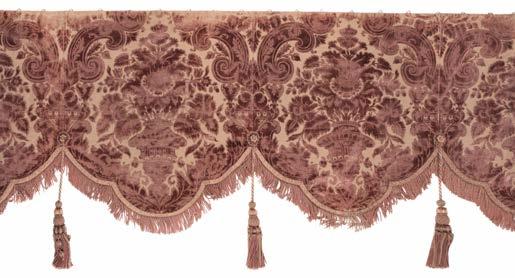
701* Pelmets. A pelmet of voided velvet, French, circa 1900, large pelmet of pink voided velvet, depicting flower urns, with foliate motifs and large drawer handles between, upper edge rubbed and faded (with some short edge splits), lower scalloped edge trimmed with braid and twisted fringe, and caught up with 7 substantial tassels each hanging from twisted cord on a silk boss, tassels rubbed (with some losses to silk thread covering, and one tassel with small part of wooden form missing), gold twilled cotton lining (discoloured and marked), small brass curtain rings sewn to upper edge verso, height including tassels 80 cm (31.5 ins), length 4.11 m (162 ins), together with an irregularly shaped fringed pelmet of 18th century red silk damask, 37 x 164 cm (14.5 x 64.75 ins)
(2)
£200 - £300
702* Pilaster Hanging. A large velvet and cloth of gold panel, Portuguese, early 18th century, comprising 3 joined hangings of appliquéd black velvet (replaced in the 19th century) on a gold metallised thread ground, the appliqués outlined with couched gold metallised threads, designed with a large pattern of stylised flower heads, blossom, and leaves, lined, and with border of later gold metallised braid, ground with scattered uniform loss of gilt threads, some loose threads and stitched consolidation, 7.62 m x 58.5 cm (300 x 23 ins)
(1)
£600 - £900


703* Pilaster Hangings. A pair of velvet and cloth of gold panels, Portuguese, early 18th century, appliquéd black velvet (one with velvet replaced in the 19th century), on a gold metallised thread ground, the appliqués outlined with couched gold metallised threads, designed with an ogival lattice pattern enclosing a flower head, hessian backing and edge-binding, edges fraying and rebound in places, overall wear, with loose threads, and some stitched consolidation, each approximately 267 x 56 cm (105 x 22 ins)
(2)
£600 - £900
704* Sedan Chair. A set of shelves in the form of a sedan chair covered with early fabrics, Paris: Debaise, 23 Place Vendôme, early 20th century, open-fronted wooden sedan chair, with pedimented top, and shaped base, fitted with fabric-covered shelves and vertical dividers inside, the back and sides of the chair covered with heavy woven fabric appliquéd with 17th and 18th century large flower and volute motifs in brocades and velvets, the two sides each inset with a bevel-edged mirror, and with metal carrying handles (one of the four missing), remains of gilt lettered leather maker’s labels ‘A Debaise 23 Place Vendôme’, and patent labels ‘Brevete S.G.D.G.’ to inside of pedimented top, heavily worn, with some damp-staining to lower shelf, 112.5 cm (44.25) high, 56 cm (22 ins) wide, 50.5 cm (19.75 ins) deep
A most curious and unusual set of shelves or display unit; we cannot trace another similar, nor have we been able to discover the nature of Debaise’s business, which operated from the magnificent 18th century building, 23 Place Vendôme in Paris, which is now home to Cartier.
(1)
£100 - £200

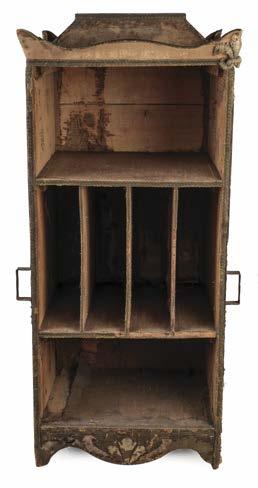



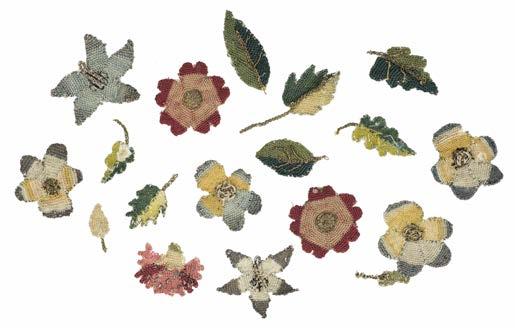
705* Slips. A collection of early 17th century English embroidered slips, worked in coloured silk and metallised threads, comprising flowers and leaves, 4.5 x 4 cm (1.75 x 1.5 ins) and smaller, together with a number of narrow plaited gold stems and tendrils, 21 cm (8.25 ins) and shorter
Provenance: Previously used to decorate the court presentation gown worn in 1937 by enamellist and painter Marit Guinness (1919-2004). (100+)
£400 - £600
706* Tapestry Runners. A collection of 6 runners of 18th century Aubusson tapestry, each woven in coloured wools to various patterns (2 matching), recently backed, with gold edging braid all round, and gold twisted fringe to short ends, 21 x 91 cm (8.25 x 35.75 ins) not including fringe, and slightly smaller (6)
Each lot is subject to a Buyer’s Premium of 20% (Lots marked * 24% inclusive of VAT @ 20%)
£200 - £400
707* Tapestry Runners. A collection of 6 runners of late 17th/early 18th century tapestry, Aubusson & Flemish, each woven in coloured wools to various patterns, all recently backed (some with old fabric), all but one with gold edging braid all round and gold twisted fringe to short ends, the other with a woollen braid edging, 25 x 125 cm (10 x 49.25 ins) not including fringe, and slightly smaller (6)
£300 - £400

708* Thread. A collection of gold and silver thread, 19th/20th century, 12 wooden spools, 6 of gold thread, and 6 of silver thread, including some twisted threads, one stamped ‘Courtaulds Ltd’, one reel with portion of spool end missing, 11 cm (4.25 ins) high, 5.5 cm (2.25 ins) diameter, and smaller (12)
£200 - £300
709* Wallpaper. Ten matching rolls of wallpaper, circa 1920, thick textured wallpaper, printed with an 18th century style vertically scrolling design of large flowers, fruit, and leaves, on a horizontally striated ground, in shades of pink, blue, and green, with brown outlines, highlighted in gold, edges marked ‘foreign’ and with monogram ‘NTHB’ and number ‘786’, some chipping and fraying to edges (mainly at start of rolls), width 56.5 cm (22.25 ins) (10)
£200 - £300



710* Appliqué Panel. An 18th century Chinese-style appliqué panel, numerous polychrome cotton appliqués of Chinese origin, embellished with embroidery stitches in coloured silks, and mounted using buttonhole stitch on a black silk ground (a loom width, with selvedges to left and right) backed with coarse fabric, the appliqués including a cockerel, a stork, flowers, a fish, butterflies, etc., top and bottom edges raw, silk ground rubbed and perishing in places, with some edge-fraying, backing worn (with losses to edges), 207 x 55 cm (81.5 x 21.5 ins) (1)
£300 - £400
712* Bedcover. An Arts & Crafts embroidered patchwork bedcover designed by John Aldam Heaton (1830-1897) and worked by his sister Fanny Heaton (1828-1893), English, 2nd half 19th century, large patchwork coverlet, expertly embroidered in a variety of stitches, including stem, chain, satin, and bullion stitch, comprising: 9 red squares in centre, each embroidered in white thread with a different botanical spray, including dog roses, fuchsias, foxgloves, tiger lilies, blackberries, and acorns; smaller blue squares, embroidered in white with a circular motif, at intersections (connected by stitched wavy lines in red on a cream ground) and corners (connected by a dainty scrolling floral border in pink and red on a cream ground); a cream border of red-stitched floral or foliate sprigs, including primroses, morning glory, carnations, and vine leaves, left-hand side with 7 x 4 cm pale brown stain; and an outer scrolling border of red berries and leaves on a cream ground, with blue circular cornerpieces repeated, occasional light spotted marks but overall in very good condition, backed with white cotton (one side with some spotting and stains), edges bound in blue, 253 x 258.5 cm (99.5 x 102 ins)
Provenance: John Aldam Heaton and his sister Fanny Heaton; their great niece Evelyn Spence Addison (1891-1962); her daughter Jean Cecil Edwards née Addison (1923-2013); her son, the present owner.
The owner donated a similar embroidered bedcover to the V&A, also designed by John Aldam Heaton and worked by his sister Fanny (accession number T.213-1989).
John Aldam Heaton was an artist, designer and businessman, who started off as a wool and textile manufacturer in Bradford, before moving to the ancient farm of ‘Woodbank’ in Yorkshire in 1860. Influenced by the Pre-Raphaelite movement, he designed furniture, stained glass, wallpaper and textiles, and counted Dante Gabriel Rossetti, William Burne-Jones, and William Morris amongst his friends. Indeed, in 1861 Heaton invited Rossetti to paint a portrait of his wife, Ellen, and the artist stayed a month at ‘Woodbank’ in order to carry out the commission. The painting, Regina Cordium [Queen of Hearts] - Portrait of Mrs Ellen Heaton, subsequently formed the basis for a stained glass window for the house, a commission which was one of the first undertaken by Morris & Co.
£500 - £800
711* Bedcover. A large broderie perse bedcover, English, circa 1810-1830, handstitched coverlet, with a variety of appliqués in pink, blue, and brown, on a cream cotton ground, comprising: 6 paeony flowers in centre within a frame of scrolling leaf sprays, surrounded by floral sprigs, and enclosed by a foliate border with floral triangle inner border and leaf sprays at outer corners; a border of palm trees and floral motifs enclosed by a repetition of the foliate, triangle, and leaf spray border; foliate border repeated in a chevron pattern, with large floral appliqués either side, including passion flowers, paeonies, roses, and tulips; outer floral border, including narcissi, carnations, roses, and wheat ears, a number of the appliqués with holes or tears (mostly unobtrusive), 1 x 1 cm hole in ground, 5 cm cream fringed border all round, 272 x 228 cm (107 x 90 ins) excluding fringe (1)
Heaton was a member of the Neo-Classical Arts and Crafts Movement, and published several books about art and design, including Furniture and Decoration in England during the Eighteenth Century (1889-1892), Beauty and Art (1897), and a trade catalogue in 1895 showcasing ‘Chimney-pieces, Ornamental Lattice, Wall-papers, Frieze Painting, Blinds, Carpets, Furniture, Designs for Needlework, Embroidery, Curtains, Church Work, Stained Glass, Painting’. He set up workshops in Bloomsbury in order to undertake larger and more prestigious commissions, collaborating with many important artists as well as the architect Richard Norman Shaw. Working with Shaw, Heaton’s company produced lavish interior designs and furnishings for the White Star Line ships. After Heaton’s death the Aldam Heaton Company was incorporated into White Star and designed the interiors for the RMS Olympic, Titanic and Britannic. The V&A has several wallpaper designs by Heaton in its collection. Fanny Heaton married the eminent physician Dr John Deakin Heaton (no relation). She was a strong advocate for the education of women, and an early campaigner for women’s suffrage.
£700 - £1,000

713* Berlin Chart Playing Cards. Jeu des Petits Points, Paris: Alphonse Giroux, circa 1820, a complete piquet deck of 32 handcoloured engraved playing cards (French suits), each card printed with a fine grid in black, and hand-painted with a petit point chart illustration or motif to embroider, and a miniature playing card to top left corner (the courts full-length), subjects including children at play, flora and fauna, stag hunting on horseback, an alphabet, buildings, etc., plain versos, slightly rounded corners (from use?), a little dusty, several chipped to corners (10 of clubs with slightly larger loss to lower left corner), 1 or 2 short edge-tears, 9 x 6 cm (3.5 x 2.5 ins), all cards mounted with photo corners onto a black display board, encapsulated in clear plastic (42 x 59.5 cm), together with the lower half of the original pink cardboard box, front of box with a further Berlin chart and the publisher’s engraved label
Provenance: Collection of Dudley Ollis.
Illustrated: Verame, Sublime cartes à jouer, p.145.
714 Brass Rubbings. A set of seven brass rubbings on cotton, English, 1856, 7 large brass rubbings, black shoemaker’s wax on glazed white cotton, all with annotations and/or pinned fabric labels in sepia ink or pencil, several dated 1856, each depicting rubbings from brass effigies on tombs in Suffolk and Cambridgeshire, comprising: Thomas Peyton flanked by his first and second wives, Margaret Bernard and Margaret Francis, the three standing above an inscription and beneath a triple Gothic canopy, 1484, Isleham Church, Cambridgeshire; Jankin and Marion Smith, circa 1480, above John Fynches, Archdeacon, St Mary’s Church, Bury St Edmunds; Ann Butts flanked by armorial shields, 1609, Redgrave Church, Suffolk, below John and Elizabeth Garneys, 1524, Kenton Church, Suffolk; a man and a lady, Knodishall Church, Suffolk, above a number of rubbings from Yoxford Church, Suffolk, including Lady Johanna Brooke, 1618, Anthony Cooke, 1613, and a dog; Sir Roger de Trumpington wearing armour with a dog at his feet, 1289, SS. Mary and Michael, Trumpington, Cambridgeshire, 1289; William Malster, priest in Cope, 1492, and William Stevyn, priest in Cope, 1497, Girton Church, Cambridgeshire; a lady and man, with fabric tag in brown ink ‘Strettham’, selvedges to left and right, raw edges top and bottom, some light toning, marks, and stains, Girton torn along right-hand edge, largest 4.79 m x 81.5 cm (15 ft 7 ins x 32 ins), smallest 2.1 m x 80 cm (6 ft 9 ins x 31.5 ins)
A collection of early brass rubbings, unusually executed on fabric, rather than on paper. The practice of recording ecclesiastical monumental brasses through a process of rubbing originates from the Victorian Gothic Revival, which was flourishing in England by the middle of the 19th century. An early method of pouring printer’s ink into engraved lines and then placing damp tissue paper over the brass was replaced around the mid-nineteenth century with the more effective technique of using black shoemaker’s wax, known as heel ball.
(7)
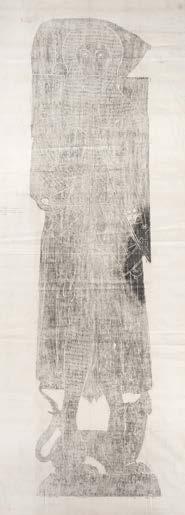
£300 - £500
£500 - £700
An exceptionally rare pack of early playing cards, serving a dual purpose: for playing piquet, and - most unusually - providing patterns for petit point embroidery. Embroidery on canvas by means of copying a coloured chart became very popular in the 19th century. Such work charts were first produced in the early nineteenth century in Berlin, Germany, hence their name, and they were exported in large numbers. Prior to the introduction of embroidery charts it was very rare to find needlework designs with any indication of colour choices or threads. Berlin patterns were always coloured by hand at first, until the emergence of industrial printing techniques, and early hand-coloured charts are now hard to find. Although such charts have passed through these rooms from time to time, we have never seen a deck of playing cards depicting embroidery patterns, and we have been unable to find another either at auction or in an institution. (1)

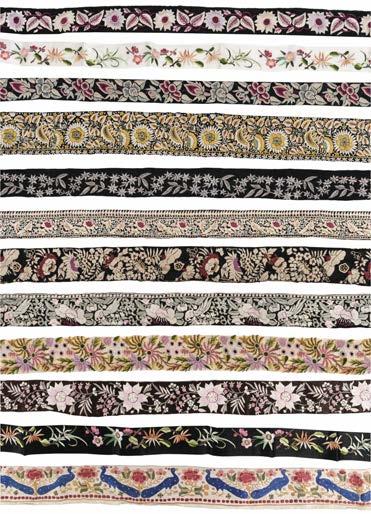
715* Chinese Dragon Robe. A kesi silk nine-dragon robe, late Qing Dynasty, full-length silk robe, finely woven in silver on a blue ground, with long sleeves and horse-shoe cuffs, depicting nine fiveclawed dragons, three on each side, one on each sleeve, and one on interior flap, densely surrounded by various other auspicious symbols, including clouds, bats, cranes, mountains and rocks, etc., wide lishui border to hem, cuffs and neck with border of symbols woven in gold on a black ground (3 cm fray to seam at neck), vent to centre of front and rear, bauble fasteners (adjacent fabric to one with 2 cm fray), lilac silk lining to cuffs a little discoloured and with some fraying to edges, lightly soiled inside neck, slightly frayed to right underarm, length 144.5 cm (57 ins), width cuff to cuff 147.5 cm (58 ins), together with a floral purple Cheongsam dress, early-mid 20th century, some minor discolouration and fading to lower portion, bust 82 (33 ins), waist 68 cm (27 ins), sleeves 24 cm (9.5 ins), length 133 cm (52.5 ins)
Provenance: Property of the owner’s mother, whose father was a rubber planter in Malaya (thought to have been gifted to her by her father in the decade before the Second World War, as he was interned in Changi when Singapore fell to Japan).
A beautiful Chinese dragon robe, in unusually good condition; the delicate finely-woven silk is robust and the colours vibrant. (2)
£700 - £1,000
716* Chinese Embroideries. A collection of needlework borders, 19th-mid 20th century, 14 hand-worked borders (2 matching), variously depicting flowers, foliage, and birds, on silk or cotton grounds of varying hue, occasional wear, but generally in good condition, 7 cm wide and slightly narrower, longest 687 cm (270.5 ins), with matching length 211 cm (83 ins), together with 5 woven or machine-embroidered borders similar, plus:
A pair of Chinese embroidered panels, late 19th/early 20th century, 2 matching panels hand-worked with mandarin ducks, herons, songs birds, moths, and butterflies, amongst water lilies, paeonies, and flowering almond trees, worked in polychrome silk threads on a cream silk ground, seams unpicked all round, some dust-soiling, mostly to edges, each 69 x 24.5 cm (27.25 x 9.5 ins), and a large embroidered cream silk panel backed with fine cotton, depicting birds and butterflies amongst a large stem of pelargonium flowers on the left, and another of chrysanthemums on the right, some marks and stains, 12 x 12 cm area towards lower edge perishing, 115.5 x 70.5 cm (45.5 x 27.75 ins), later 18 cm high border of cream cotton machine-stitched along upper edge (22)
£200 - £400

717* Chinese Panel. An embroidered panel, late 19th century, hand-worked in silk threads, in shades of blue, brown, and white, incorporating gold metallised threads, on a pale brown silk ground, with large circular motif composed of flowers, butterflies, and trailing volute decoration, and large cornerpieces of paeonies with Greek key decoration, lightly faded, a few small marks, and ground beginning to perish in a couple of places, 50 x 47.5 cm (19.5 x 18.75 ins), framed and glazed (52.5 x 50 cm), together with 4 other handembroidered textile items, including a small Chinese panel with figures and floral decoration, 19th century, a blue-green velvet cloth with wide embroidered border of botehs, possibly Persian, and another cloth, of metallised thread embroidery, probably Turkish (5)
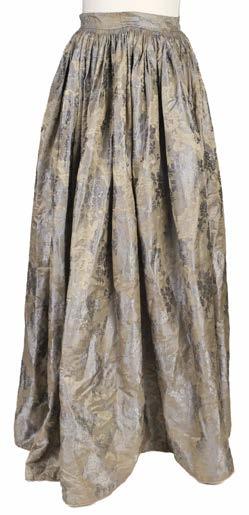
£150 - £200
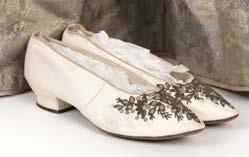
718* Clothing. A blue brocade skirt, circa 1850s, hand-stitched close-gathered silk brocade skirt, with pattern of meandering rose stems in blue, against a pattern of botehs and volutes in silver, on a pale blue ground, lined with brown glazed cotton, waistband with metal closure hook (no eye), lightly faded, some small patches of discolouration and beginning to perish in a few places, waist 61 cm (24 ins), length 109 cm (43 ins), together with 2 further skirts, 1 deconstructed with waist raw and ungathered, the other unfinished, plus:
A pair of Victorian shoes, circa 1860, cream leather shoes, the pointed toes embellished with glass beads and cut steel arranged in a pattern of flowers and leaves (a few small losses), lightly discoloured and marked in places, leather soles, heel 2cm (.75 ins), length 21.5 cm (8.5 ins),
A pair of leather half boots, circa 1830s/40s, white kid leather ankle boots, with rounded toe, hand-stitched eyelet holes at sides for lacing (not present) and tongue, stitched embellishment lacking from front (resulting in visible needle holes), lined with cream linen, some edge-stitching loose and frayed, flat leather soles, length 25 cm (9.75 ins), and 3 gentlemen’s waistcoats (8)
£200 - £400
Lot 717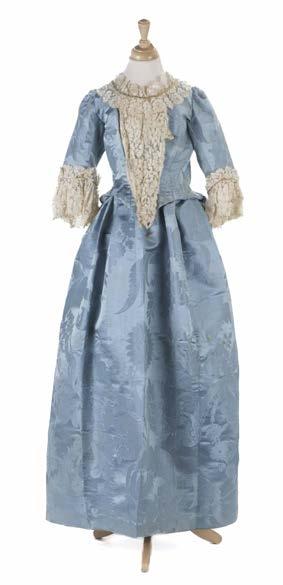
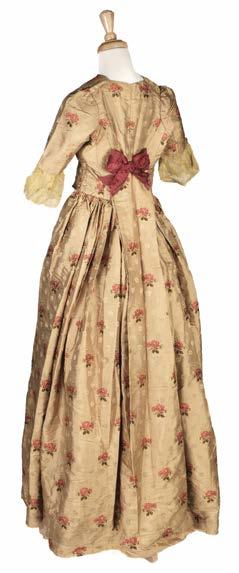
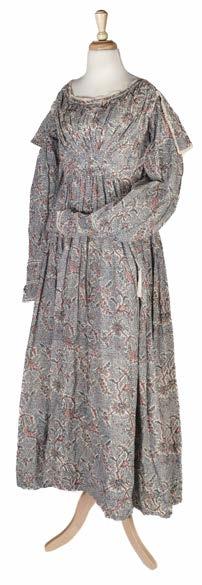

719* Clothing. A bodice and deconstructed skirt of silk damask, probably Spitalfields, circa 1745-50, b oned and fitted bodice of blue silk damask with large pattern of flowers and leaves, of later construction, stitched by hand and machine, probably intended for fancy dress, with elbow length sleeves trimmed with wide lace flounces, matching lace to neck and front, v-shape to waist front and back, and eyelets with lacing to back, sleeves coming unstitched slightly in a couple of places, bust 64 cm (25 ins), waist 48 cm (19 ins), sleeves 40.5 cm (16 ins), length 45 cm (17.75 ins), matching skirt with ungathered waist and hand-stitched hem, some light discolouration to bodice and skirt in places, width between pink-striped selvedges 56 cm (22 ins), length 98 cm (38.5 ins), entire width of hem (i.e. if side seam was unstitched) 188 cm (74 ins)
Provenance: The Haslett family, Shakespear House, Adelaide Park, Belfast, Northern Ireland.
Shakespear House was built in 1891 by Joseph Frederick Warden, who commissioned the construction of the Grand Opera House in Belfast in 1895. In 1918 Shakespear House was sold to John Haslett, a surgeon in the Royal Army Medical Corps, passing down three generations of the Haslett family until its sale in 2022, when the contents – an impressive array of antiques and historical pieces - were sold.
(2)
£500 - £700
720* Clothing. A gold brocade dress, 1840s, gown of gold figured brocade, woven with large flower sprigs in red and green, fitted bodice with v-shaped waist, metal hooks and stitched loops to front opening, and lined with cream twilled cotton, elbow length sleeves with chiffon flounce, close-gathered open-fronted skirt with inset calico pocket to right-hand side, rear of bodice with figured red bow and pleated train detail, occasional unobtrusive small marks (including some faint spotted red marks to train), bust 70 cm (27.5 ins), waist 56 cm (22 ins), sleeves 31 cm (12.25 ins), length 128 cm (50.5 ins)
(1)
Each lot is subject to a Buyer’s Premium of 20% (Lots marked * 24% inclusive of VAT @ 20%)
£200 - £300
721* Clothing. A printed nursing gown, circa 1835, cotton gown printed with small geometric pattern in blue, red, and brown, highwaisted gathered bodice with two nursing slits with buttonholes (now loosely stitched up), metal hooks and eyes to rear, and large shaped collar, long leg o’ mutton sleeves with double fitted cuffs (metal eyes present, but no hooks), partially lined close-gathered skirt with inserted muslin pocket on left-hand side, collar and sleeves edged with cream piping and narrow lace, some minor brown staining to one part of collar and to underarms, bust 74 cm (29 ins), waist 56 cm (22 ins), sleeves 67 cm (26.5 ins), length at front 140 cm (55 ins) and at back 131 cm (51.5 ins)
Rare early maternity gown, surviving in very good condition, with slits in the pleated bodice for nursing and a skirt which is longer at the front, to accommodate the growing abdomen. Before the mass production of clothing, garments solely for maternity wear were deemed an unnecessary expense. Instead, dresses were altered and adapted during pregnancy, or made to be easily altered afterwards. Here the pleated bodice allows for the slits to be concealed post-pregnancy, and the skirt length could easily be shortened at the front to match the back. Dresses such as this, therefore, rarely survive in their original state. The V&A has a nursing gown in its collection of a similar date to ours (accession number T.52-2015). (1)
£300 - £400
722 Clothing. A Regency silk pelisse, circa 1810-1820, handstitched high-waisted cream silk coat, with frilled round collar and long sleeves, latter gathered and puffed at the shoulders, with crossing bands, and gathered double frill cuffs, cream zig-zag braid trimming to collar, cuffs, front edges, hem, and narrow self bow to rear of waist, scattered holes and marks, collar becoming detached, 10.5 x 2 cm darn to lower left of right-hand front panel, sleeves 56.5 cm (22.25 ins), length 109 cm (43 ins), together with a Regency yellow silk dress, with puffed sleeves and padded hem trimmed with gold metallised lace embellished with spangles and beads, and a Regency yellow silk bodice with long sleeves terminating in quilted cuffs, both somewhat worn (3)
£200 - £400
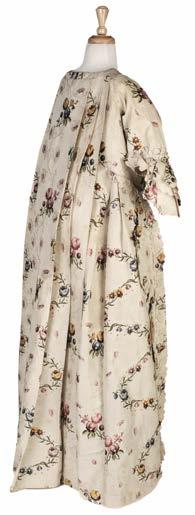

723* Clothing. A Robe à la Français, probably of Spitalfields silk, circa 1750-1770, open-fronted brocade dress, with woven meandering pattern of polychrome flower stems, on a figured cream silk ground, with sack back pleating falling from back of neck to the floor, elbow-length sleeves with 3-layered fall cuffs of graduating size, and self ruffle trimming down front of gown (becoming loose in places), bodice lined with cream twilled calico and silk, with 6 metal hooks present (several lacking), occasional small marks, stains, and minor discolouration, a few splits to sleeves (including underarms), sleeves 44 cm (17.25 ins), length 137 cm (54 ins)
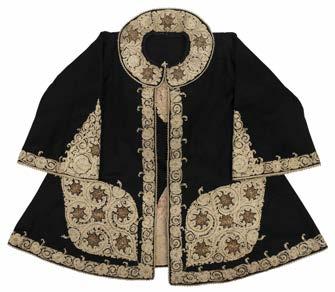

725 Clothing. An Albanian metalwork coat, 19th century, black woollen short flared coat with round neck (collar detached) and long flared sleeves, heavily hand-embroidered in chain and bullion stitch to front and rear in gold metallised threads, incorporating spangles, with large motifs composed of stars and volutes, and scrolling borders, several small holes (mainly to rear), chest 97 cm (38 ins), sleeves 51 cm (20 ins), length 80 cm (31.5 ins), together with a matching shield-shaped portion of metalwork, 16.5 x 14 cm (6.5 x 5.5 ins), and a child’s metalwork waistcoat similar, chest 80 cm (31.5 ins), length 36 cm (14.25 ins)
(3)
£200 - £400
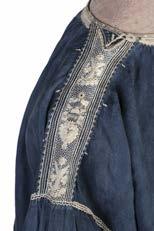
A wonderfully preserved eighteenth century Robe à la Français of the kind worn for formal occasions between the 1750s and 1770s. Designed to be worn over hoops or panniers, the wide expanse of the skirts of such gowns, and the fullness of the sack back, showed off the beautiful and expensive silk brocades which were so fashionable during the 18th century. (1)
£1,000 - £1,500
724* Clothing. A silk pierrot bodice, circa 1780s, hand-stitched brocade jacket (Spitalfields silk?), patterned with flowers in terracotta, yellow, and white, on a citrus green ground, with fitted bodice lined with linen, elbow length sleeves with self scallopedged double flounces and bows, self scallop-edged trim down front edges, and peplum skirt to rear, some wear and later reworkings, bust 74 cm (29 ins), waist 64 cm (25 ins), sleeves including flounces 50 cm (19.75 ins), length 61 cm (24 ins), together with 2 other bodices of 18th century silk brocade, plus: A late 18th century silk waistcoat front, hand-stitched silk brocade waistcoat front with standing collar (complete without a back), woven with birds and vegetal motifs in shades of blue, pink, green, yellow, and orange, and silver metallised threads (some lost or loose), on a cream figured ground, silk a little perished to upper and lower edges, front with 7 (of 8) spherical filigree metal buttons, lined with linen, length 45.5 cm (18 ins)
The waistcoat is an interesting item, presumably fashioned in such a way as to use the minimum of valuable fabric, without compromising the impression of affluence given by the wearer, so long as a coat is worn to conceal its backless design.
(4)
£150 - £250
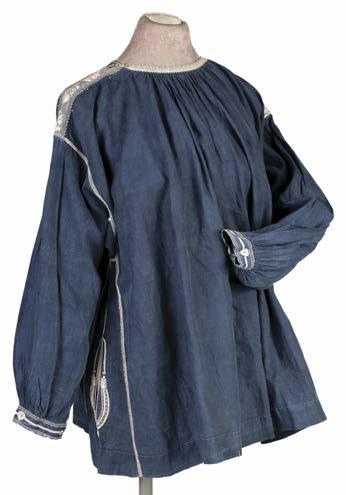
726 Clothing. An embroidered tunic, circa 1910, expertly handstitched unstructured smock-like tunic of indigo blue cotton, embroidered in white cotton thread, with long sleeves, round neck close-gathered with tiny decorative stitches, and side slits (for pocket access?), neck with button and loop closure at each side, neck, shoulders, sleeve seams, cuffs, and side seams, with finely embroidered decorative borders, incorporating floral and foliate motifs, and hearts, using a variety of stitches, including chain, buttonhole, feather, and laced running stitch, scattered marks and faint soiling, a few tiny holes, 15 x 4 mm burn hole to rear, pit to pit 85 cm (33.5 ins), sleeves 49 cm (19.25 ins), length 72 cm (28.25 ins) An exquisitely made garment, evidently sewn by an expert needlewoman. It may have been made for a competition, although it shows signs of having been worn, perhaps as an artist’s smock.
(1)
£150 - £200
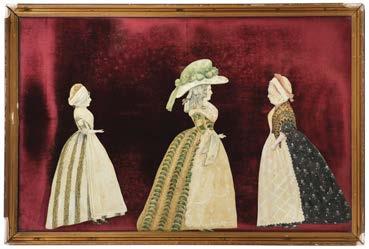
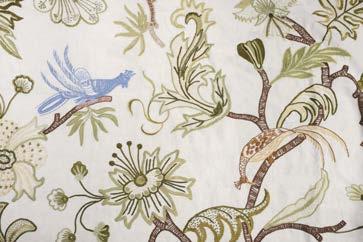
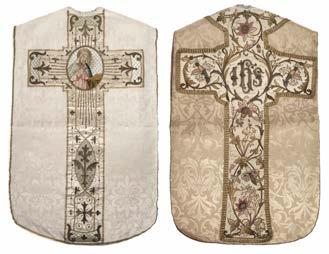
727* Cut-out Figures. Two framed painted cut-out full-length portraits of 18th century ladies, including Augusta Smith, wife of Richard Smith, Surgeon, circa 1785, the first with full-length scissor cuts of 4 ladies in profile, the details of features and dress painted in watercolour and gouache, some toning and staining, three annotated to hem of skirts in contemporary brown ink: 'Miss Archer 1785'; 'Mrs. Augusta - wife of Mr. Richard Smith, Surgeon AD 1785'; and 'Mrs Bertha Catcott', the fourth figure that of Mrs Smith's maid, largest figure 30.5 x 17.5 cm (12 x 7 ins), mounted on gold satin, framed and glazed (42.5 x 84 cm), the second with a repeat of three of the figures (without Miss Archer), a little light toning and foxing, mounted on red velvet, framed and glazed (42.5 x 63.5 ins), annotated with figures' names on backboard
Provenance: By descent from Augusta and Richard Smith to the great great granddaughter of their son Henry Smith, the current owner.
Augusta, daughter of the Reverend Alexander Stopford Catcott, married Richard Smith of Bristol on September 23rd, 1771. Richard Smith was a master at the Free Grammer School in Bristol, and on December 6th, 1774, he was elected Surgeon to the Infirmary there. In 1783 the couple were known to be living in Queen Charlotte Street, Queen Square, Bristol, but in December, 1785, the Smiths left Queen Square and took a house by College Green, opposite the Church of St. Augustine the Less, near to Bristol Cathedral.
Augusta and Richard had two sons, Richard and Henry, both of whom are remembered for their involvement in an unfortunate death. Henry Smith (1774-1840), a Bristol attorney-at-law and amateur artist, was forced to flee the country in 1809 after fighting a duel in which his opponent later died from loss of blood, having been shot in the leg. His subsequent travels around Scotland, and later Spain and Portugal during the Peninsula War, where he served in the army under Wellington, were recorded in a diary (1809-1810) which is now kept at the University of Kansas. He subsequently returned to England for trial, but was exonerated. Richard Smith (1772-1843) was, like his father, a surgeon at Bristol Infirmary. Amongst other things, he is known for his anatomisation of executed criminals, and in particular his association with John Horwood, aged 18, who was publicly hanged for the murder of Eliza Balsum, an older girl with whom he was infatuated. When Eliza rejected his advances, he threw a stone at her, striking her on the head as she crossed a stream. She died a month later, after Richard Smith had performed the risky operation of trepanning on her (drilling a hole in her skull to relieve pressure). At that time anatomisation was part of the punishment for murder, and the convict's body was given over to Smith at the Bristol Infirmary for his anatomy class. Gruesomely, the surgeon had Horwood’s skin preserved and tanned, and then used it to bind into a volume the notes he had collected on the trial, including sketches of Horwood. (2)
£400 - £600
728* Embroidered Bedcover. A large coverlet, 1930s, handembroidered in coloured silk threads, in shades of pink, blue, green, yellow, and brown, worked in a variety of stitches, including stem, buttonhole, long and short, star, bullion, feather, etc., on a cream mixed linen/cotton ground, with all-over pattern of large floral and foliate sinous stems, with exotic birds perched in the branches, occasional light marks, mostly to edges, one bird with some loss of stitching, 259 x 228.5 cm (102 x 90 ins) (1)
Each lot is subject to a Buyer’s Premium of 20% (Lots marked * 24% inclusive of VAT @ 20%)
£200 - £400
729* Embroidered Chasubles. Two ecclesiastical garments, 20th century, each of damask lined with silk, and with lavish embroidery to front and back in coloured threads and gilt metalwork, much of it in high relief, the embroidery probably re-purposed from earlier (19th century?) chasubles, some wear to silk or satin ground of needlework, one with consequent stitched repairs and occasional small loss of motifs, one chasuble with matching stole and chalice cover, chasubles 108 x 65 cm (42.5 x 25.5 ins) and slightly smaller (4)
£150 - £250

730* Embroidered Panel. An Arts & Crafts panel, English, circa 1890, hand-worked in wool in shades of green, blue, brown, red, orange, and yellow, using a variety of stitches, including satin, long and short, stem, french knots, seed, chain, lazy daisy, and latticework, on a ground of 12 joined beige linen squares, depicting a tree in each section, variously flowering or fruiting, 5 flanked by birds, occasional small holes and loss of threadwork (lower right square with 1.5 x 2.5 cm hole and adjacent loss of stitching), each 32 x 30.5 cm (12.5 x 12 ins), each edged with blanket stitch, and joined with interlaced herringbone stitch (some loss), remains of latter to outside edge indicating a previously large panel, 134 x 85.5 cm (52.75 x 37.5 ins), together with 2 further matching squares joined together Probably previously part of a wall hanging or bedcover.
(2)
£200 - £300
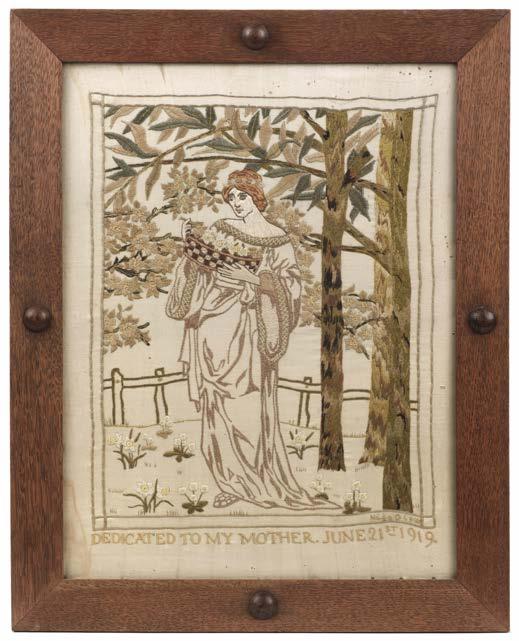
732* Embroidered Picture. An Arts & Crafts picture of Flora, by Nida Glew, 1919, hand-stitched in silk threads in shades of brown, orange, green, yellow, and cream, using long and short, satin, stem, and lattice stitch, and french knots, on a ground of cream silk, depicting the goddess Flora in a flowing robe holding a basket of flowers, a circle of flowers in her hair, standing amongst daffodils and primroses beneath a blossoming tree, stitched maker’s name lower right and dedication along lower edge ‘dedicated to my mother. June 21st 1919.’, scattered small holes, mostly to blank margins, stain to lower left blank corner, 47 x 36 cm (18.5 x 14 ins), Arts & Crafts oak frame with bosses at centre of each side, (56.5 x 45.5 cm)
(1)
£100 - £150
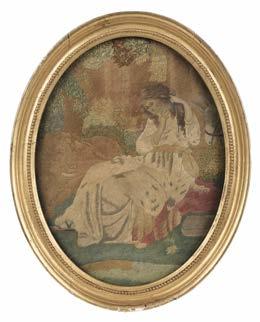
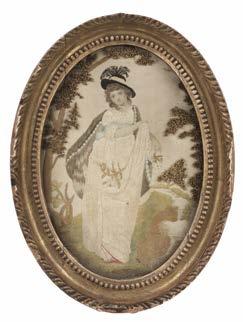
733* Embroidered picture. Oval picture of a young girl wearing a bonnet, circa 1790-1810, hand-worked in coloured silks on a cream silk ground, using satin stitch, long and short stitch, and stumpwork, depicting a young girl standing in a landscape, her face and hands finely delineated in watercolour, holding a bag of wild flowers, 23 x 16 cm (9.25 x 6.5ins), period gilt oval frame, glazed (glass cracked), together with another oval picture of young girl seated with a lion and a donkey by her side, circa 1790-1810, handworked in coloured silks on a cream silk ground, using satin stitch, long and short stitch, and stumpwork, 32 x 24 cm (12.5 x 9.5 ins), period gilt oval frame, glazed (2)
£200 - £300
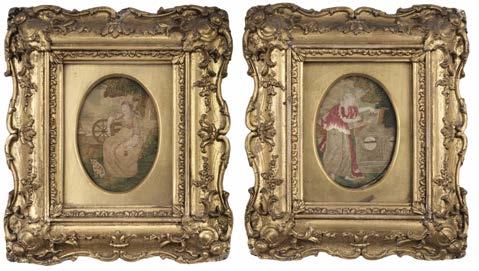
734* Embroidered Pictures. A pair of oval embroideries, circa 1790, stumpwork and long and short stitch in polychrome silk threads on silk, the faces, arms, and feet carefully delineated in pen and ink, and the sky in watercolour (lightly toned), the first depicting a young lady seated beside a spinning wheel in front of a cottage, a cat sitting at her feet, and a sailing ship in the background, the second with a female deity strewing flowers over the tomb of Shakespeare, each 11.5 x 8 cm (4.5 x 3.25 ins), matching oval gilt mounts and gilt moulded frames (26 x 23.5 cm) (2)
£150 - £200

735* Fabric Collage. Still-life of flowers in a vase, possibly Continental, 18th century, oval still-life of flowers in a doublehandled vase, including a sunflower, carnations, Tudor roses, tulips, lilies, and daisies, composed of layered fragments of coloured silk laid on card, some discolouration and small losses, mounted on an oval of brown fabric laid on card (some edge-stains and short tears), 31 x 25.5 cm (12.25 x 10 ins), laid down on a grey painted background, framed and glazed (41 x 36.5 cm)
Provenance: Collection of David Battie.
(1)
£400 - £600

736* Fabric. A collection of 18th century fragments, some probably Spitalfields, 12 pieces of silk, all woven with floral patterns, incorporating silver or gold metallised threads, some irregularly shaped, some matching, including 3 pieces of brocade woven with flowers and volutes in silver on a cream ground, with highlights in blue and green, with old label attached written in sepia ink ‘Mrs Acland: my Great Grand-Mother’s wedding Gown sent me by my mother July - 1820 ELTJ’, with further (later) note of provenance, and a piece of silk woven with a flower and lattice pattern in silver, with old label attached written in sepia ink ‘part of my Grandmother Lady Hoare’s Wedding Dress - She was Daughter of Mrs Acland’, approximately 137 x 48.5 cm (54 x 19 ins) and smaller, various condition
The three matching pieces of brocade with provenance notes attached were part of the wedding gown of Anne Burrell (circa 1696-1771). Anne was the daughter of Peter Burrell of Beckenham and his wife Isabella, daughter of John Merrick of North Ockendon, Essex. She married Richard Acland (1697-1838), son of John Acland and grandson of Sir Hugh Acland, 6th Baronet of Killerton, Devon. It is Richard and Anne’s great granddaughter, Elizabeth Jenkinson née Acland, who penned the earlier manuscript note. Elizabeth Lucy Theresa (c.1794-1857) was the daughter of Sir Thomas Dyke Acland (1752-1794), 9th Baronet of Killerton in Devon and Holnicote in Somerset, and Henrietta Anne Hoare (1765-1841). Her wedding clothes were sold in these rooms in October 2022.
The other piece of labelled fabric was part of the wedding gown of Frances Anne Acland (1735-1800), the daughter of the aforementioned Anne Acland, who became the second wife of Sir Richard Hoare (1735-1787) when they married in May 1761. The accompanying note is probably also in the hand of Elizabeth, her granddaughter. (12) £200 - £300
Each lot is subject to a Buyer’s Premium of 20% (Lots marked * 24% inclusive of VAT @ 20%)

737* Printed cotton fabrics, mid-century, a collection, comprising: Heals “Treasure Chest”, designed by Maggie Walker, red and brown colourways, unused, 143.5 x 129 cm (56.5 x 50.75 ins); Heptad, designed by Craven, olive green, brown, and black colourways, unused, 129 x 508 cm (50.75 x 200 ins); “Mosaic” by Monica Lorentzen, green and light grey/purple colourways, 2 widths joined to form a large panel, machine-stitched hem all round, occasional light marks, 249 x 220 cm (98 x 86.75 ins); Cosmos by Clarke & Clarke, unused, 208 x 144cm (82 x 56.75 ins); a piece of fabric patterned with poppies and other wild flowers, by David Whitehead, unused, 91 x 124 cm (35.75 x 48.75 ins); and “Dayspring”, a Francis Price Screen Print, machine-hemmed all round, 141.5 x 119.5 cm (55.75 x 47 ins), and others, including 2 pieces of bark cloth, one patterned with kitchenalia, the other with wine bottles (14)

£100 - £150
738 Fabric. A small collection of Spitalfields & other early fragments, 18th century, 14 pieces of silk brocade, some matching, various floral patterns in a variety of colours and shapes, some taken from garments, one piece edged with fly fringing, some marks and wear, largest 125.5 x 59.5 cm (49.25 x 23.5 ins), smallest 18 x 26 cm (7 x 10.25 ins), together with 8 smaller scraps of fabric similar, one forming a pleated trim (22)
£200 - £400


739* Garments. A 1930s velvet opera coat, long unstructured black velvet coat, with ruched back, collar, and sleeves, self button and loop fastening to front, lined with cream satin, woven label at nape 'Modist, Dorothy, 40, Regent Road, Morecambe', some minor marks and a few small holes in seams (some crudely stitchrepaired), sleeves 60 cm (23.5 ins), length 130 cm (51 ins), together with a black velvet bolero, 1930s, with ruching to padded collar and to long sleeves, tie front, lined with black satin (underarms of lining a little stained, and one slightly splitting), sleeves 66 cm (26 ins), length 41 cm (16.25 ins), plus 4 long black dresses of a similar vintage, one with matching belt, another with matching bolero, various sizes (6)
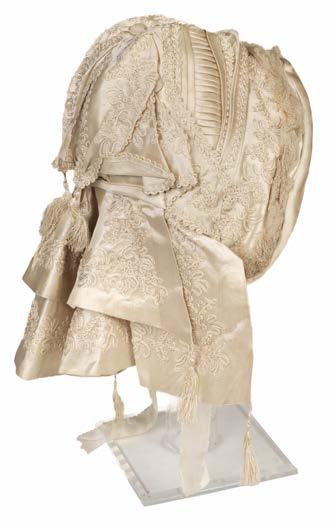
£150 - £200 Lot
740* Garments. A Victorian child’s bonnet, hand-made cream silk bonnet, with deep double neck frill, elaborately worked overall with soutache embroidery, incorporating pleated decoration, an edging of lace, two rosettes to left-hand side, and tassels, cream silk lining and ribbon ties, front of bonnet with some light soiling, a small hole, and lace becoming detached, 34 x 29 cm (13.5 x 11.5 ins), together with other lace-trimmed and/or embroidered garments, comprising: a hand-made Edwardian blouse trimmed with Bedfordshire lace and Irish crochet (apparently unworn); 3 women’s cotton bonnets; a finely gathered and embroidered whitework baby bonnet; a mob cap; a collar; a fichu; and a cream christening gown, plus a straw work bonnet lined with blue silk, various condition and sizes (11)
£150 - £250
741* Garments. Two Regency embroidered muslin cloaks, finely hand-stitched and embroidered in tambour work and satin stitch in polychrome silk threads, the first with frilled scalloped collar and scalloped edge worked with beribboned foliate sprays, the hem worked with a wide border of large floral sprays (tiger lilies, carnations, rose buds, heart's ease), lacking ribbon in drawstring casing at neck, some pale brown staining, 1 x 1.5 cm hole in border (affecting the edge of one leaf spray, without loss of stitching), length 127 cm (50 ins), the other with gathered collar and edges worked with beribboned flower garlands within a chevron border, lacking ribbon as before, 2 very small holes and a few associated small brown marks, length 117 cm (46 ins)
Presumably worn over a muslin dress for a ball or other formal occasion, we have not seen another in this style.
(2)
£200 - £300
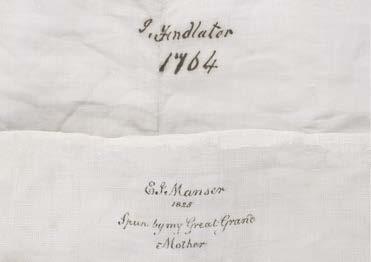
742* Household Linen. A pair of 18th century linen sheets, circa 1716, and a third, 1764, two linen sheets with ink inscription ‘EJ Manser 1825 Spun by my Great Grand-Mother’, both with stitched monogram ‘K W E’ and accompanied by a manuscript note dated 3rd August 1899 entitled ‘History of these Sheets copied by Elizth S. Spriggs the Great Great Grand Daughter of Catherine Green who spun them’, largest patched to one edge and wearing thin in places, smallest with one small patch and a little faint foxing to one corner, both with some neat period darns, 339 x 200 cm (133.5 x 79 ins) and 323 x 200 cm (127 x 79 ins), the other with ink name and date ‘I. Findlater 1764’, a few very small holes and marks, 272 x 245 cm (107 x 96.5 ins), together with 6 other items of early household linen, comprising: 2 pairs of pillowcases with ink name of E. Mitchell, 1 pair with ties, dated 1859, and the other pair with self buttons, dated 1862; a large napkin, inscribed in ink ‘Isabella Forsyth 18’; and a small linen square with a pair of ties to one corner (part of a baby’s layette?), inscribed in ink ‘Lady Chitty 12 87’
Accompanying the pair of sheets is a manuscript genealogy outlining the provenance: ‘This pair of Sheets were spun by Catherine Green, daughter of Wm. Green, who married in 1716 - Bullis, their daughter Eliza Bullis married in 1756 ... ‘ with the line of descent continued up to 1929, and including Elizabeth Manser who annotated the sheets. (9)
£300 - £400
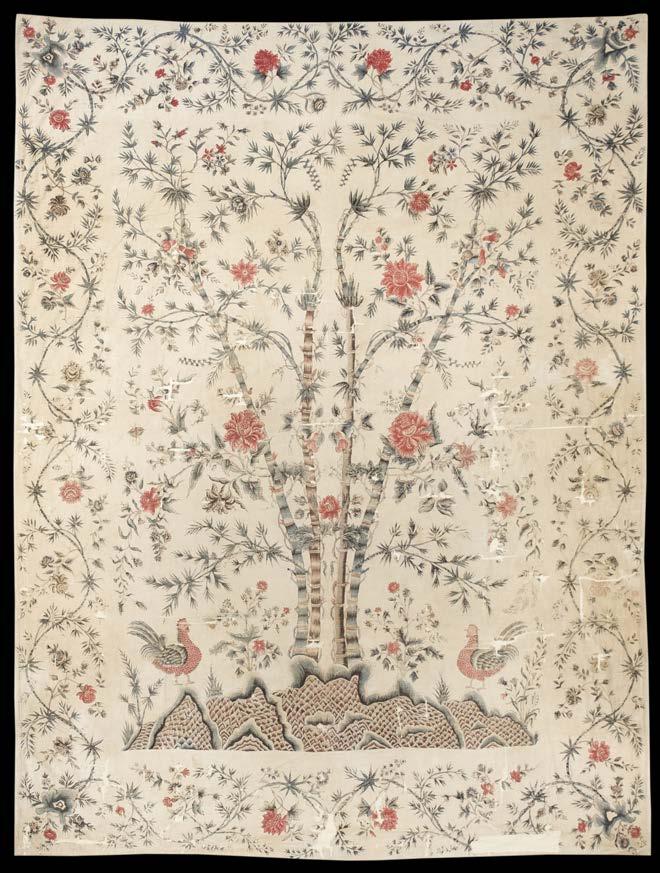
743* Indian Palampore. A large Tree of Life panel, Coromandal Coast, South-East India, circa 1770, cotton tabby, painted resist and mordant-dyed, in shades of pink, blue, and brown, on a cream vermicelli ground, with a large bamboo tree on a rocky outcrop flanked by cockerels, its branches entwined with a multitude of foliate stems bearing peonies and other flowers, as well as cashew nuts, enclosed by a wide border of scrolling bamboo branches entwined with floral and foliate sprays and tendrils, toned, scattered wear with losses, expertly consolidated with stitching on a backing of cream twill, 2.93 x 2.18 m (9 ft 6 ins x 7 ft 1 in)
A rare Tree of Life palampore, made in India in the 18th century for the European export market. For similar examples see the V&A (e.g. accession numbers IM.226-1921 and 341-1898), and the collection of palampores in the Royal Ontario Museum, Canada.
Palampores were in great demand and high-prized in the West during the 18th century. Northern European countries particularly, and especially Britain, imported such textiles which were used as bed covers or curtains and wall hangings, sometimes covering whole walls, rather like wallpaper. The Tree of Life design was a popular one, with its myriad symbolic meanings and expressive possibilities of form and colour, although the style and decorative vocabulary used in palampores drew on a wide variety of sources, including local south Asian textile traditions, Dutch floral designs, Persian iconography, English and European patterns, and, particularly, Chinese influences (as here), to produce a blend of Oriental exotica particularly dovetailed to European tastes. The present example depicts cockerels, a symbol in both Indian and Chinese cultures, with a host of associations (herald of the light, courageous, protector, etc.). Also depicted - much more unusually - are cashew nuts, which were revered for their unique shape and structure, their crescent shape echoing the moon and symbolising fertility, abundance, and prosperity. (1)
Each lot is subject to a Buyer’s Premium of 20% (Lots marked * 24% inclusive of VAT @ 20%)
£4,000 - £6,000
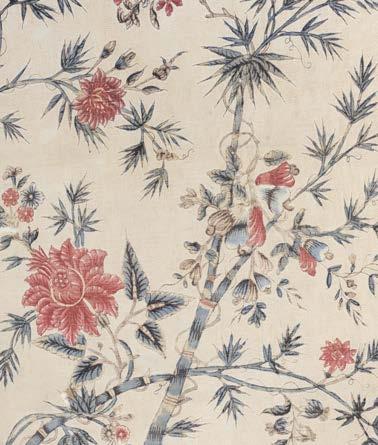
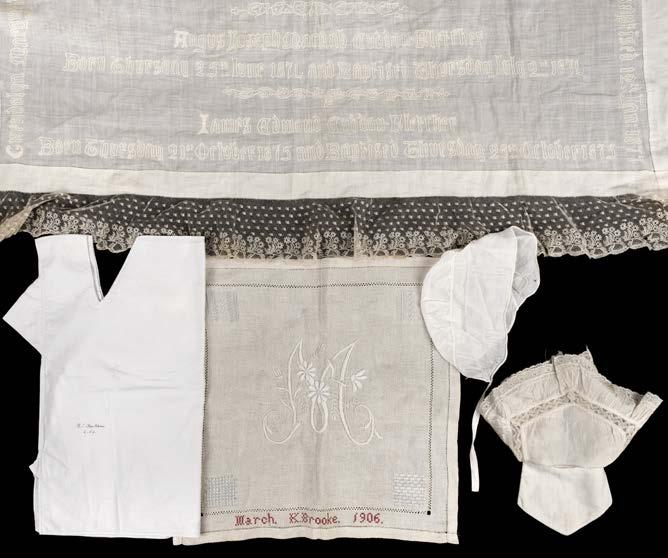
744* Infants’ Items. An embroidery commemorating births and baptisms in the Cuddon-Fletcher family, 1870s, fine cream lawn panel, hand-stitched in tambour work in cream thread with details of the birth and baptism dates of 6 children of the Cuddon-Fletcher family between 1870 and 1877: Bernard, Harriet, Margaret, Angus, James, and Gwendolyn, some light brown marks, edged with cream lace, 80 x 106.5 cm (31.5 x 42 ins), together with a few other embroidered items, including a square linen sampler, with large initial ‘M’ in centre in padded satin stitch, squares of sample embroidery stitches at corners, and ‘March. K.Brooke. 1906.’ in red cross-stitch at foot, and a quantity of 19th and early 20th century children’s clothes, including: 3 white cotton baby shirts, 2 inked with the name ‘R.I. Bartram’ and dated ‘4.64’, and the other inked ‘Bartram b. 1859’; a baby’s lace-trimmed silk and cotton bib; 4 white cotton christening gowns; a cream lace dress; a cream net and ribbon bonnet; a cream silk christening gown with lace overlay and petticoat; an embroidered white muslin dress; and a number of other shirts, vests, and petticoats, etc., various condition and sizes
The six Cuddon-Fletcher children commemorated in the embroidery were the offspring of Harriet and Bernard Cuddon-Fletcher of Dunans Castle in Glendaruel, on the Cowal Peninsula, Argyll and Bute, Scotland.
(a carton)
£200 - £400
745* Lace Bedcover. A fine Point de Venise coverlet, possibly Continental, 19th century, cream needle lace coverlet, finely handworked in Point de Venise, with Renaissance-style design comprising a central large motif of a lidded bulbous porcelain pot on a stand, decorated with a flower vase, below a bewigged head wearing a plumed headpiece and elaborate collar, surrounded by elaborate floral and foliate volutes, incorporating a pair of grotesque faces, dragon heads, and spider web motifs, joined by flower swags, occasional breaks in brides, small area of brown markings 43 cm in from right-hand edge, 228 x 208 cm (90 x 82 ins)
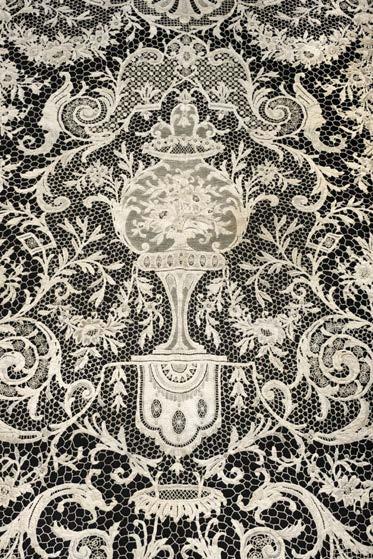

746* Lace Borders. Two wide borders of bobbin lace, Genoa, Italy, 1st half 17th century, two matching scalloped borders in bobbin lace worked in dark cream linen thread, each 23 x 33.5 cm (9 x 13.25 ins), stitch-mounted one each side of a piece of pink satin twill, with old manuscript label attached ‘Lent by Mrs Vacher’, together with a quantity of other lace items, including lengths of cream and white Russian and Italian lace, one stitch-mounted to turquoise satin ribbon with a green knotted fringe to lower and side edges, 42 items of Maltese lace, e.g. stoles, collars, fichus, modesty panel, lappets, doilies, flounces, etc., Nanduti lace, and lace made in Greece, Cyprus, and Tenerife
Mrs Vacher was the wife of Sydney Vacher (1854-1935), an architect, designer, and etcher. He donated many things to the V&A where he was considered a lace expert, along with Alan S. Cole. (68)
£200 - £300
A beautifully worked bedcover with interesting motifs, surviving in very good condition. (1)
£200 - £400
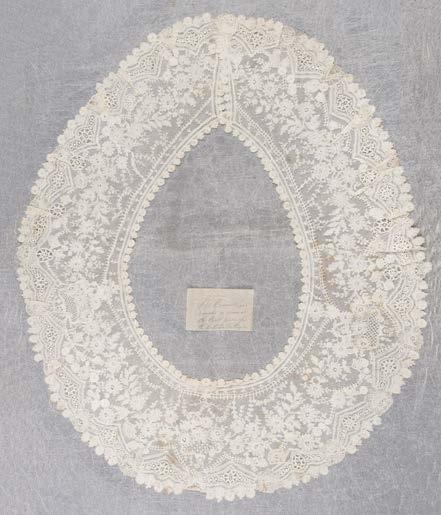
747* Lace. A Brussels lace collar, thought to have been worn at Waterloo Ball, 1815, hand-made cream lace collar, finely worked with flower baskets and floral garlands, foxed, stitched to a piece of tissue paper, with old manuscript label attached ‘Old Brussels Lace accepted as worn at the Ball given for the Waterloo Victory’, and accompanied by a later note of provenance pertaining to its more recent history, width of lace 13.5 cm (5.25 ins), overall size of collar 56 x 46 cm (22 x 18 ins)
748* Lace Crimping Iron. A goffering machine, mid 19th century, brass rollers operated by a bone-handled winder, complete with the two steel rods within the rollers, set into a cast iron frame, mounted on an oak plinth, latter a re-purposed printer’s block (‘Fanciers Books ... L. Upcott Gill, 170 Strand’), length 34.5 cm (13.5 ins), height 22 cm (8.75 ins), depth 18 cm (7 ins), together with: Thread Tester. A thread tester gauge, Manchester: J. Nesbitt, late 19th century, brass tensile gauge with measure and rotating wheel, engraved ‘J. Nesbitt, 42 Market Stt. Manchester’, mounted on a stepped mahogany base, length 48 cm (19 ins), height 11.5 cm (4.5 ins), depth 8.5 cm (3.25 ins)
Two interesting Victorian gadgets, the first for putting small pleats and ruffles into the collars and cuffs of garments. It still has the steel rods, which would have been heated in the fire, inserted into the open ends of the rollers, and - particularly unusual - has an advertising printer’s block turned upside down for the base. (2) £150 - £200
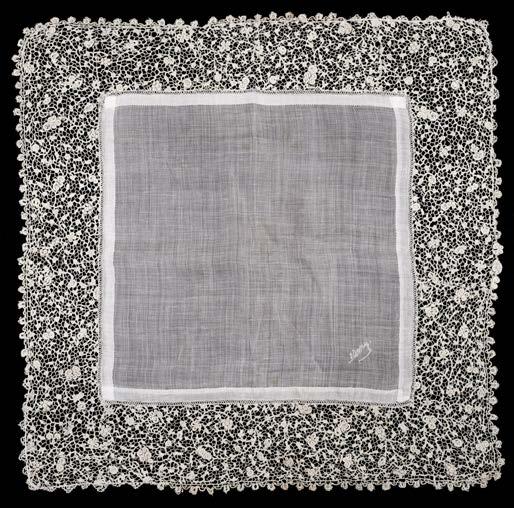
£150 - £200
Presumably the Waterloo Ball referred to is the famous gathering hosted by Charlotte, Duchess of Richmond, in Brussels on 15th June 1815, the night before the Battle of Quatre Bras, which itself took place two days before the Battle of Waterloo. The ball was a brilliant affair at which most of the senior officers in Wellington’s army were present. The proceedings were interrupted soon after the arrival of the Duke of Wellington himself, when he was notified of Napoleon’s unexpected advance. The evening gradually unravelled, the dancing, music and romance giving way to tearful farewells. Some of the officers rushed away without even changing their clothes, going off to fight in knee-breeches and dancing pumps, and a number of them died in the ensuing battles. (1)
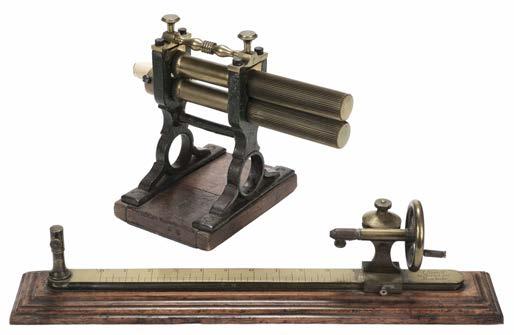
Each lot is subject to a Buyer’s Premium of 20% (Lots marked * 24% inclusive of VAT @ 20%)
749* Lace Handkerchiefs. A handkerchief with Point de Neige lace border, 19th century, fine lawn handkerchief, with hand-worked 7 cm (2.75 ins) border of Point de Neige lace, the name ‘Fanny’ stitched to one corner, 3 cm long neat repair with associated small hole, 39.5 x 39 cm (15.5 x 15.25 ins), together with:
A handkerchief with Brabant lace border, 19th century, fine lawn handkerchief, with hand-worked 14 cm (5.5 ins) border of Brabant lace, depicting flowers and volutes, with scalloped edge, centre embroidered with initials ‘M M’ surmounted by a crown, a couple of small light marks to centre, occasional minor breaks in lace, 41 x 41 cm (16.25 x 16.25 ins), plus
A handkerchief with Brabant lace border, 19th century, fine lawn handkerchief, with hand-worked 10.5 cm (4 ins) border of Brabant lace, depicting flowers, drawer handles, and volutes, with scalloped edge, one corner embroidered with the name ‘Fanny’ with ears of wheat and a crown, lawn a little marked and beginning to perish in places, some small holes in lace, 39 x 37.5 cm (15.25 x 14.75 ins), plus 13 others, including 6 handkerchiefs edged with Belgian lace (16)
£300 - £500
Lot 748
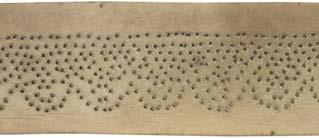
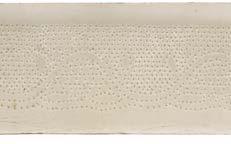

750* Lace Prickings. A collection of lace prickings, 19th century, 14 lace pricking patterns, 12 on parchment, some with fabric ends, and 2 on card, widest 8 cm (3 ins)
A collection of uncommon early lace prickings, used by bobbin lace makers as a pattern guide; pins are pushed through both pattern and pillow, lying beneath the lace as it’s made, so guiding the threads, and facilitating formation of the design.
(14)
£80 - £120
751* Lace Stole. A Buckinghamshire lace stole, 1st half 19th century, machine net stole, with wide hand-made Bucks Point edging, featuring gathered corners, depicting flowers and garlands, a few tiny holes in centre net, otherwise in good condition, edging 15 cm (6 ins), overall size 61 x 233 cm (24 x 92 ins), together with: other Bucks Point lace, e.g. a head covering, a pair of puff sleeves, a jabot, a bertha, edgings, collars, etc.; a quantity of Bedfordshire lace, including collars, a yoke, handkerchiefs, a mob cap, etc.; a quantity of Honiton point, including lengths, handkerchiefs, a silklined baby cap, a pair of cuffs, modesty panels, and a Heinemann & Co., Piccadilly, box of flounces and butterflies; a quantity of tape lace, including lappets, a modesty panel, edgings, collars, etc.; 2 matching wide flounces of princess lace; and 3 items of Yak lace (86)

£200 - £400
752* Lace Veil. A tambour work appliqué veil, 19th century, a large cream net wedding veil, tamboured and appliquéd with flower sprigs in centre, and wide border and cornerpieces of large flower sprays, scalloped edge, some very small holes in net, and a few minor marks, 228 x 215 cm (90 x 84.5 ins), together with 4 other white and cream tambour work lace items: a fichu; a wide circular edging; a lappet; and a handkerchief, plus a quantity of needlerun and embroidered white and cream lace, including edgings, a mob cap, stoles, a large fichu, etc., various condition and sizes (24)
£300 - £400
753 Lace. A small collection of lace, mostly handmade, 19th century, comprising: 8 lengths or flounces of cream needle lace, largest 18 x 198 cm (7 x 78 ins), smallest 13 x 21 cm (5.25 x 8.25 ins); a cream modesty panel of needle lace and appliqué on net; a cream lace-edged stole; a small white needle lace muslin shawl (some holes and marks); a fine white panel worked in needle lace with scattered small sprigs and a border of flowering plants to lower edge (some small holes and ladders); and an apron of black needle lace on net, various condition and sizes (13)

£100 - £150
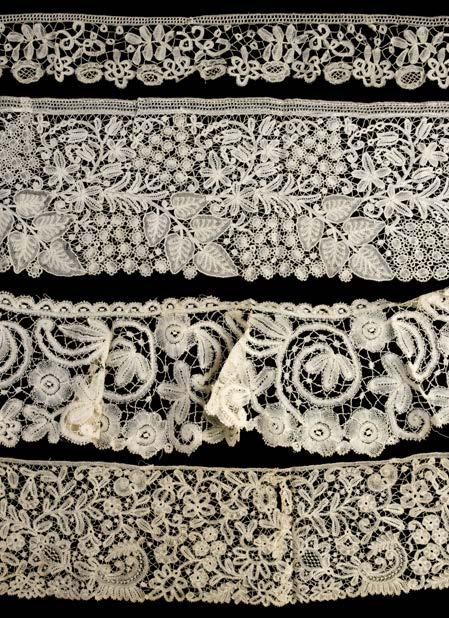


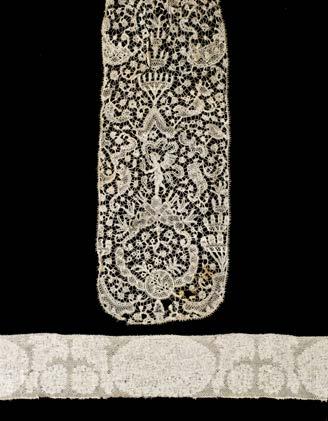

£200 - £400
754* Lace. A collection of lace and needlework items, 19th & 20th century, a quantity of white, cream, and black lace, including Carrickmacross, crochet, knitting, tatting, filet, whitework, torchon, drawn threadwork, and Irish crochet, e.g. bonnets, edgings, tablecloths, collars, shawls, a stole and a bertha of Carrickmacross lace, and 9 items of Irish crochet accompanied by a letter from Georgiana Synge dated 24 April on headed notepaper ‘Mount Callan, Inagh Bridge, Co. Clare’: ‘Madam, Would your Grace mind my asking you to take a little souvenir away with you? ... I want you to remember how grateful at least one heart is, for all your great kindness to our poor. Your gifts have saved lives, for you were the first to throw yourself into the forefront of the Battle, and wrestle with, what would have been, but for you, almost a Famine’, various condition and sizes Georgiana Synge died in 1891, and her obituary in Clare Journal read: ‘It would be hard to express the sorrow with which the friends and acquaintances of the deceased lady learned that the Master had called her home and impossible to put into words what her loss means to the poor in her own neighbourhood who so largely benefited by her practical and discriminating charity. She had no greater pleasure than to do good and the blessing of her kind sympathetic nature seemed to rest on all with whom she came into contact. Her wise and loving deeds will long be remembered and her example will encourage others to higher, nobler lives of self-denial and benevolence’. (2 cartons)
755* Lace. A collection of lace items, some handmade, 19th-mid 20th century, various lace and lace-trimmed items, mostly white or cream, but also some black pieces, including lengths and flounces, a handkerchief, collars, a cap, cuffs, shawls, lappets, doilies, cloths, a blue silk mat with silk ribbon and thread embroidery, a pair of bloomers with label ‘W. Clarkson, Perruquier & Costumier, London’, a wide double flounce for a baby’s crib, etc., various condition and sizes (a carton)
757* Lace. A Flemish lace bertha, late 17th/early 18th century, hand-made ivory lace bertha, sometime partially backed with chiffon, occasional breaks in lace, and a few neat repairs, 20.5 x 101 cm (8.25 x 39.75 ins), together with:
£100 - £200
756* Lace. A Flemish flounce of ‘cauliflower’ lace, 2nd half 17th century, hand-made ivory lace edging, with design of ovals with pairs of circles and volutes between worked in a ‘cauliflower’ pattern, 3 joins, scattered foxing, occasional small holes, 7 x 342 cm (3 x 134.5 ins), together with:
A Flemish lace lappet, 2nd half 17th century, hand-made cream lappet, with a cherub to each end, and crown devices above, rust stain to ends, 2 holes to edge of middle (largest 2.5 x 1 cm), 15 cm (6 ins) wide at ends x 88 cm (34.75 ins) long (2)
Each lot is subject to a Buyer’s Premium of 20% (Lots marked * 24% inclusive of VAT @ 20%)
£200 - £300
A Flemish lace baby cap, mid 18th century, fine white lawn baby cap with double edging of lace, a couple of faint marks to cap, lace becoming detached at nape, 14.5 x 15 cm (5.75 x 6 ins), plus: A Belgian needlelace and appliqué collar, 19th century, fivepointed dark cream collar of needlelace with appliqué on a net ground, patterned with flowers, leaves, and meshwork, 63 x 58.5 cm (25.75 x 23 ins), plus other white and cream Flemish lace items, including: a white stole of Brussels lace, 53 x 264 cm (21 x 104 ins); 2 matching lengths of Mechlin lace, width 15 cm (6 ins), length 151 cm (59.5 ins) and 233 cm (92 ins), both contained with an old manuscript label in a Jays’, Regent Street, box; a long wide flounce of Brussels lace, 51 x 448 cm (20 x 176 ins); 2 handkerchiefs edged with Brussels lace, one with early manuscript label attached ‘from the Collection of Princess de Lusiman of Spain’; 2 matching wide flounces of Brussels needlelace with appliqué, each 38 x 364 cm (15 x 143 ins); a pair of cuffs and matching modesty panel; and a length of Brussels Point de Gaze lace, various condition and sizes (22) £200 - £400

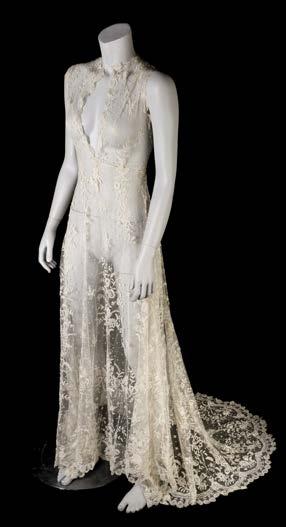
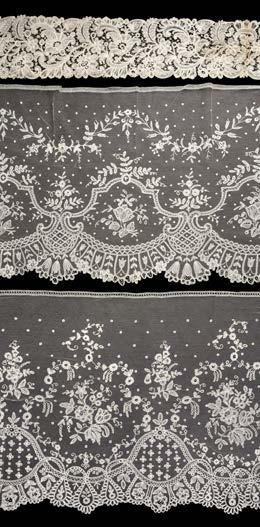
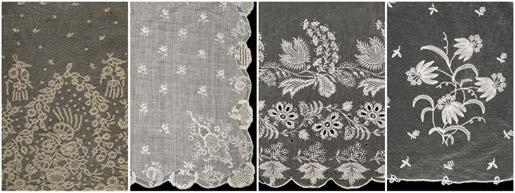
758* Lace. A large veil, & other hand-made lace items, 19th or early 20th century, a large cream needle lace wedding veil, handworked on machine net, and backed with net, patterned with scattered small trefoil sprigs and roundels, and with a wide border of floral garlands and flower sprays all round, scattered small holes (a couple of crude mends) and occasional small marks, 10 cm tear in backing net, 201 x 192 cm (79 x 75.5 ins), together with 7 other items of hand-made lace, including a white Dresden work fichu (1 or 2 small holes), a half veil with wide floral border, labelled ‘Run work, probably Brussels, mid 19 c.’, scattered small holes and light marks, and some light discolouration at edges, a needle lace cream stole with scalloped edge, and a white appliqué net stole depicting tiger lilies, various condition and sizes (8)
760* Lace. A wedding dress lace overlay of Brussels lace, 19th century, hand-worked cream needle lace on machine-made net, sleeveless, and with a short train, depicting flower sprays and trailing tendrils on a semé dot ground, length at front 147 cm (58 ins) and at back 188 cm (74 ins), together with 10 other 19th century handmade lace items, including: a large scalloped flounce of needle lace, some damage, 105 x 454 cm (41.5 x 179 ins); a pair of lace sleeves, each with 8 tiny gold thread Dorset buttons; and 2 pairs of lace cuffs, all in good condition, various sizes, accompanied by 2 old correspondence cards headed ‘8, Collingham Gardens, South Kensington, S.W.5.’, giving details of ‘white lace’, all housed in a large blue crushed and polished morocco box (faded, lacking key), hinged lid with gilt tooled border of palmette, wreath, and wheel tools between single fillets, blue moiré silk lining, 9 x 55 x 32 cm (3.5 x 21.5 x 12.5 ins), contained in a (slightly broken) cardboard box, with old manuscript note on side of lid ‘Lace Box’
Provenance: Angela Ida Harriet Parry (1879-1977), the grandmother of the owner, who lived at 8 Collingham Gardens, South Kensington, London. (11) £200 - £400
£200 - £300
759* Lace. A long Brussels Point de Gaze lace border, mid-late 19th century, wide scalloped border of cream needle lace, depicting floral swags, occasional minor discolouration, 17.5 x 792 cm (6.75 x 312 ins), together with 3 other long lace borders similar, measuring 9 x 454 cm (3.5 x 178.5 ins), 15.5 x 385 cm (6.25 x 151.5 ins), and 12.5 x 562 cm (5 x 221 ins)
761* Lace. Four large flounces, 19th century, all handmade needle lace on machine-made net, the first with appliqué: 57 x 545 cm (22.3 x 214.5 ins); 50.5 x 512 cm (19.75 x 201.5 ins); 55.5 x 445 cm (22 x 175 ins); 87 x 383 cm (34.25 x 151 ins), latter joined in a circle, some small holes, together with:
A lace-trimmed handkerchief, 19th century, cream lawn, with finelyworked scalloped lace border of appliqué and tambour work on machine-made net, depicting flower sprays and garlands, one corner with embroidered initials ‘A I A C’, a few small marks, 42.5 x 43.5 cm (16.5 x 17 ins), plus other items of cream and black lace, including shawls, edgings, flounces, collars, head coverings, parasol covers, etc., all housed in a wooden box and 2 cardboard boxes, one a Liberty box, all with old manuscript labels indicating lace contents
£400 - £600
Provenance: Angela Ida Harriet Parry (1879-1977), the grandmother of the owner, who lived at 8 Collingham Gardens, South Kensington, London. Four wide long lengths of 19th century hand-made lace, generally in very good condition. (4)
Provenance: Angela Ida Harriet Parry (1879-1977), the grandmother of the owner, who lived at 8 Collingham Gardens, South Kensington, London. The initials on the handkerchief stand for the owner’s great grandmother, Angelina Chenowyth.
(3 boxes)
£200 - £400
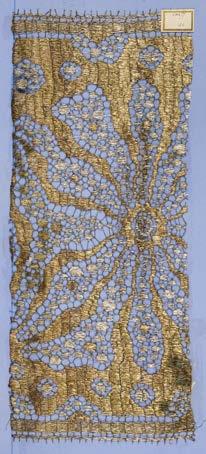
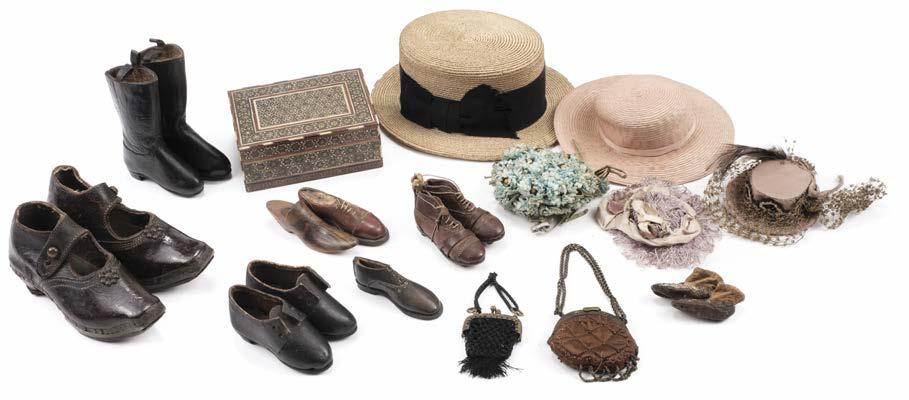
762* Lace. Three large sample books, early 20th century, each with approximately 100 card leaves, and filled with numerous samples of lace mounted on rectos and versos, including coloured, beaded, embroidered, and metallic laces, some pages with one large sample, other pages with 10 or more smaller samples, some leaves with mounted photographs of lace and printed reproductions of lace, manuscript annotations giving stock numbers and sometimes description, e.g. 'Net', 'Flounce', Veil', some damp-staining and marks, leaf size 42 x 29 cm (17 x 11.5 ins), each bound in original half calf, heavily worn with losses, 2 titled in gilt on spine and upper cover 'Reference Book' and with a number, the other with manuscript paper label 'Autumn 1922', thick folio (3)
£150 - £200
763* Miniature. A pair of tiny Eskimo shoes, circa 1855, hand-stitched sealskin Inuit boots, rubbed, and with some small holes, 4.5 cm (1.75 ins) long, with a manuscript note in black ink pertaining to their history, contained together in a later mosaic work box, together with:
A straw boater trade sample, Lincoln Bennett & Co., Sackville Street, Piccadilly, London, early 20th century, small straw boater hat, trimmed with wide black grosgrain ribbon terminating in a bow at one side, maker’s name printed on inside, height 7 cm (2.75 ins), width 15 cm (6 ins), length 18 cm (7 ins), Gentlemen’s shoes cobbler samples, circa 1930s, 2 hand-made miniature lace-up leather shoes for men (laces partly lacking), one of brown leather with cap toe, the other of black leather, the former containing a wooden last, and other miniature items, comprising: a pair of miniature football boots, each annotated on sole ‘E.J. 1959’; a pair of miniature leather clogs (lacking laces), length 8.5 cm (3.25 ins); a pair of miniature black boots; a pair of Victorian or Edwardian child’s leather clogs with wooden and metal soles, length 15 cm (6 ins); 3 small purses; 3 dolls’ hats; and a souvenir miniature wooden last from Italy, lettered ‘Brunate’
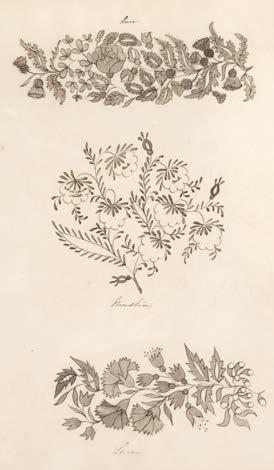
Rare survival of a pair of miniature Eskimo shoes which have a touching history, according to the accompanying note: ‘Model of Esquimaux shoes (actually water tight) often attached to the dress of the mother in memory of a departed child. Procured when Grandfather (E.A.W.) was a missionary in Hudson’s Bay district, 1855 (circa).’ Prestigious London hat makers Lincoln Bennett were the leading maker of gentlemen’s headwear in the 19th and early 20th centuries. They supplied hats to members of the royal family and were said to have covered more aristocratic crowned heads in their time than any other firm in the world. Between 1876 and 1893 they won various gold medals at exhibitions in Philadelphia, Paris, Sydney, Melbourne, Calcutta, Adelaide, London and Chicago. (21)
Each lot is subject to a Buyer’s Premium of 20% (Lots marked * 24% inclusive of VAT @ 20%)
£100 - £150
764* Pattern Book. Manuscript book of embroidery & lace patterns belonging to Isabella Chambers, 1828 (and later), ff.100+, pen & ink designs (and some in pencil), many with watercolour wash, mostly to rectos, depicting floral motifs, names, monograms, and initials, borders, cuff and collar edgings, patterns for girls’ and boys’ caps, etc., some contemporary annotations in pencil and ink, e.g. ‘ Point Lace’, ‘Tucker, or Collar’, ‘Corner Sprig’, ‘Muslin’, ‘Cuff Pattern. 1840’, ‘Gowns’, ‘Sleeve for a Baby’, ‘Corner of pocket handkf.’, marbled endpapers, hinges expertly repaired, inscribed in sepia ink to verso of front free endpaper ‘Isabella Chambers. Jany 8th 1828.’, original half calf, rebacked and recornered, and with marbled pocket added to rear pastedown containing a few loose patterns and manuscript instructions, 4to An attractive pattern book, full of meticulously executed patterns and designs. (1)
£200 - £300
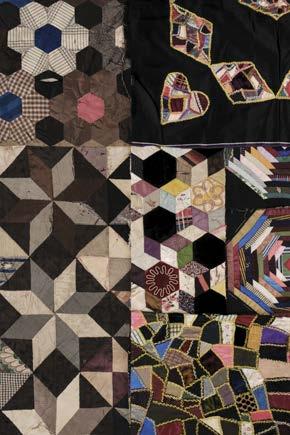

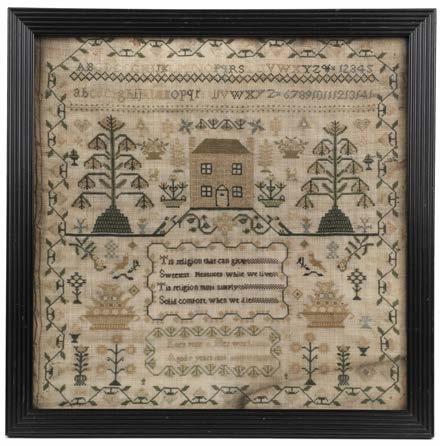
765 No lot
766* Quilt. A silk patchwork quilt, circa 1870, hexagon and star quilt, composed of plain and patterned fabric, hexagons approximately 4 cm diameter, 8-lozenge stars 18 cm diameter, border of lozenge pairs arranged in a chevron pattern, some fabrics perished, backed with sprigged cotton in pink, blue, and green, on a cream ground, stain to one edge, edged with black and yellow twisted cord, 208.5 x 186 cm (82 x 73 ins), together with 10 portions of unfinished patchwork, silk or velvet, mostly log cabin and crazy pattern, 77 x 47 cm (30.25 x 18.5 ins) and smaller, and 16 unused squares of pineapple quilting, each aproximately 22 x 22 cm (8.5 x 8.5 ins), 12 on a background of black satin, and 4 on cream (27)
768* Sampler. A needlework picture by Ellen Male, 1839, worked in silk threads on cream linen, using cross-stitch in shades of green, yellow, cream, and blue, with a house in the centre flanked by stylised flower baskets and trees, dogs, hearts, and other motifs, with alphabets above, and a 4-line religious verse below, with the maker’s name and date at foot ‘Ellen male Her work Aged 9 years 1839’, the lettering flanked by further motifs, including birds, pears, floral baskets, dogs, flower stems, etc., floral border to edge, small holes and loss to edges in places (with very little loss of stitching), stain to lower right corner, 34 x 34 cm (13.25 x 13.25 ins), framed and glazed (39 x 39 cm), together with:
£200 - £300
767* Reticule. A Regency bag or document pouch, probably English, 1st quarter 19th century, tan morocco wallet-form bag, with onlaid tortoiseshell panel to each side finely hand-engraved with a chevron design enclosed by fish-scale flower pattern above and below, and volutes at either side, within a border of tortoiseshell inlaid with pewter fillets, bordered by a gilt pelmet roll, latter repeated on flap, brass clasp fastening (6 mm tear to adjacent leather), and double brass belcher chain emanating from escutcheons on front and back, sides of concertina form with 3 gussets, pale oyster cloth lining, 15 x 17.5 x 1.5 cm (6 x 7 x .5 ins)
A rare and exceptionally well-preserved Regency reticule. This may have been used to carry the usual accoutrements required by a ladyhandkerchief, gloves, etc. - but its unusual form suggests that it may also have been intended to hold letters or ephemeral keepsakes such as tickets or programmes. For reticules of similar form see the V&A T.285-1968 and The Met 1986.300.2.
(1)
£800 - £1,200
A needlework picture by Ann Chennell, 1774, worked in silk threads on cream linen, with alphabets, a line of initials, and a 4-line verse above a religious maxim, with the maker’s name and date ‘October the 22 1774’ at foot, with floral borders and patterns between, the whole within a floral border, the lettering worked in cross-stitch and Algerian eye stitch, and the floral motifs worked in satin stitch, mainly in shades of red, green, yellow, and blue, scattered holes and marginal losses, 35.5 x 31 cm (14 x 12 ins), framed and glazed (40 x 36 cm), and 2 other alphabet samplers, by Anna Maria Chennell, aged 11, and Ann Mary Chennel respectively, worked with alphabets in cross-stitch on linen, toned, plus a pair of small framed oval needlework pictures of flowers
Provenance for the Chennell samplers: Mrs Knight née Chennell; the owner's mother, Enid Hallon; the present owner.
Mrs Knight had only one child, a daughter named Ida. Ida Knight and Enid Hallon became close friends when they were both students at the Royal Academy of Music in the 1920s. Ida died young, in 1935, shortly after getting married, and she had no children. Enid kept in touch with Mrs Knight, sometimes visiting her at St. Leonards on Sea where she lived. When Mrs Knight died in the late 1950s Enid negotiated to buy from her estate an item of furniture which she had always admired. The executor said that as the item of furniture had come from the Chennell family she might like to take the samplers as well; she did so, and they were subsequently given to her daughter, the present owner.
(6)
£200 - £300



769* Sewing Accessory. George III steel pincushion clamp in original box, late 18th century, steel clamp with gilt metal highlights, with bead and leaf decorated circular frame, and drawer handle screw terminal, supporting a flower-form finial containing a crimson velvet domed pincushion, 21 cm (8.25 ins), contained in original pink velvet-lined hinged shaped box, with additional compartment for a sewing stiletto (not present), exterior covered with textured green paper, slightly rubbed, red paper and gilt beaded edging missing in places, 21.5 x 9 cm (8.5 x 3.5 ins), together with a Victorian ivory satin pincushion, with pinwork flower urn and lettering ‘Welcome To The Little Stranger’, fringed edging, 15 x 17 cm (6 x 6.75 ins)
An attractive sewing clamp found, most unusually, in its original box. (2)
£200 - £300


Each lot is subject to a Buyer’s Premium of 20% (Lots marked * 24% inclusive of VAT @ 20%)
770* Shawl. A finely woven stole, circa 1820s, cerise silk and wool, fringed short ends with wide polychrome border of flowers, and edged all round with a narrow floral border, some faint mottling, and occasional small marks, 71 x 272 cm (28 x 107 ins), together with: A turnover shawl, circa 1820s, crimson woven shawl, with wide border of botehs, 2 sides with botehs truncated to top edge (cut down from an earlier shawl?), some staining and marks, scattered small holes, 154.5 x 161 cm (61 x 63.5 ins), plus 3 other 19th century woven shawls, including 2 Norwich (one with manuscript provenance note dated 1932) (5)
£300 - £500
771* Shawl. A long shawl (Dochalla), North India, circa 1850, woven in polychrome wool, with eight-lobed orange stellar motif in centre, bearing merchant’s embroidered mark, either side with 3 long panels of interwoven slanted bent-tip botehs, with borders of circular motifs between, palmette border all round, the two short ends with harlequin fringes, some scattered small holes, fringing with 5 cm tear in one end and small losses, 342 x 143.5 (134.5 x 56.5 ins)
Provenance: Angela Ida Harriet Parry (1879-1977), the grandmother of the owner, who lived at 8 Collingham Gardens, South Kensington, London. (1)
£700 - £1,000
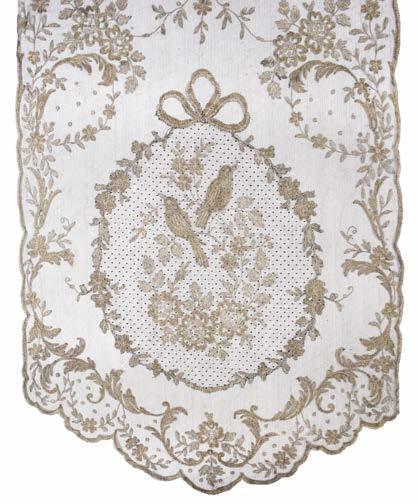

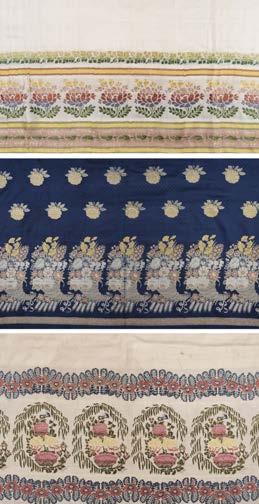
772* Shawl. A metalwork net stole, 1930s, tambour work black net stole, hand-worked all over in silver and gold metallised threads, with birds amongst beribboned flower garlands and sprays, scalloped edges, some scattered small holes, and occasional loose threads, 53 x 270.5 cm (21 x 106.5 ins), together with 5 other shawls, mostly of a similar vintage, including a black piano shawl with polychrome floral embroidery, and an orange and gold lamé shawl, plus an Art Deco black and silver sequinned net cape
(7)
£150 - £200
773* Shawl. A Regency goldwork stole, probably India for export, circa 1800, fine muslin ivory stole, woven with goldwork border of small botehs, with large boteh at each corner, 114 x 233.5 cm (45 x 92 ins)
A beautiful lightweight gauzy Regency stole, surviving in wonderful condition.
(1)
£300 - £500
774* Shawl. A Spitalfields silk shawl, circa 1820s, finely woven cream shawl, with border of large flowers between narrower foliate borders, in shades of orange, yellow, green, and blue, fringed edging all round, a few small marks and tiny holes, 161 x 158 cm (63 x 62 ins), together with:
A Spitalfields silk shawl, circa 1820s, woven dark blue shawl, with repeated chrysanthemum flower in yellow and green on a ground figured with square flower and leaf device, short sides with remains of knotted fringe and wide border of floral cornucopias in peach, pale blue, green, and cream, some surface rubbing and scattered small holes, 74 x 269 cm (29 x 106 ins), plus another finely woven Spitalfields stole, dark cream silk, with floral border and fringe at short ends, somewhat worn and with a number of period darns (3)

775* Shawl. A Spitalfields silk stole, circa 1830s, woven pink stole, short sides with fringed edging and wide floral border, in bright pink, yellow, green, and white, a few small marks, 1 or 2 pin holes, 61.5 x 278 cm (24.25 x 109.5 ins), together with:
£300 - £500
A Spitalfields silk stole, circa 1830s, woven olive green stole, short sides with wide border of large seedheads between flowers and branching stems, some staining and scattered small holes, 45.5 x 267 cm (18 x 105 ins)
(2)
£200 - £400

776* Shawl. A Varanasi silk brocade stole, North India, late 19th/early 20th century, finely hand-woven in pink and lilac thread and gold metallic thread on a shot purple ground, with a repeated pattern of sinuous flower and leaf stems, with floral border to long sides, wide foliate border to short ends, and gold metallic fringe to each short end (mostly intact), a few small holes, 2 closed tears in one end (one held with a few consolidating stitches), 56 x 227 cm (22 x 89.5 ins) excluding fringe, together with:
An Ottoman embroidered stole, early 20th century, cream organza stole, embroidered with a wide border of mauve and white lilac flowers on branching stems, the flowers worked in silk threads, the stems and leaves in green silk thread and gold metallised thread, short ends with large emblem incorporating a foliate spray worked in gold metallised thread, hems bound with the latter, occasional small light marks, 53 x 254.5 cm (20.75 x 100 ins), plus 2 gold stoles, both circa 1910s/20s
A beautiful Varanasi stole in good condition. The V&A has a sari woven in Varanasi at a slightly later date, using the same technique (accession number IS.50-1998). Accompanied by two later manuscript notes, both giving similar information regarding provenance, the first reading: “Grandad Greensmith bought this stole on one of his many trips to India, to buy cotton for the Mill - early 1900”.
(4)
£200 - £300

777* Suzani. An embroidered prayer suzani, Uzbekistan, 19th century, hand-embroidered in silk threads in shades of purple, orange, red, green, pink, yellow, and white, on a a beige silk ground, with mihrab decorated with a border of serrated leaves, and an inner scalloped trefoil border, surrounded by stems of pomegranates and various stylised floral and foliate motifs, flower and leaf pattern border, some ink pattern outlines visible (change of design or unfinished?), some scattered ink spotting and occasional small marks, 1 or 2 small holes, backed with beige cotton (2 x 3 cm hole, and another slightly smaller), 142 x 116 cm (56 x 45.4 ins)
Provenance: Collection of David Battie.
(1)
Each lot is subject to a Buyer’s Premium of 20% (Lots marked * 24% inclusive of VAT @ 20%)
778* Theatre Costume. A brocade frock coat and matching breeches, late 19th/early 20th century, handmade coat in blue and gold brocade, front and back edges, pocket flaps, and gold satin cuffs, with ornamental brass buttons and embellished with gold metallised lace and spangles, occasional loose threads and minor wear, frayed to underarms, nape with inked fabric labels ‘ Penderie No 9’, ‘Bretet’, and ‘M. Huckel’, chest 98 cm (38.5 ins), sleeves 56 cm (22 ins), length 92 cm (36.25 ins), together with a matching pair of breeches, similarly labelled, waist 80 cm (31.5 ins), length 79 cm (31 ins), plus 2 other sets similar: a black velvet and puce pink silk page costume consisting of doublet and matching pantaloons embellished with gold metallised braid, and a matching belted purse, designed and made by Adelchi Zamperoni, Milan, with maker’s printed label to lining stamped ‘Il Profeta’ and with ‘Page’ written in ink, doublet with inked fabric labels at nape ‘Mallre’, ‘Wood’, ‘Casall’, ‘Dolotine’, and pantaloons with inked labels ‘Stibler’, Gérard’, Tovaroff’, silk heavily worn and frayed in places; and a beige jacket with green velvet sleeves, accompanied by matching green velvet breeches, both with silver braid frogging, lining to each inkstamped ‘Apollo’ and with inked fabric labels ‘Hans’ and ‘2e Acte Figuration’, breeches with additional label ‘Godino’, some moth holes in jacket, breeches partially faded
Provenance: ‘Costumes from the Monte Carlo Opera House sold by order of The Societé des Bains de Mer’, Sotheby’s, The Duke of York’s Theatre, St. Martin’s Lane, 16th November 1980, lots 197, 21 and 8 respectively (the second item was made for the Opera Le Prophète, first performed at Monte Carlo on 13th January 1894, and the third item for the operetta Hans).
(7)
£300 - £500
252
£200 - £300
779* Theatre Costume. An embroidered brocade frock coat, worn at the ballet ‘Louis XV’, Monte Carlo, 1922, handmade coat in cream and gold brocade, hand-embroidered to front, back, cuffs, and pocket flaps, with pattern of large meandering rose stems, worked in chain stitch, bullion stitch, and couching, in shades of pink, green, and yellow, incorporating gold metallised thread, and tiny spangles, ornamental buttons to front, cuffs, and pocket flaps, of metallised thread and spangles, sleeves with double frill of hand-made needle lace, one with initials ‘SB’ in red crossstitch concealed within sleeve, lined with cream and white cotton, some wear, especially to underarms and cuffs, some loss of threadwork (in places revealing ink design beneath), occasional discolouration and light marks, with 2 inked fabric labels detached ‘Cremonin’ and ‘Marini’, chest 98 cm (38.5 ins), sleeves 56 cm (22 ins), length 92.5 cm (36.5 ins), together with 2 other brocade frock coats similar: the first of maroon velvet, lined with pale blue satin (with some staining), embellished with gold metallised lace (worn in places), and gold coloured buttons embossed with flowers and leaves, nape with inked fabric labels ‘Penderie No. 9’, ‘M. Pigerre’, and ‘Vezzani’; the second of blue and gold brocade, with silk inserts in split sleeves, organza frill at cuffs, and embellished with gold metallised braid and edgings, somewhat worn, nape with indistinct circular ink stamp and inked fabric labels ‘Otello’, ‘M. Modeste’, and ‘Trovatore 1er Acte 2me Acte, 2me Tableau’
Provenance: The first and second items were sold at ‘Costumes from the Monte Carlo Opera House sold by order of The Societé des Bains de Mer’, Sotheby’s, The Duke of York’s Theatre, St. Martin’s Lane, 16th November 1980, lots 81 and 54 respectively (the first item was worn for the perfomance of extracts from various ballets, titled Louis XV, first performed in Monte Carlo on 25th November 1922, and the second at the operetta Chérubin, first performed in Monte Carlo on 16th February 1905. (3)
£200 - £300

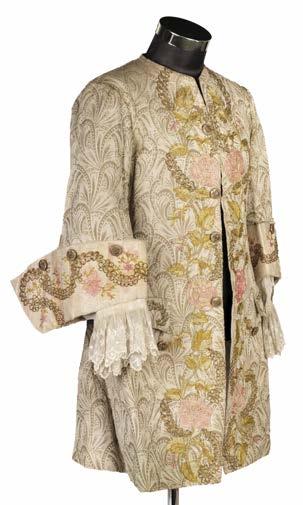
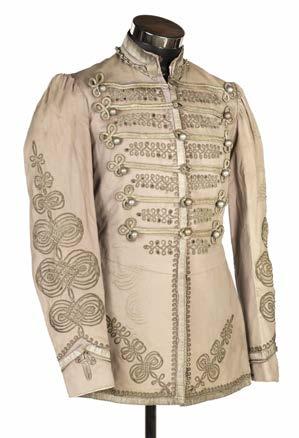

780* Theatre Costume. A collection of adults’ and children’s costumes, late 19th/early 20th century, all with various labels or annotations indicating productions and/or characters and actors, adult’s costumes comprising: 2 military-style jackets, both sets with elaborate gold or silver frogging, one jacket labelled ‘La Belle au Bois Dormant’ and ‘M. Gaston Severin’, the other labelled ‘Rouch’ and ‘Marietta’; 2 pairs of military-style breeches with frogging, one with oval ink stamp on lining ‘’Landolff Costumier, Paris’; a cream cotton and blue silk blouson embellished with gold metallised braid, worn in a production of ‘Trovatore’; 2 braided silk waistcoats; a woollen Moorish-style coat with velvet and woven appliqués and gold metallised edgings, and children’s costumes comprising: 4 doublets, including 2 matching; a Spanish-style pink woollen bolero jacket and matching breeches; and a pair of brown woollen breeches, various condition (some wear) and sizes
Provenance: Some, if not all, of these items were sold at ‘Costumes from the Monte Carlo Opera House sold by order of The Societé des Bains de Mer’, Sotheby’s, The Duke of York’s Theatre, St. Martin’s Lane, 16th November 1980.
(15)
781 No lot
£200 - £400
782* Toile de Jouy. Four large panels of Toile de Neptune, France, Nantes, circa 1788, 4 pieced panels (previously curtains, each with one machine-stitched vertical seam), copper plate printed in red on a deep cream ground, depicting mythical scenes of Neptune in his chariot, Venus and Cupid, blacksmith cupids, Jupiter’s eagle, etc., amongst elaborate flower garlands, volutes, trailing stems, and cornucopias, edges raw, variously faded and worn, 2 panels with some staining, each 272 x 119 cm (107 x 47 ins) and slightly smaller (4)
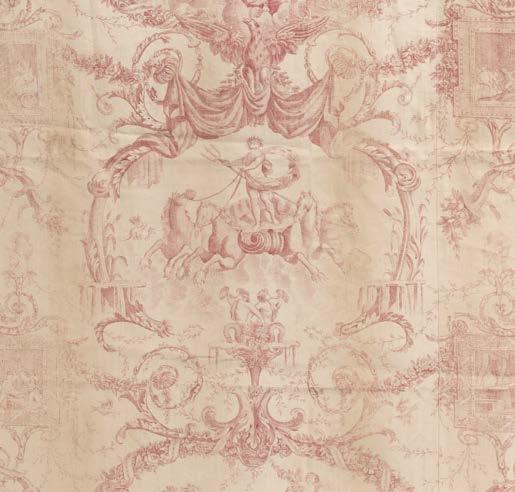
£200 - £300
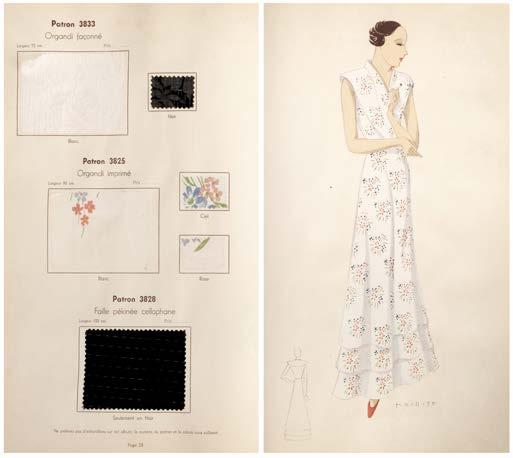
784* Victoria (1819-1901). Queen of Great Britain and Ireland. A deconstructed jacket, 3 parts of a crimson velvet jacket, elaborately embellished with gold soutache braid forming large feather design and sewn to castellated edge, comprising bodice in 2 parts, bust 112 (44 ins), length 74 cm (29 ins), and a wide sleeve, 48 cm (19 ins long), a few small marks, together with:
Irving (Sir Henry, 1838-1905). A bow tie belonging to Sir Henry Irving, white fine cotton twill bow tie, a little discoloured, 9.6 x 88 cm (3.5 x 34.75 ins), together with a pressed carnation, and a telegram from Martin Harvey to the secretary of the Dramatic and Literary Club, Grand Hotel, Birmingham, reading ‘Warm greetings to all and many regrets at inability to be present’, contained together in a Grand Hotel envelope inscribed ‘Worn by Sir Henry Irving Friday 7th October 1904 Birmingham’, plus 2 manuscript letters from Diane Pimm pertaining to provenance
According to an accompanying (later) note this was a favourite jacket of Queen Victoria: ‘given to a servant at Osborne House but cut up to stop her wearing it! This was often done by the Queen apparently.’ Indeed, another garment lacking a sleeve which belonged to Victoria - a black mourning bodice - passed through these rooms last year. It seems reasonable to suppose that the Queen, whilst wishing her clothes to be repurposed - particularly for the benefit of those who served her - would have thought it unseemly for her staff to be seen wearing them.
Provenance for bow tie: Given by Sir Henry Irving to George Claridge, a waiter at the Grand Hotel in Birmingham; bequeathed by George Claridge to his niece Dorothy Pimm (née Claridge); given by Dorothy Pimm to her daughter-in-law Diane Pimm; given to the current owner - private collection, Derbyshire.
£150 - £200
783 Trade Catalogue. Soieries - Lainages [Silks - Woollens], Paris: Bram Caan, 1935, 52pp. mounted textile samples, and 16 handcoloured full-page illustrations of fashion, each depicting a lady in an elegant dress, some off-setting of samples, original gold clothbacked boards, rubbed and a little marked, front cover embossed in silver with manufacturer’s monogram, title, and date, folio (1)
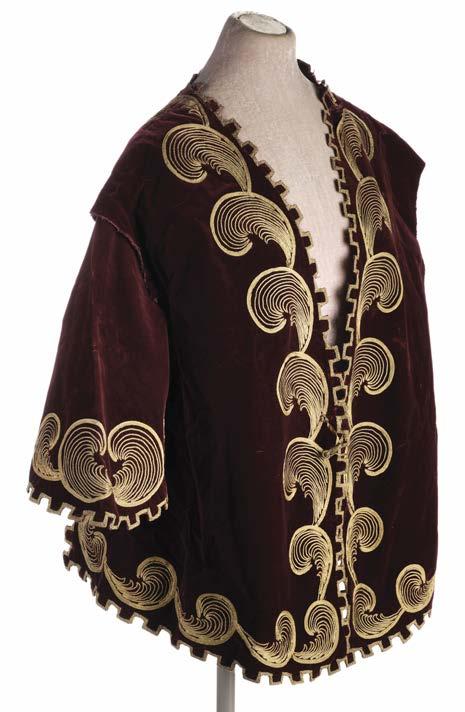
Each lot is subject to a Buyer’s Premium of 20% (Lots marked * 24% inclusive of VAT @ 20%)
The Irving Literary and Dramatic Club, otherwise known as The Irving Club, devoted its attention to the study of dramatic literature and orchestral music, holding meetings once a week.
Sir John Martin-Harvey (1863-1944) joined Henry Irving’s Lyceum Theatre company in 1882, and worked there for 14 years, often playing the lead role on tour that Irving had played in London. He took over the management of the Lyceum Theatre from Henry Irving in 1899. (2)
£200 - £400

785* Zardozi Panel. Needlework picture of the Taj Mahal, India, early 20th century, finely hand-stitched in gold and silver metallised threads and coloured silk threads, incorporating beads, using a variety of stitches, and partly padded in high relief, on a black silk ground, depicting the Taj Mahal fronted by a garden of stylised trees and plants, 50.5 x 49.5 cm (20 x 19.5 ins), set into original wooden frame (75 x 73.5 cm), elaborately hand-carved, with turned bobbin insertions, mother of pearl inlays, and bevelled glazing
An unusually large and skilfully executed needlework of the Taj Mahal, in an impressive frame. (1)
£200 - £300
Lot
786* Advertising Fan. Fan promoting the Carlton Hotel, illustrated by Georges Redon, Paris, 1913, folding paper fan, the chromolithograped leaf with illustration by Georges Redon depicting a bonnetted young lady sprinkling babies growing out of cabbages with a watering can, lettered on verso ‘Carlton Hôtel & Restaurant London’, mounted on carved wooden sticks, 23 cm (9 ins), together with another folding paper fan illustrated by Georges Redon, 1911, depicting a prim young lady seated on a sofa with a small dog, a young gentleman attempting to engage her in conversation, lettered on verso as above, mounted on wooden sticks, 24.5cm (9.5ins), plus 2 other advertising fans (Hatchetts Restaurant, Restaurant Laurens)
(4)
£70 - £100
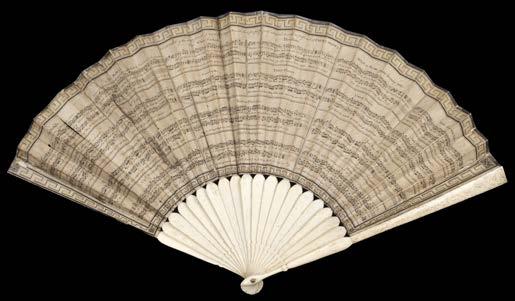

787* Dance Fan. Eighteen of the most favorite Country Dances, with their proper figures adapted to each, as performed at Court, Bath &c., circa 1790, folding paper fan, engraved with musical notation for various dances, including The Bastille, La Malbro., Union Dance, Lady Charles Spencer’s Fancy, Tartan Plaiddie, browned, splitting to folds and some tiny holes, with a few small losses to text, and various paper and adhesive tape repairs on verso, mounted on bone sticks, 24 cm (9.5 ins)
Not in the Schreiber Collection. One of the rarer dance fans; a version of it was sold in these rooms in 2011, with wooden sticks and imprint of ‘L. Sudlow, Fan Manufacturer, daughter of the late R. Delamotte, 191 Strand, Decr. 13th, 1789’.
(1)
£200 - £300
788* Etched Fans. Two early-mid 18th century hand-coloured etched fans, English, two folding paper fans, one depicting a rural genre scene, with a young lady seated on a ladderback chair in front of a rustic dwelling, conversing with a young gentleman leaning on a rock, another figure and a farmstead in the distance, browned, some rubbing and splitting to folds, small green paper repair to lower right on recto (2.5 x 3 cm), and paper-strengthening to verso, mounted on carved wooden sticks, guardsticks with handpainted chinoiserie decoration, including figures, 27.5 cm (11 ins), the other depicting the finding of Moses, with central group of figures, including a seated woman with a baby on her lap, flanked by other figures, one seated by a basket, with buildings and a shellshaped horse-drawn carriage in the background, browned, a few folds splitting (with some consequent repairs on verso to left-hand side), mounted on wooden sticks, 27 cm (10.75 ins)
Two rare early fans; we have been unable to trace either in collections or at auction.
(2)
£150 - £250
Lot 787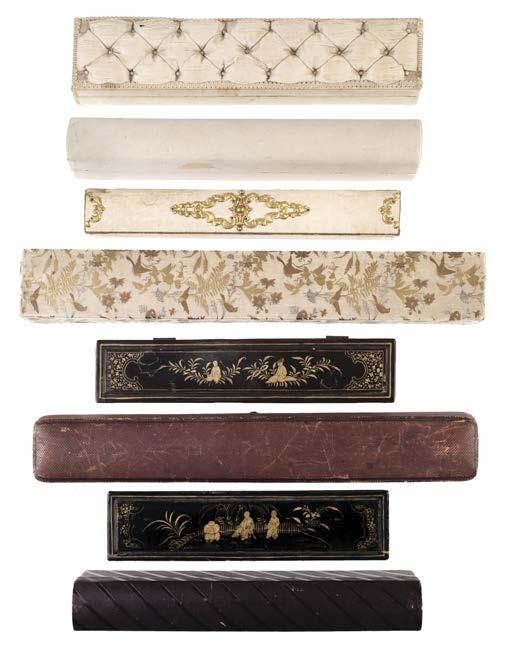



£300 - £400
789* Fan Boxes. A collection of fan boxes, 19th and early 20th century, 17 fan boxes, including: 2 Chinese black lacquered boxes decorated in gilt with figures and foliage, the pink silk interior of each with compartment to hold a fan, 18.5 cm (7.25 ins) and 23 cm (9 ins) long respectively, lacquer chipped in places, especially to base of smallest; a wooden box covered with embossed paper patterned with flowers, foliage, and birds, a little dusty and rubbed; 5 J. Duvelleroy boxes, one of burgundy diced sheep and lined with red velvet (rubbed and lid broken at front corners), each with trade name inside lid; a cream moiré silk box with ‘Tiffany & Cie’ embossed in gilt inside lid, frayed at edges; 2 cream silkcovered boxes with Faucon label or embossing inside lid, dust-soiled, one frayed at edges; a cream silk box with buttoned lid (a little frayed) bearing the gilt lettered pink label of Eugene Rimmel inside; and a cream figured paper box with yellow metal voluted cartouche on pull-off lid, various condition, 4.5 x 40.5 x 6 cm (1.75 x 16 x 2.25 ins) and smaller (17)
790* Fans. Four fans contained in two display cases, late 19th/early 20th century, first case with 3 fans, all mounted on mother of pearl sticks, comprising: a lace and gauze fan, hand-painted with a cupid in a butterfly chariot, small pencil attached with twisted cord, some splitting to folds, several sticks with repairs, 22 cm (8.75 ins); a lace fan, several sticks broken (some repairs), 24 cm (9.5 ins); and a small white ostrich feather fan, 24.5 cm (9.75 ins), the 3 mounted together with pins on pale blue velvet in a glazed gilt fan case (47.5 x 76.5 cm), and a hand-coloured lithographed fan with a scene of peasants and a donkey on a country lane, flanked by scenes of deities, with embossed gilt decoration on dark blue between, small closed tear to central scene, and some splitting to folds, filigree sticks, 26 cm (10.25 ins), stitch-mounted on blue velvet in a glazed gilt fan case (42.5 x 65.5 cm) (2)
Each lot is subject to a Buyer’s Premium of 20% (Lots marked * 24% inclusive of VAT @ 20%)
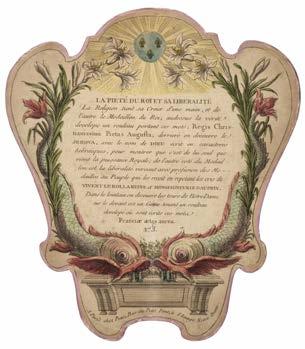
£100 - £200
Lot 790791* French Revolution Fan. Regis Christianissimi Pietas Augusta, Paris: Petit, Rue de Petit Pont, circa 1780, hand-coloured etched double-sided handscreen fan, the recto with a portrait medallion of Louis XVI held aloft by female deities, one holding a cross, and the other unloading a cornucopia to figures with outstretched arms below, a female figure within sunburst above, holding a banner bearing the words ‘Regis Christianissimi Pietas Augusta’, and a putto lower left with a scroll bearing the words ‘Franciæ Ætas Aurea’ and 3 fleur-de-lys, border of flowers and volutes, incorporating imprint at foot, verso with text titled ‘La Piété du Roi et Sa Libéralité, within a frame of winged fish entwined with madonna lilies, 3 fleur-de-lys above, and imprint at foot, a little dusty, and rubbed in places, lacking handle, 27 x 24 cm (10.5 x 9.5 ins)
793* Japanese Empire Fan. WWI Japanese fan with autograph signatures of military figures, folding paper fan, both sides of leaf with signatures in sepia ink, some in Japanese, including Tetsutarō Satō, Rear Admiral J. Matsumura, Kenji Ide, K. Murakami, Tomosaburō Katō, Rokurō Yashiro, Hayao Shimamura, lightly toned, 2 pin holes to lower edge, one very small stain to upper edge of one side, the other side slightly frayed in a few places to lower edge, mounted on bamboo sticks, 23 cm (9 ins)
A unique fan, with signatures of various important Japanese military and government personnel, including a number of Imperial naval admirals, such as Marshal-Admiral Viscount Katō Tomosaburō (1861-1923) who was Prime Minister of Japan from 1922 to 1923. (1)
£100 - £150
An extremely rare propaganda fan published by Petit, who was active during the second half of the 18th century; we have been unable to trace another such at auction or in an institution. With textual and visual references to the piety of the King, his liberality, and the golden age over which he reigned, the scarcity of this fan can hardly be surprising given that succeeding events in France would have made it a dangerous object to own. (1)
£300 - £500

792* Historical Fan. View of the Trial of Warren Hastings Esq. at Westminster Hall, [Publish’d as the Act directs by Cock & Co. No. 36 Snow Hill Septr 22nd,] 1788, engraved folding paper fan, the leaf with large interior scene of a crowded Westminster Hall printed in brown, imprint to lower edge worn (with archival tape repair on verso) and only date legible, flanked by ovals providing a key to the main figures, the ovals suspended from beribboned portrait medallions of young girls, the central scene and the ovals edged with spangles, the whole on a black diaper ground, mounted on wooden sticks, upper guardstick with ‘Feb 12th 1788’ written in ink in an early hand, 25.5 cm (10 ins), contained in a green-morocco grain paper-covered fan box with pull-off lid (larger than fan)
Schreiber Collection 7, p.3 (1)
£300 - £500


794* Japanese Fans. A collection of Japanese fans, early 20th century, 8 folding paper fans, 7 colour-printed, comprising: a ceremonial fan depicting figures and banners lined up in front of steps leading up to a large building; a fan depicting a large industrial scene with warehouses and tall smoking chimneys, with 2 medallion portraits of gentlemen above, and a map of Japan on the verso, lightly toned in places; 4 souvenir fans (‘Welcome H.M.S. “Eclipse” Yokosuka machi June 1902’, tiny nick in lower edge; ‘Souvenir of Visit to Yenoshima and Kamakura 1912’, a little dusty in places; ‘Souvenir Seamen’s Rest June 1906’, slightly rubbed and toned, one fold splitting; and ‘Daibutsu at Kamakura’, toned, 1 small closed tear, some splitting of folds to edges, and a couple of small adhesive tape stains); and a pictorial fan depicting an oriental gentleman in a boat, and a monochrome fan with portraits of 8 women forming part of a musical group, captioned with their names, a couple of minor losses to lower edge on recto, all mounted on wooden sticks, 27 cm (10.5 ins) and slightly smaller (8)
£100 - £200
Lot 793795* Movable Silhouette Fans. A pair of etched fans with movable figures, Paris: Alphonse Giroux, circa 1820s, 2 cardboard handscreen fans, each of elongated octagonal form, with central recessed oval covered by cream gauze (foxed) revealing 2 movable black scissorcut silhouette figures, operated by a paper tab on reverse, one depicting a pair of male figures fencing, the other a woman holding a broom and parrying with a man brandishing fire tongs and shovel, the latter with tab renewed, each within a matching hand-coloured etched border, depicting a young lady and gentleman in evening dress on the left, the latter carrying a shawl over his arm, and on the right a woman carrying a reticule and a gentleman carrying an umbrella, both couples at the top of a flight of steps, with a pair of female Oriental figures in gold seated atop the oval, carrying a jester’s stick and parasol respectively, and below, acting as caryatids, a pair of seated male Oriental figures in green highlighted in gilt, reverse of each with narrow green borders etched with scrolling trefoil pattern, second fan with Giroux’s engraved lab el to upper edge ‘Rue du Coq St. Honoré No. 7’, both sides of each with narrow gold paper edging, turned wooden handles, both lacking upper rivet, each 37.5 x 24.5 cm (14.75 x 9.75 ins)
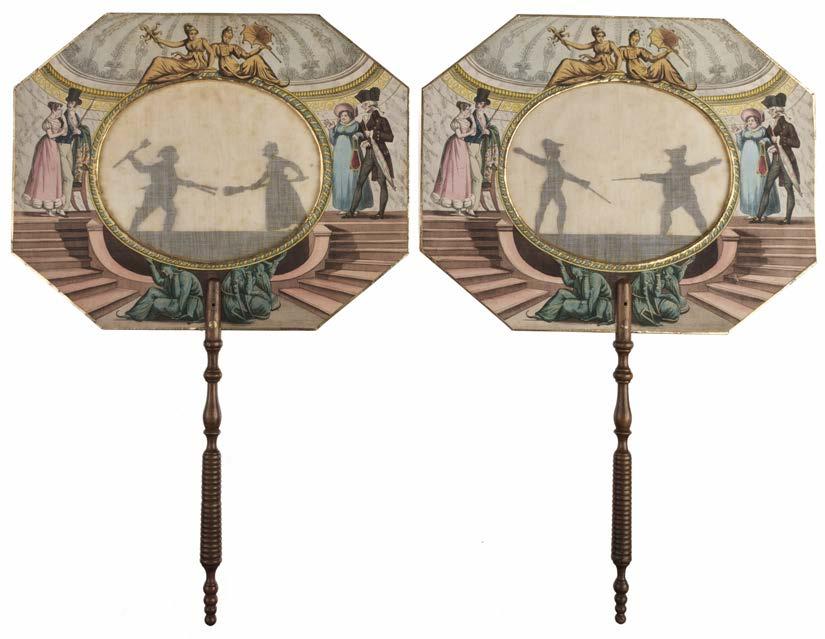
A wonderful pair of articulated fans surviving in very good condition and in working order. Extremely rare; we have not seen another such movable fan, nor have we traced any at auction or in institutions.
lphonse Giroux, known as 'the merchant of the princes', was an important Parisian manufacturer of luxury furniture and objets d'art, whose products were intended for the upper echelons of society. He was operating from 7, Rue de Coq St. Honoré as early as 1799, before moving to Boulevard des Capucines in the middle of the 19th century, and he counted royalty among his clients, including King Louis XVIII and King Charles X. Spe cialising in paper and artistic supplies, and known for his offering of both modern and old fans, he sold a hugely diverse range of wares, including toys, boxes, souvenirs, lithographs, mirrors, clocks, sewing accessories, fabrics, and items of furniture. Giroux had studied painting under Jacques-Louis David, and he not only collected, exhibited and sold fine art, but he offered a conservation service also, becoming involved in such prestigious projects as the restoration of Notre Dame Cathedral. The firm of Giroux showcased its wares widely at world fairs and exhibitions, and won a number of medals.
Alphonse Giroux was in the vanguard of the production of pre-cinema movable devices and photography in Europe at the beginning of the 19th century. In 1818 he filed the patent for the kaleidoscope, which he also called the 'transfigurator'. In June 1833 Alphonse Giroux & Cie. introduced the phénakistiscope in France, becoming one of the first companies to publish the animation device after it was more or less simultaneously invented in Belgium and Austria. His firm also constructed the Giroux Daguerreotype camera in 1839, the first commercially manufactured photographic camera in the world, which was designed by his brother-in-law Louis Daguerre.
(2)

Each lot is subject to a Buyer’s Premium of 20% (Lots marked * 24% inclusive of VAT @ 20%)
£1,500 - £2,000
796* Oracle Fan. A fortune-telling fan, circa 1800, folding paper fan, the leaf etched with a wheel of fortune on the recto (with pinpricks from use), with two winged figures in clouds above, and explanations on how to consult the oracle, the verso with ten circular portraits of Greek and Roman deities, each with a statement of fortune below, toned, some splitting to folds, worn to left and right edges and lower edge, with loss and crude repairs (not affecting image or text), mounted on wooden sticks, 25.5 cm (10 ins)
Schreiber Collection 200, p. 97, uncoloured and unmounted (see also 64, p.13 for similar, but with imprint of Cock & Crowder dated 1800). A fan to aid ladies’ amusement in the drawing room, designed so that one could divine answers to such questions as ‘Whether one is to inherit an Estate’, ‘Whether a Match will succeed’ and ‘What sort of a Husband she will have’. (1) £100 - £150

797* Painted Fan. A late Victorian painted brisé fan, by E. Kees, hand-painted double-sided bone fan, the recto bearing a pastoral scene of youthful figures in 18th century dress, a young boy and girl on the left dancing, and another couple seated on the right beneath a tree, a church spire seen against a sunset sky on the left, and the sweeping stone steps of a garden on the right, the vignette flanked by a flower urn on the left and a quiver of arrows in the right, and surrounded by rose garlands, verso with crossed beacons in the centre flanked by rose garlands and surrounded by butterflies, upper guardstick signed in brown ink on verso ‘E. Kees’, 19 cm (7.5 ins), contained, together with small engraved calling card of Marjorie Mercer Kendig, in a cream silk fan box (larger than fan), dusty, extremities fraying
(1)
798* Silhouette Fan. A hand-painted Regency silhouette fan, circa 1810-1820, brown cardboard handscreen fan with pedimented and voluted upper edge, painted in black with numerous small full-length silhouettes of ladies and gentlemen seated or standing in groups conversing, some playing cards, a number of the ladies carrying fans, and the gentlemen each carrying a chapeau bras, with Empire style crystal ballroom chandelier hanging above and tasselled drapes either side within shaped upper edge, a few light marks, reverse lined with brown morocco-grain paper (some small losses to lower edge), both sides with narrow border of gold paper (missing in places), turned wooden handle, 38.5 x 26.5 cm (15.25 x 10.5 ins)
A unique fan, surviving in very good condition. The figures have something of the air of caricature about them, with their pointed chins and noses; especially so the gentlemen who strut around and, rather comically, each carry a chapeau bras, or arm hat, the collapsible bicorne hat which was part of a Regency gentleman’s evening ensemble, designed to be carried under the arm, rather than worn.
(1)
£500 - £800

£200 - £300 Lot

799* Theatre Fan. La Reconnaissance de Figaro, 1780s, folding paper fan, the hand-coloured etched leaf with central oval scene from Pierre Beaumarchais’s Le Mariage de Figaro, depicting a gentleman, lady, and young lady, in an interior flanked by further figures, titled above and with 2 stanzas of verse either side, toned, text rubbed and faint in places, splitting to folds (repaired on verso), mounted on wooden sticks, 28 cm (11 ins)
Schreiber Catalogue 202, p. 42.
A scarce French Revolutionary period fan; we have traced only one other at auction.
Written in 1778, in the years before the French Revolution, Beaumarchais’s play was the basis for Mozart’s famous opera The Marriage of Figaro, which was premiered in 1786. The story reflected the growing dissatisfaction with the ruling class, and was considered scandalous at the time due to its depiction of an incompetent and hedonistic nobleman being outwitted by his servant. As a result the play was banned in many cities, including Vienna, where Mozart was based at the court of Emperor Joseph II. In order to gain approval from the Emperor to use such a controversial subject for a new opera, Mozart’s librettist, Lorenzo Da Ponte, had to tone down and remove the most provocative parts, most notably replacing Figaro’s rant about the nobility in Act IV with a tirade against the inconstancy of women. The script was approved and Mozart completed the music in just six weeks.
(1)
£100 - £200
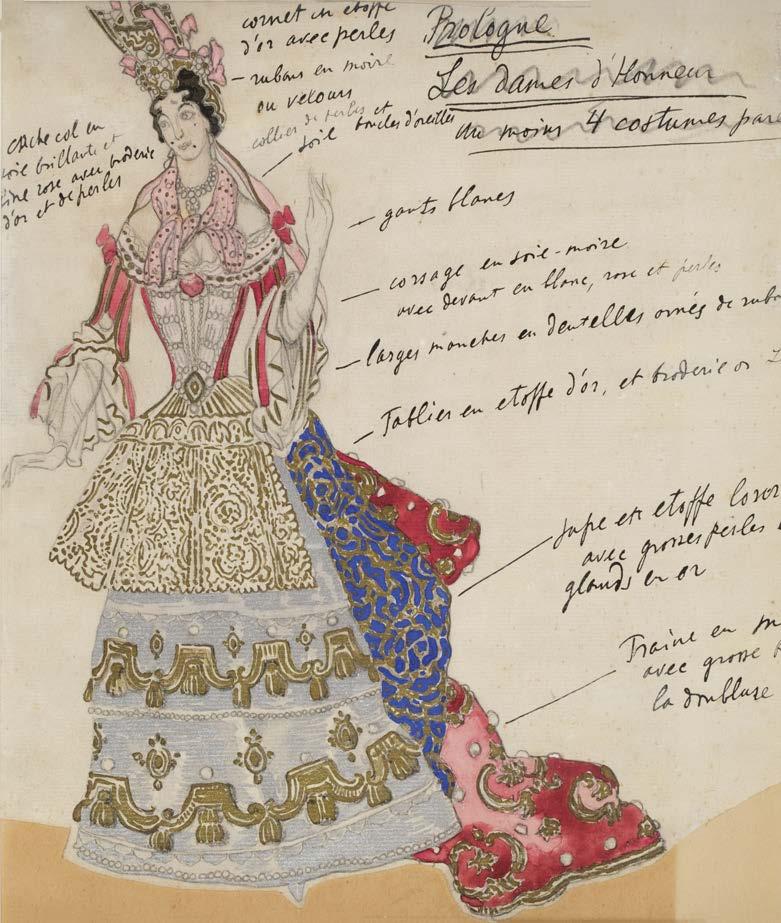
Léon Bakst (1866-1924). Costume design for the ballet La Belle au Bois Dormant: Une Dame de Cour, 1921, pencil and watercolour, heightened with gold and silver, on pale cream laid paper, with extensive annotations in black ink by the artist, lower margin trimmed irregularly near the design shape, 285 x 240 mm (11 1/4 x 9 1/2 ins) mount aperture, modern silver aluminium box frame, glazed, with annotations in black ink by Richard Edmonds to verso
Already seriously ill, Léon Bakst was asked to work on the Ballets Russes production of The Sleeping Princess by Serge Diaghilev in 1920. The Sleeping Princess, with choreography based on Marius Petipa's 1890 production with new additions by Bronislava Nijinska, was the finest classical ballet in the Ballets Russes's repertoire and premiered at the Alhambra Theatre, Leicester Square, London on the 2nd November 1921, running until 4th February 2022.
Estimate £5000-8000
For further information please contact Rachael Richardson, Edmund Saddington, or Nathan Winter: info@dominicwinter.co.uk
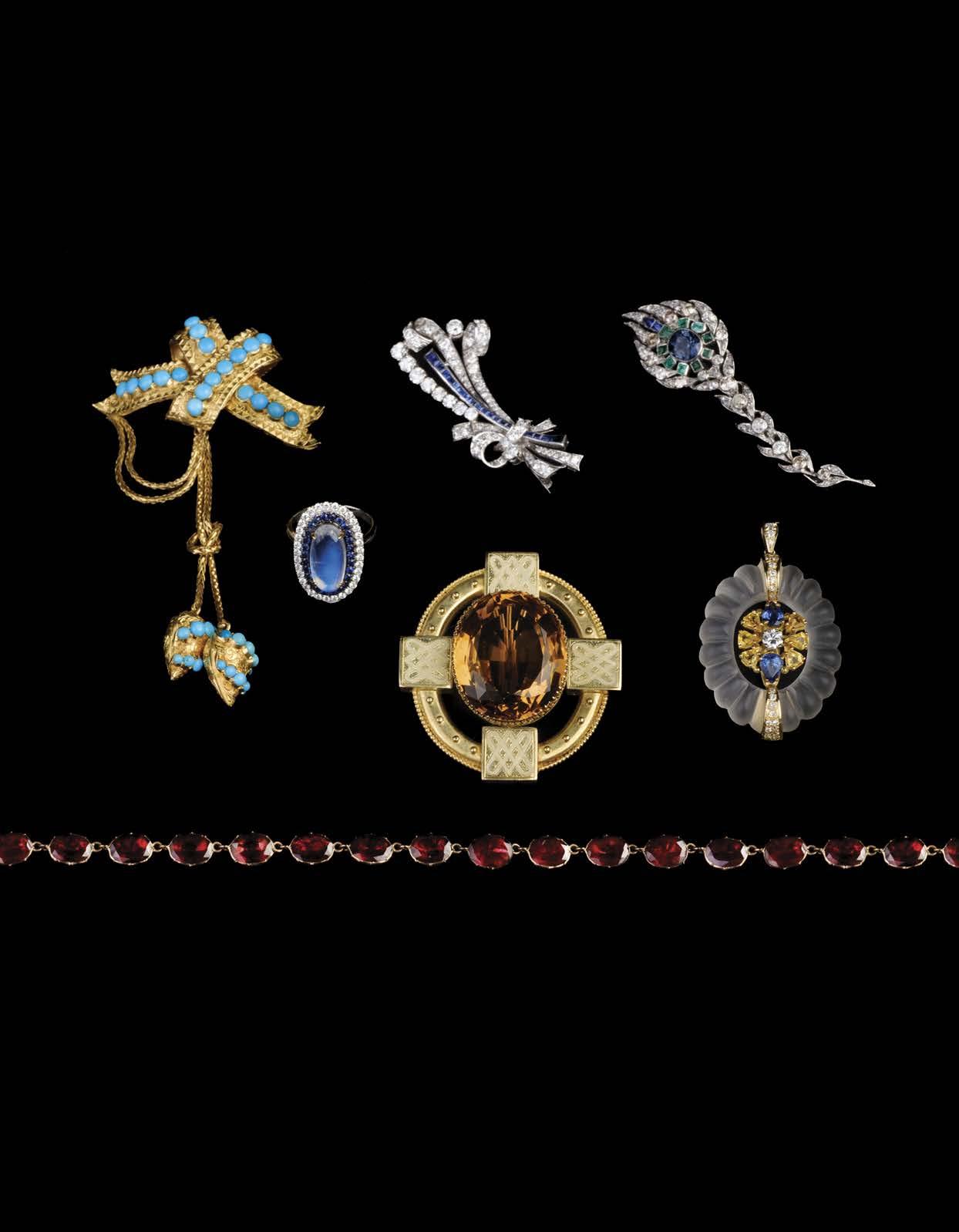
Moonstone, sapphire and diamond 18ct white gold cluster ring
Estimate £500-£800
Sapphire and diamond platinum spray brooch
Estimate £600-£800
Spinel, sapphire, emerald and diamond white metal brooch
Estimate £500-£800
Turquoise yellow metal ribbon and bow pendant brooch
Estimate £600-£800
For further information please contact Henry Meadows: henry@dominicwinter.co.uk
Diamond, sapphire and rock crystal 18ct yellow gold pendant
Estimate £400-£600
Victorian citrine enamelled unmarked yellow metal brooch
Estimate £200-£400
Georgian garnet riviere rose gold necklace
Estimate £500-£800
Online Results: If you weren’t present or able to follow the auction live, you can find results for the sale on our website shortly after the sale has ended.
Payment: The price you pay is the amount at which the auctioneer’s hammer falls (the hammer price), plus a buyer’s premium (a percentage of the final hammer price) and vat where applicable. You will be issued with an invoice made out to the name and address provided on your registration form.
Please note successful bids made via live bidding cannot be invoiced or paid for until the day after an auction. A live bidding fee of 3% + VAT (Dominic Winter / Invaluable) or 4.95% + VAT (the-saleroom) will be added to your invoice.
Cheque: Cheques will only be accepted on the day of the sale by prior arrangement (please contact our office for further information). Cheques by post will be accepted but a period of 5 working days will be required for the cheque to clear before purchases can be collected or posted.
Cash: Payments can be made at the Cashier’s Office, either during or after the sale.
Debit Card: There is no additional charge for purchases made with debit cards in the UK.
Credit Cards: We accept Visa and Mastercard. It is advisable to let your card provider know in advance if you are intending to purchase. This reduces the time needed to obtain authorisation when the payment is made.
Bank Transfer: All transfers must state the relevant invoice number. If transferring from a foreign currency, the amount we receive must be the total due after the currency conversion and the deduction of any bank charges.
Note to Overseas Clients: All payments must be made by bank transfer only. No card payments will be accepted unless by special prior arrangements with the auctioneers.
Collection/Postage/Delivery: If you attend the auction in person and are successful in your bid, you are free to collect your item once payment has been made.
Successful commission or live bids will be invoiced to you the day after the sale. When it is possible for our in-house packing department to send your purchase(s), a charge for postage/packing/insurance will be included in your invoice. Where it is not possible for our in-house packing department to send your item you will be required to make your own arrangements or to contact Mailboxes etc (tel: 01793 525009) or Pack and Send (tel: 01635 887237) who may be able to help.
We provide a monthly delivery service to Central London, usually on Wednesday of the week following an auction. Payment must be received before this option can be requested. A charge will be added to your invoice for this service.
Lots marked with AR next to the lot number may be subject to Droit de Suite.
Droit de Suite is payable on the hammer price of any artwork sold in the lifetime of the artist, or within 70 years of the artist's death. The buyer agrees to pay Dominic Winter Auctioneers Ltd. an amount equal to the resale royalty and we will pay such amount to the artist's collecting agent. Resale royalty applies where the Hammer price is 1,000 Euros or more and the amount cannot be more than 12,500 Euros per lot.
The amount is calculated as follows:
Royalty For the Portion of the Hammer Price (in Euros)
4.00% up to 50,000
3.00% between 50,000.01 and 200,000
1.00% between 200,000.01 and 350,000
0.50% between 350,000.01 and 500,000
Invoices will, as usual, be issued in Pounds Sterling. For the purposes of calculating the resale royalty the Pounds Sterling/Euro rate of exchange will be the European Central Bank reference rate on the day of the sale.
Please refer to the DACS website www.dacs.org.uk and the Artists’ Collecting Society website www.artistscollectingsociety.org for further details.
Libraries & Archives
Nathan Winter & Chris Albury
Paintings & Prints
Nathan Winter
Antiques & Furniture
Henry Meadows
Medals & Militaria
Henry Meadows
Aviation & Transport Collections
Chris Albury & Henry Meadows
Atlases, Maps & Prints
John Trevers
Antiquarian Books
Colin Meays
Modern First Editions
Paul Rasti
Children's Books, Toys & Games
Susanna Winters
Sports Books & Memorabilia
Paul Rasti
Taxidermy, Fossils & Field Sports
John Trevers
Vintage Photography & Cinema
Chris Albury
Manuscripts, Autographs & Ephemera
Chris Albury

1. The Seller warrants to the Auctioneer and the buyer that he is the true owner or is properly authorised to sell the property by the true owner and is able to transfer good and marketable title to the property free from any third party claims.
2. (a) The highest bidder to be the buyer. If during the auction the Auctioneer considers that a dispute has arisen he has absolute authority to settle it or re-offer the lot. The Auctioneer may at his sole discretion determine the advance of bidding or refuse a bid, divide any lot, combine any two or more lots or withdraw any lot without prior notice.
(b) Where goods are bought at auction by a buyer who has entered into an agreement with another or others that the other or others (or some of them) shall abstain from bidding for the goods and the buyer or other party or one of the other parties is a dealer (as defined in the Auction Biddings Agreement Act 1927) the buyer warrants that the goods are bought bona fide on joint account.
3. The buyer shall pay the price at which a lot is knocked down by the Auctioneer to the buyer (“the hammer price”) together with a premium of 20% of the hammer price. Where the lot is marked by an asterisk the premium will be subject to VAT at 20% which under the Auctioneer’s Margin Scheme will form part of the buyer’s premium on our invoice and will not be separately identified (the premium added to the hammer price will hereafter collectively be referred to as “the total sum due”). By making any bid the buyer acknowledges that his attention has been drawn to the fact that on the sale of any lot the Auctioneer will receive from the seller commission at its usual rates in addition to the said premium of 20% and assents to the Auctioneer receiving the said commission.
4. (a) The buyer shall forthwith upon the purchase give in his name and permanent address and pay to the Auctioneer immediately after the conclusion of the auction the total sum due.
(b) The buyer may be required to pay down during the course of the sale the whole or any part of the total sum due, and if he fails to do so after such request the lot or lots may at the Auctioneer's absolute discretion be put up again and resold immediately.
(c) The buyer shall at his own expense take away any lot or lots purchased no later than five working days after the auction day.
(d) The Auctioneer may at his own discretion agree credit terms with a buyer and extend the time limits for collection in special cases but otherwise payment shall be deemed to have been made only after the Auctioneer has received cash or a sterling banker’s draft or the buyer's cheque has been cleared.
5. (a) If the buyer fails to pay for or take away any lot or lots pursuant to clause 4 or breaches any other condition of that clause the Auctioneer as agent for the seller shall be entitled after consultation with the seller to exercise one or other of the following rights:
(i) Rescind the sale of that or any other lots sold to the buyer who defaults and re-sell the lot or lots whereupon the defaulting buyer shall pay to the Auctioneer any shortfall between the proceeds of that sale after deduction of costs of re-sale and the total sum due. Any surplus shall belong to the seller.
(ii) Proceed for damages for breach of contract.
(b) Without prejudice to the Auctioneer's rights hereunder if any lots or lots are not collected within five days or such longer period as the Auctioneer may have agreed otherwise, the Auctioneer may charge the buyer a storage charge of £1.00 + VAT at the current rate per lot per day.
(c) Ownership of the lot purchased shall not pass to the buyer until he has paid to the Auctioneer the total sum due.
6. (a) The seller shall be entitled to place a reserve on any lot and the Auctioneer shall have the right to bid on behalf of the seller for any lot on which a reserve has been placed. A seller may not bid on any lot on which a reserve has been placed.
(b) Where any lot fails to sell, the Auctioneer shall notify the seller accordingly. The seller shall make arrangements either to re-offer the lot for sale or to collect the lot and may be asked to pay a commission not exceeding 50% of the selling commission and any special expenses incurred in cataloguing the lot.
(c) If such arrangements are not made within seven days of the notification the Auctioneer is empowered to sell the lot by auction or by private treaty at not less than the reserve price and to receive from the seller the normal selling commission and special expenses.
7. Any representation or statement by the Auctioneer in any catalogue, brochure or advertisement of forthcoming sales as to authorship, attribution, genuineness, origin, date, age, provenance, condition or estimated selling price is a statement of opinion only. Every person interested should exercise and rely on his own judgement as to such matters and neither the Auctioneer nor his servants or agents are responsible for the correctness of such opinions. No warranty whatsoever is given by the Auctioneer or the seller in respect of any lot and any express or implied warranties are hereby excluded.
8. (a) Notwithstanding any other terms of these conditions, if within fourteen days of the sale the Auctioneer has received from the buyer of any lot notice in writing that in his view the lot is a deliberate forgery and within fourteen days after such notification the buyer returns the same to the Auctioneer in the same condition as at the time of the sale and satisfies the Auctioneer that considered in the light of the entry in the catalogue the lot is a deliberate forgery then the sale of the lot will be rescinded and the purchase price of the same refunded. "A deliberate forgery" means a lot made with intention to deceive. (b) A buyer's claim under this condition shall be limited to any amount paid to the Auctioneer for the lot and for the purpose of this condition the buyer shall be the person to whom the original invoice was made out by the Auctioneer.
9. Lots may be removed during the sale after full settlement in accordance with 4(d) hereof.
10. All goods delivered to the Auctioneer's premises will be deemed to be delivered for sale by auction unless otherwise stated in writing and will be catalogued and sold at the Auctioneer's discretion and accepted by the Auctioneer subject to all these conditions. In the case of miscellaneous books, the Auctioneer reserves the right to extract and dispose of books that, in the opinion of the Auctioneer at his absolute discretion, have no saleable value and, therefore, might detract from the saleability of the rest of the lot and the Auctioneer shall incur no liability to the seller, in respect of the books disposed of. By delivering the goods to theAuctioneer for inclusion in his auction sales each seller acknowledges that he/she accepts and agrees to all the conditions.
11. (a) Unless otherwise instructed in writing all goods on the Auctioneer's premises and in their custody will be held insured against the risks of fire, burglary, water damage and accidental breakage or damage. The value of the goods so covered will be the hammer price, or in the case of unsold lots the lower estimate, or in the case of loss or damage prior to the sale that which the specialised staff of the Auctioneer shall in their absolute discretion estimate to be the auction value of such goods.
(b) The Auctioneer shall not be responsible for damage to or the loss, theft, or destruction of any goods not so insured because of the owner’s written instructions.
12. The Auctioneer shall remit the proceeds of the sale to the seller thirty days after the day of the auction provided that the Auctioneer has received the total sum due from the buyer. In all other cases the Auctioneer will remit the proceeds of the sale to the seller within seven days of the receipt by the Auctioneer of the total sum due. The Auctioneer will not be deemed to have received the total sum due until after any cheque delivered by the buyer has been cleared. In the event of the Auctioneer exercising his right to rescind the sale his obligation to the seller hereunder lapses.
13. In the case of the seller withdrawing instructions to the Auctioneer to sell any lot or lots, the Auctioneer may charge a fee of 12.5% of the Auctioneer's middle estimate of the auction price of the lot withdrawn together with Value Added Tax thereon and any expenses incurred in respect of the lot or lots.
14. The Auctioneer’s current standard notices and information (i.e. Collation and Amendments) will apply to any contract with the Auctioneer as if incorporated herein.
15. These conditions shall be governed by and construed in accordance with English Law.
